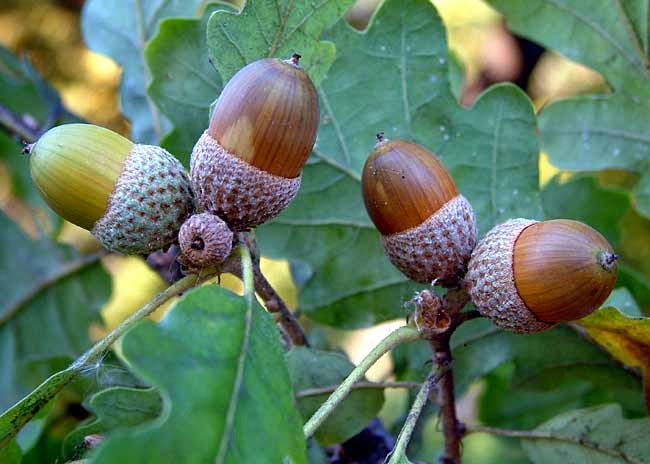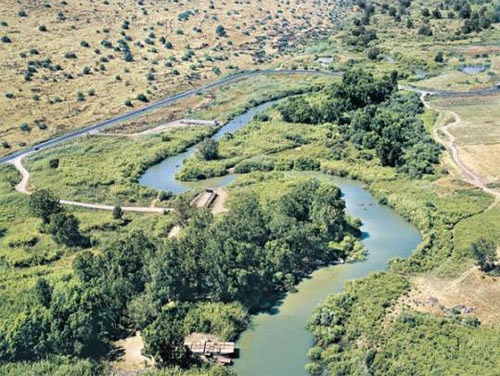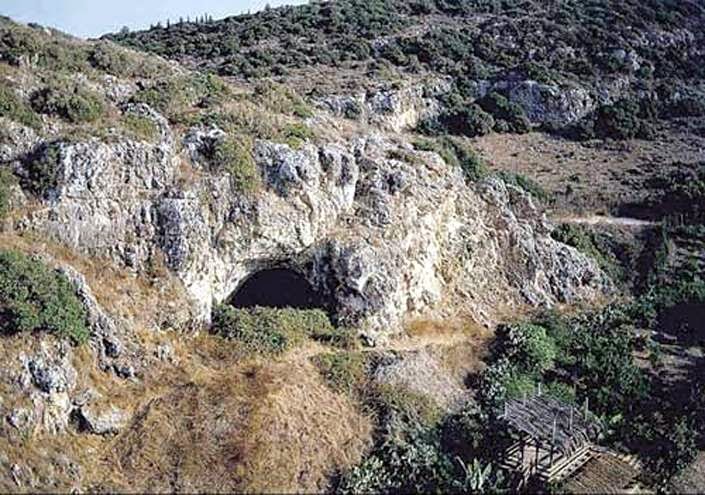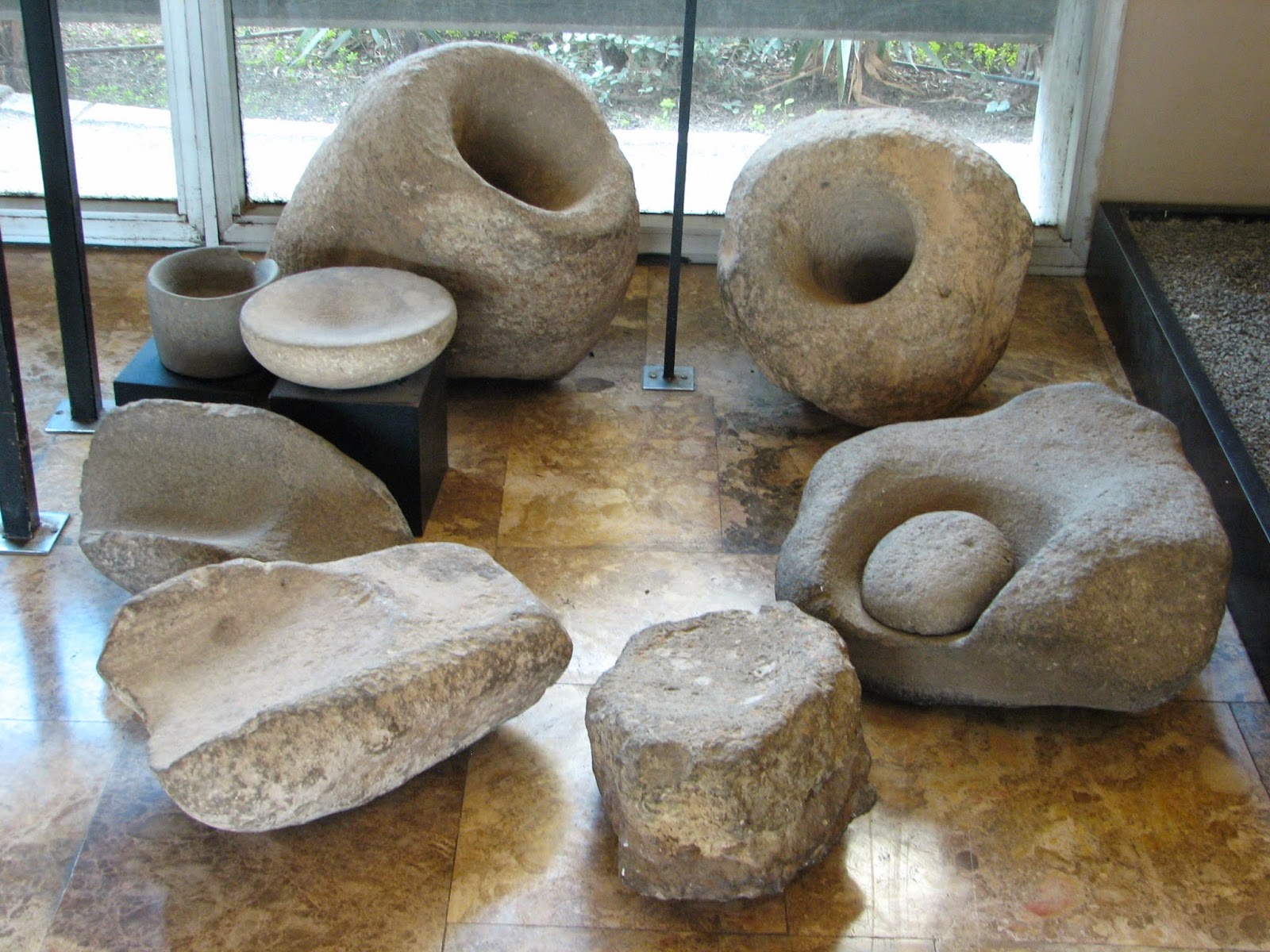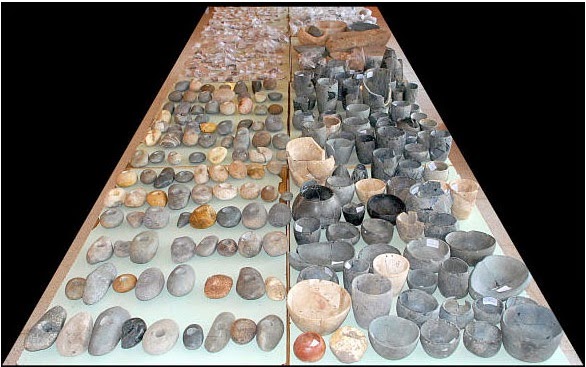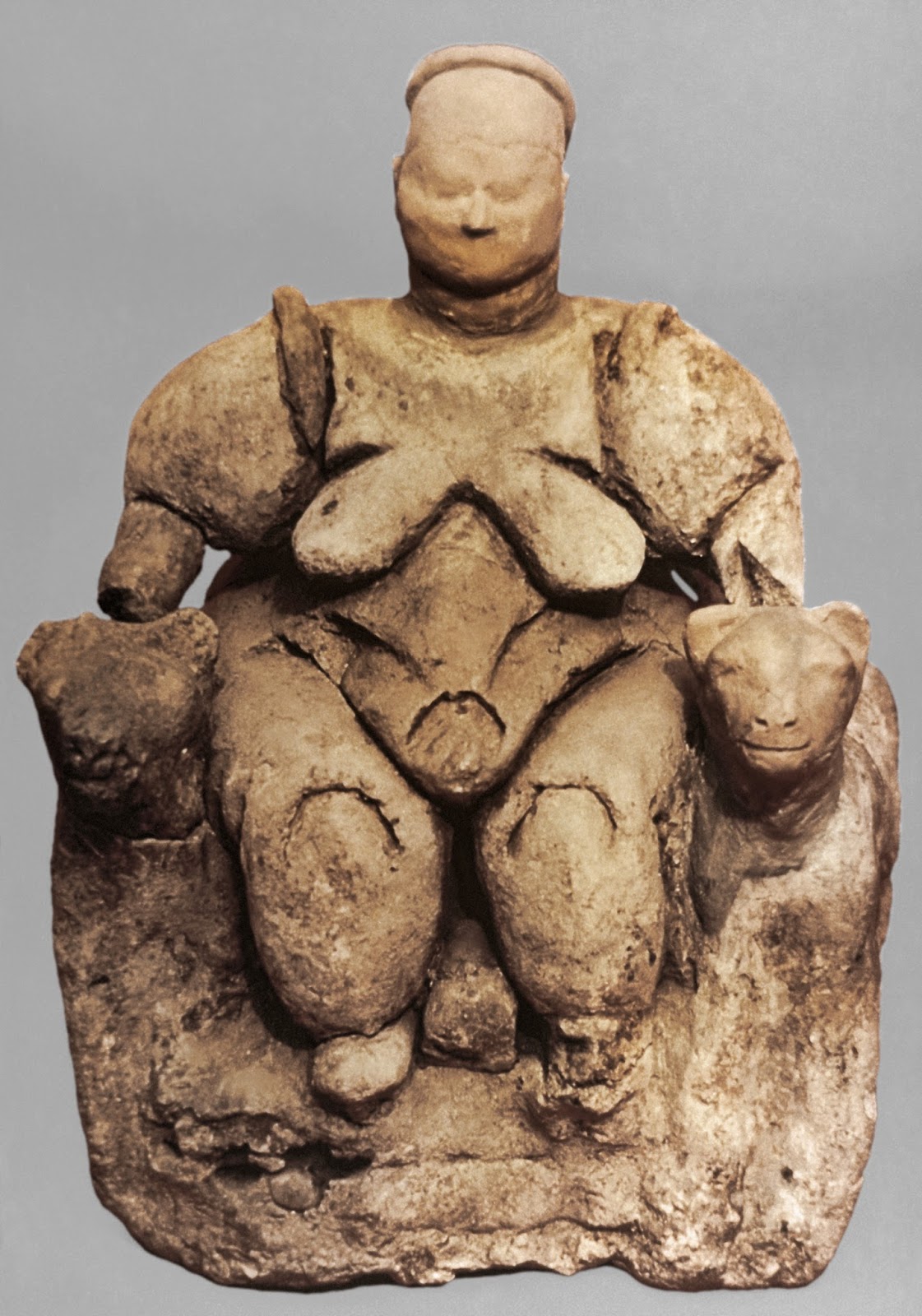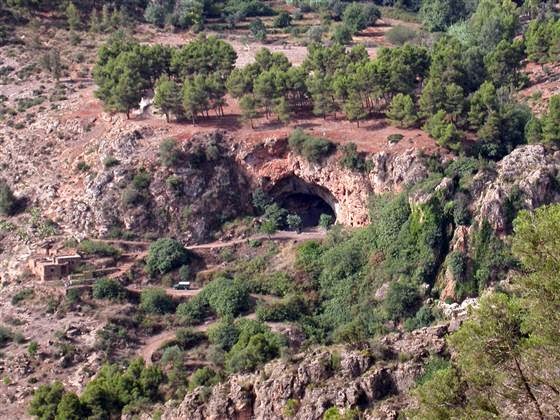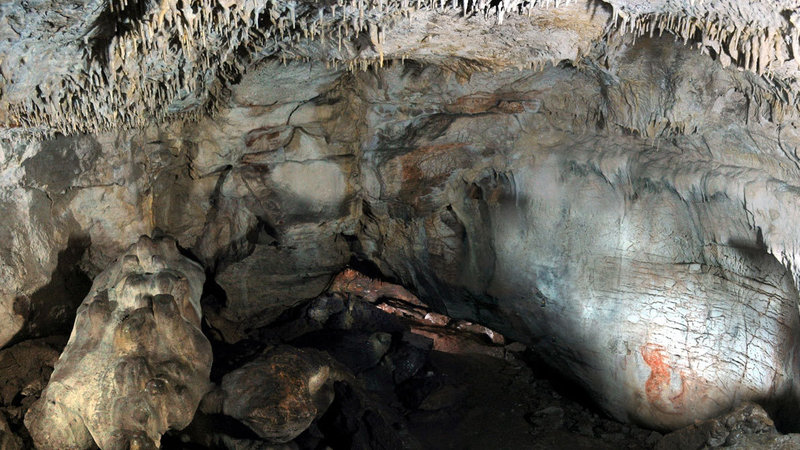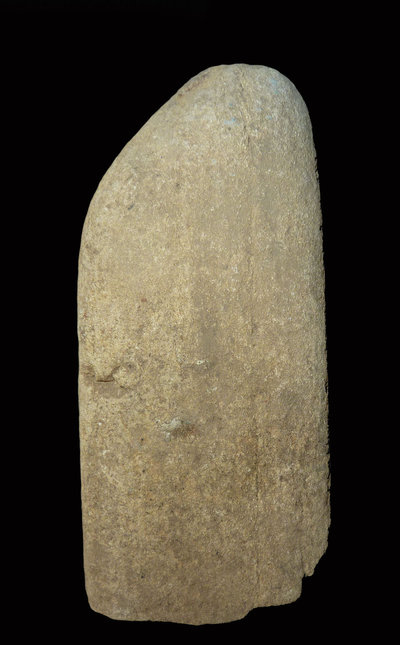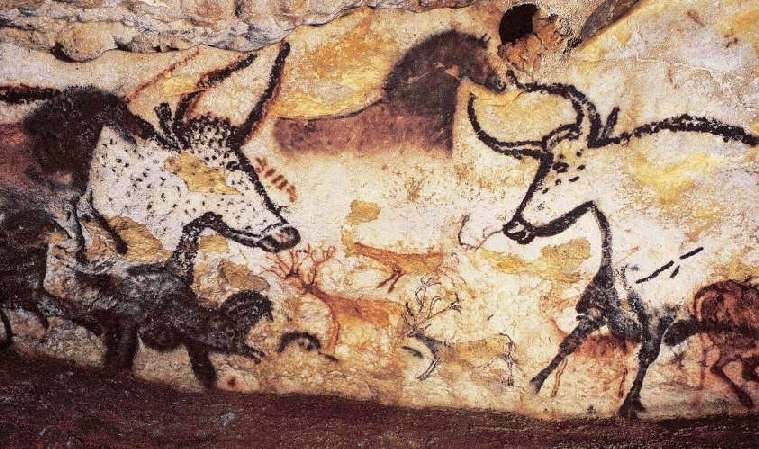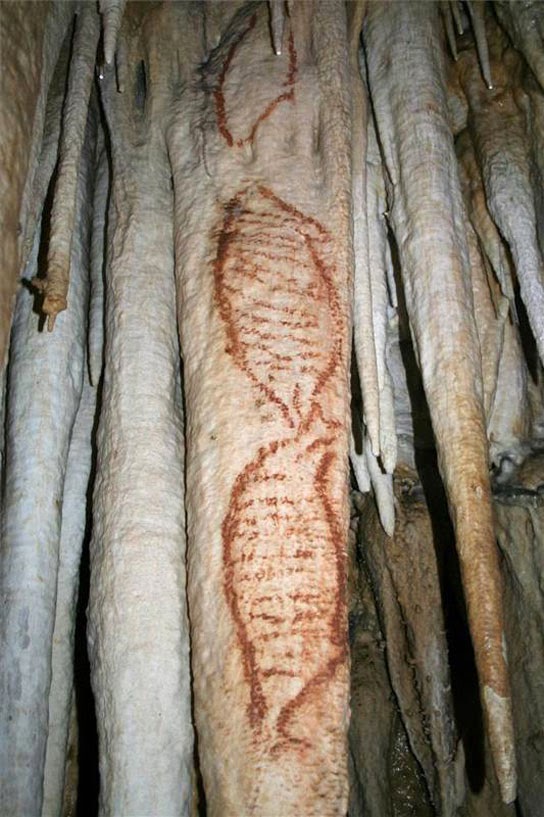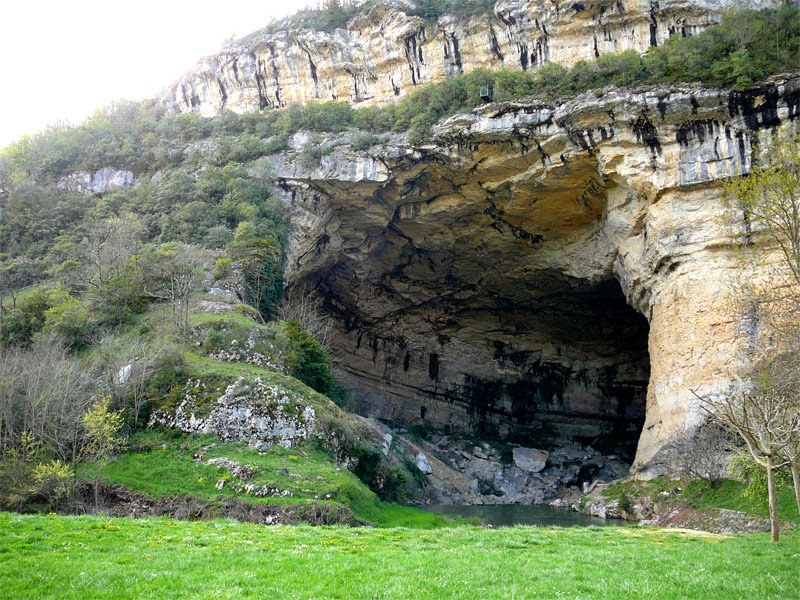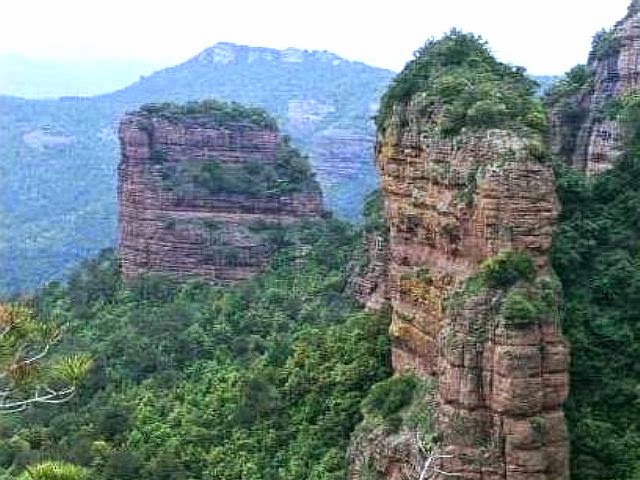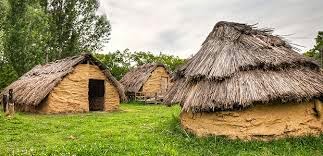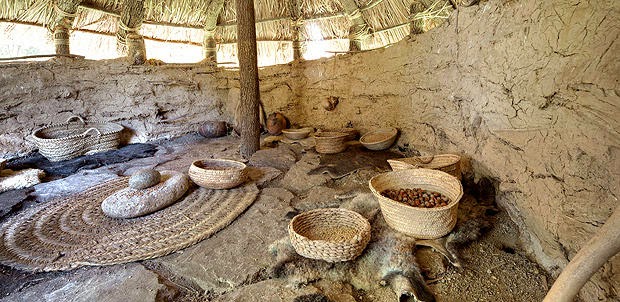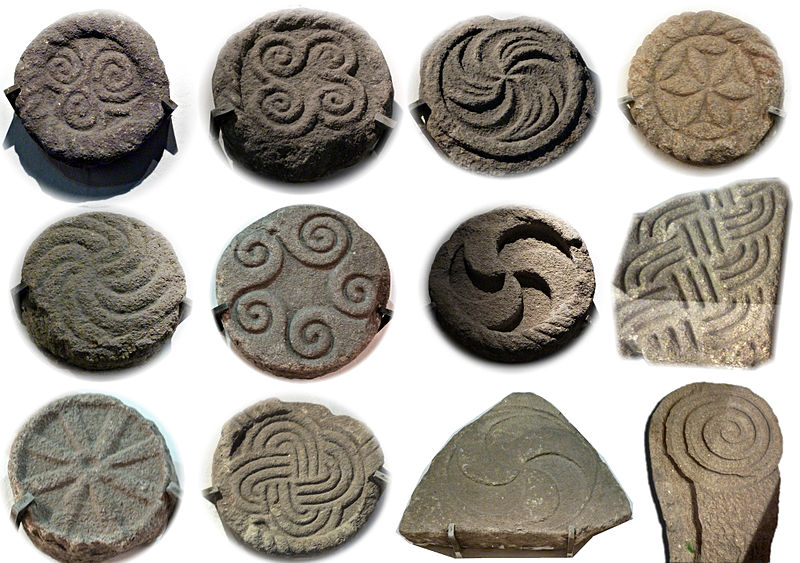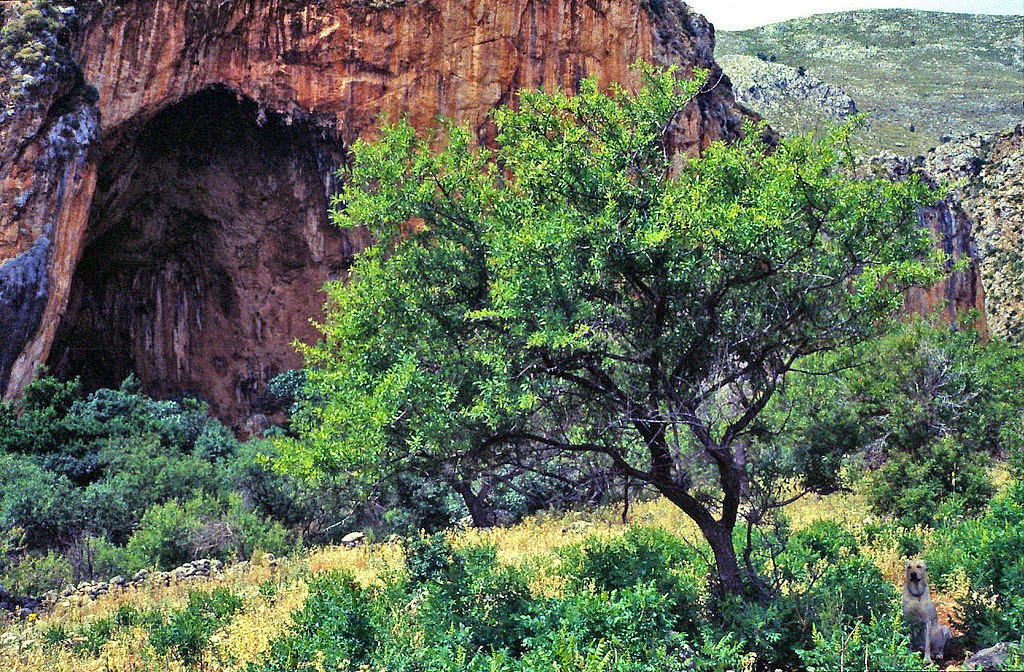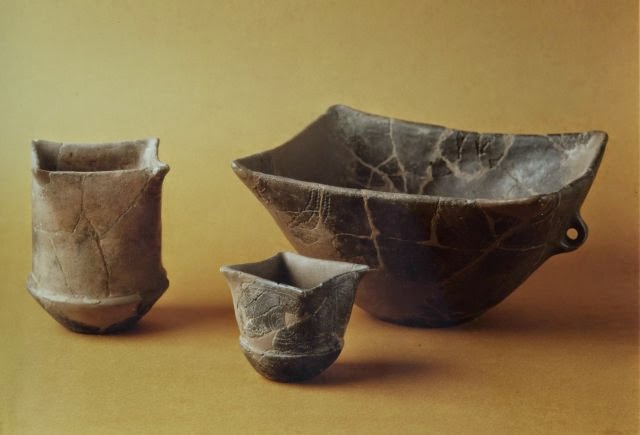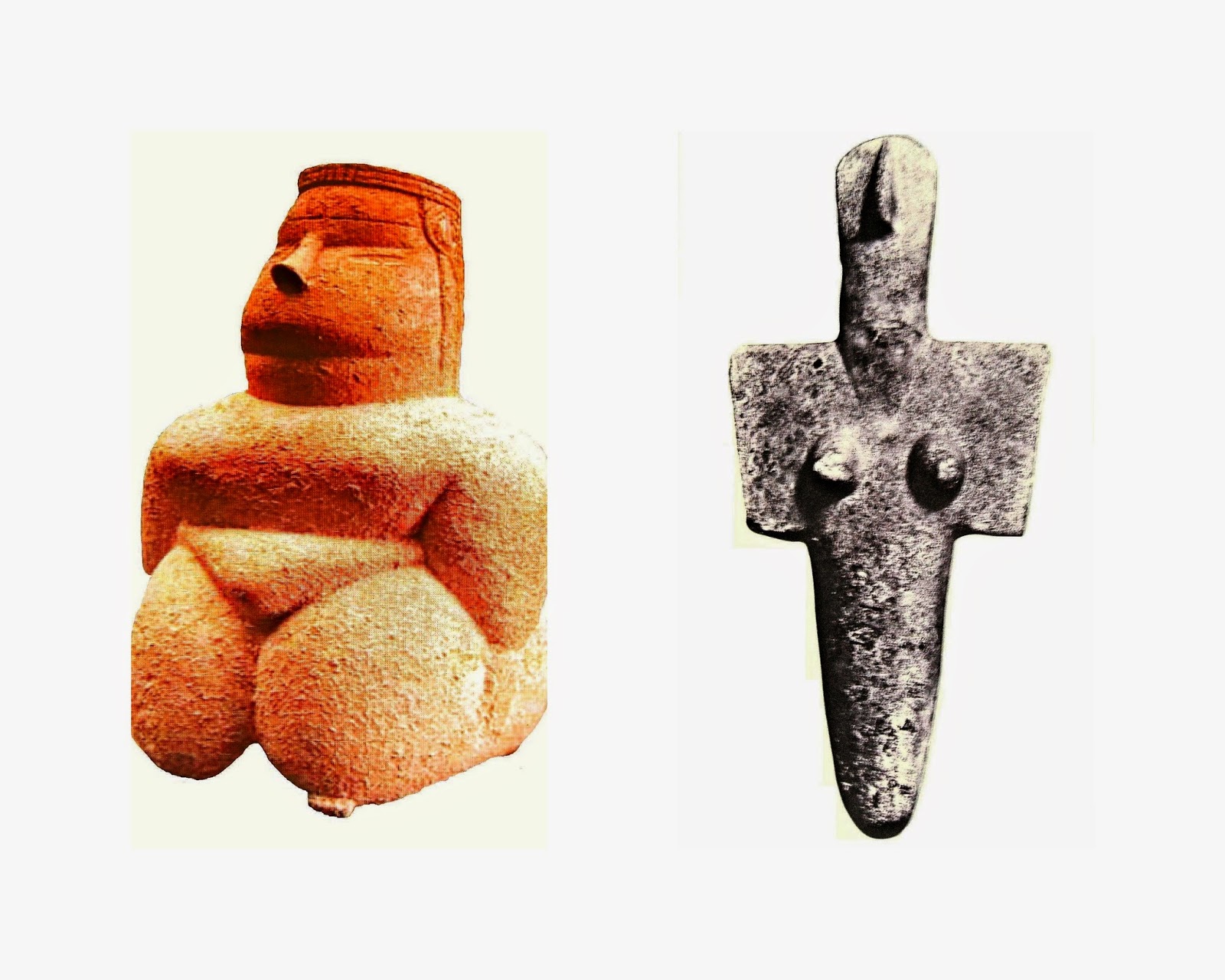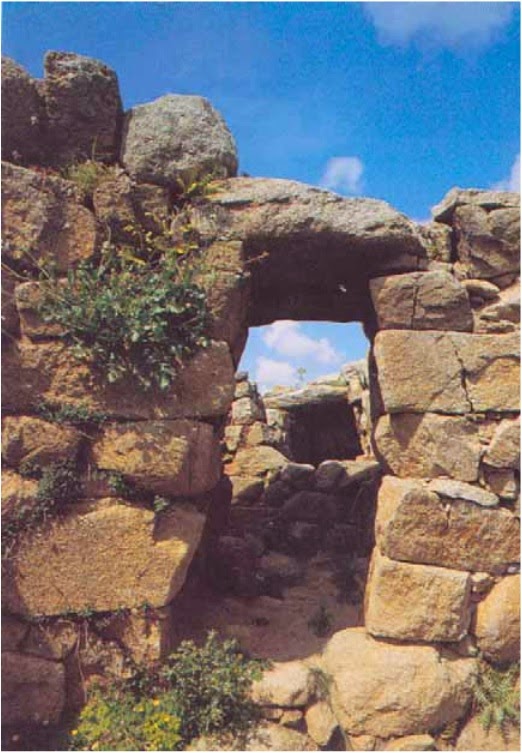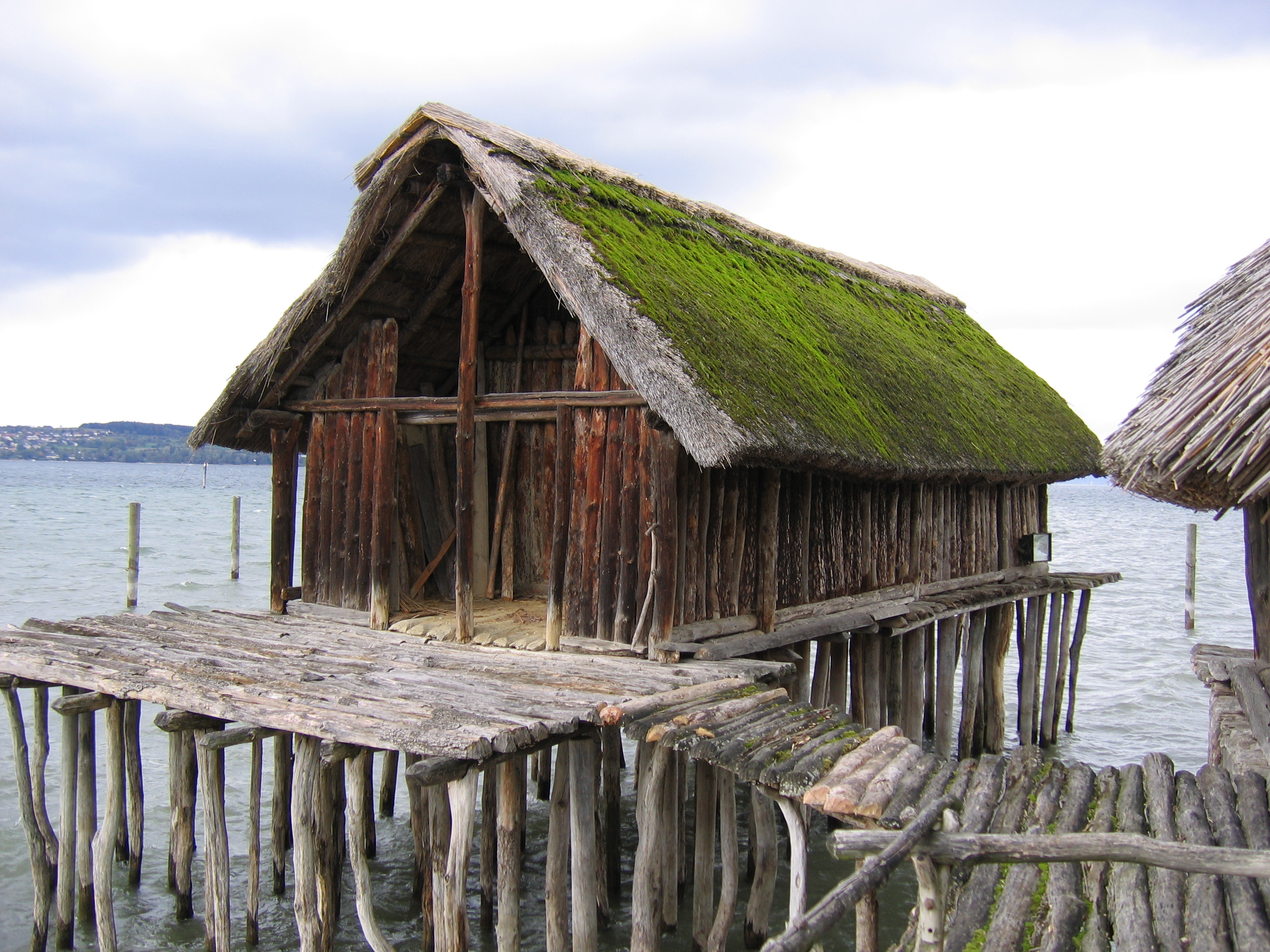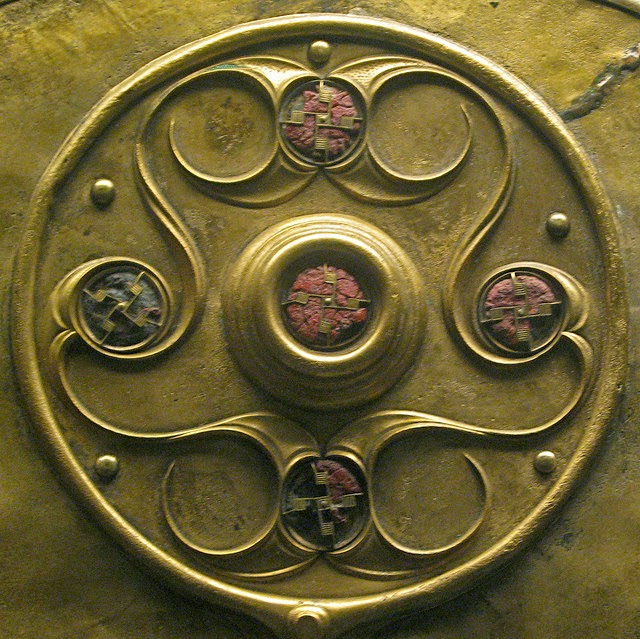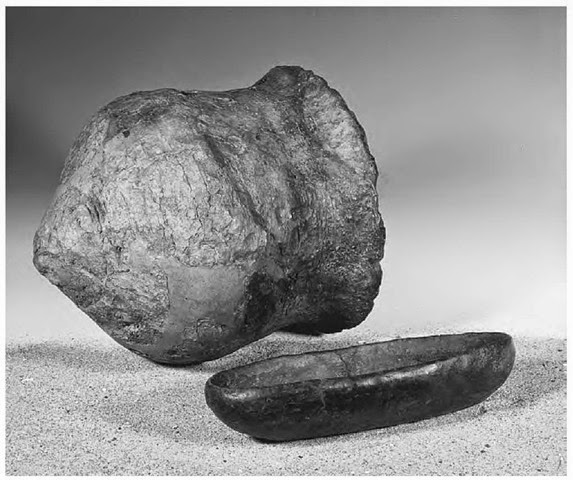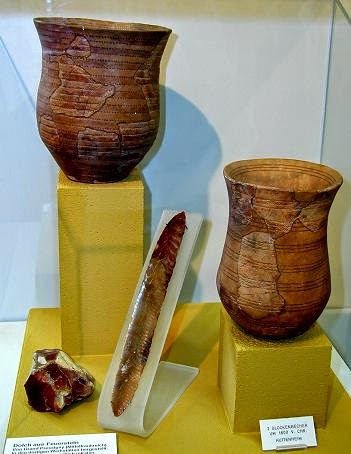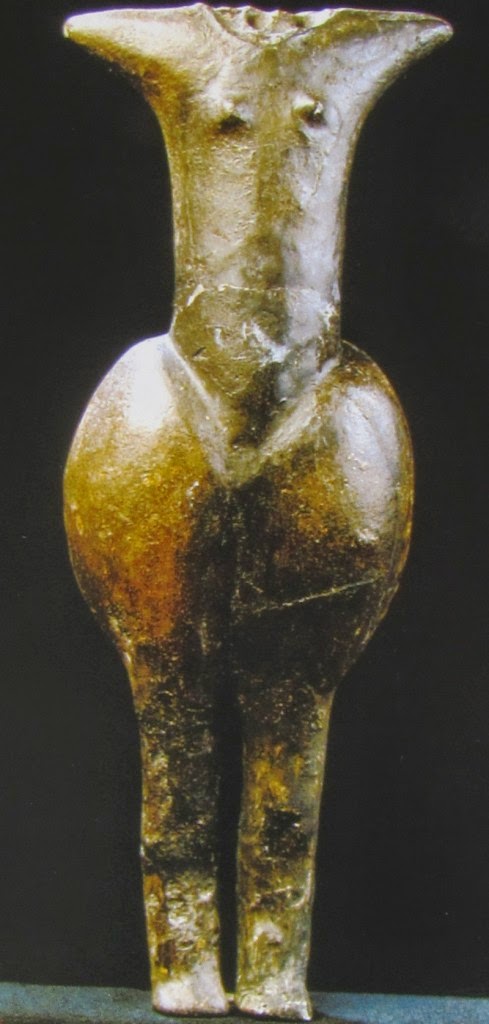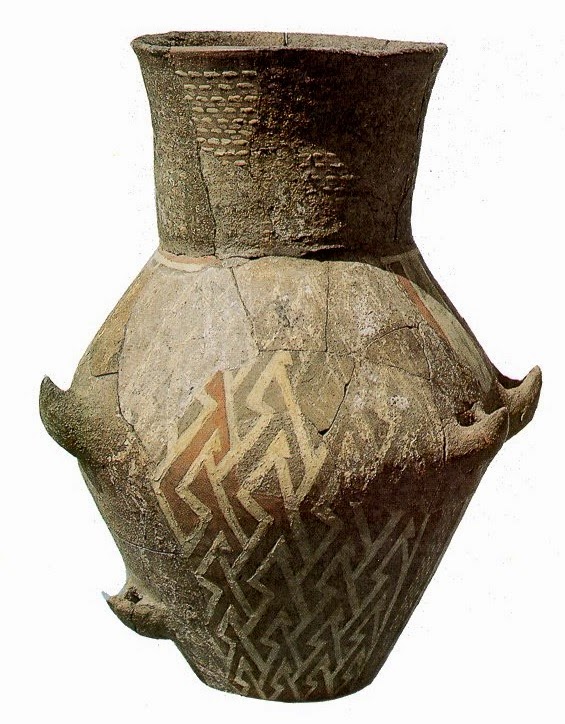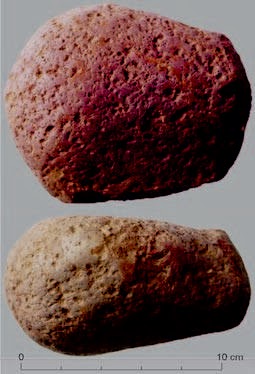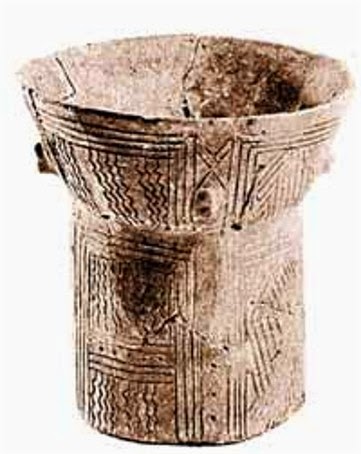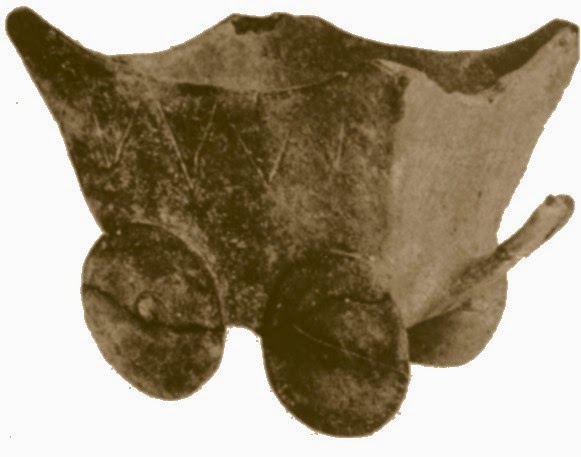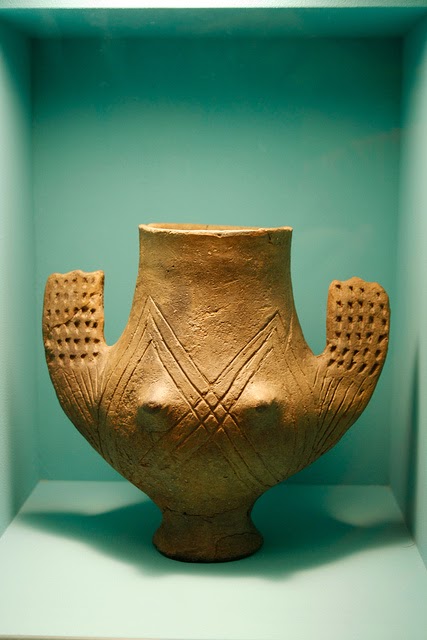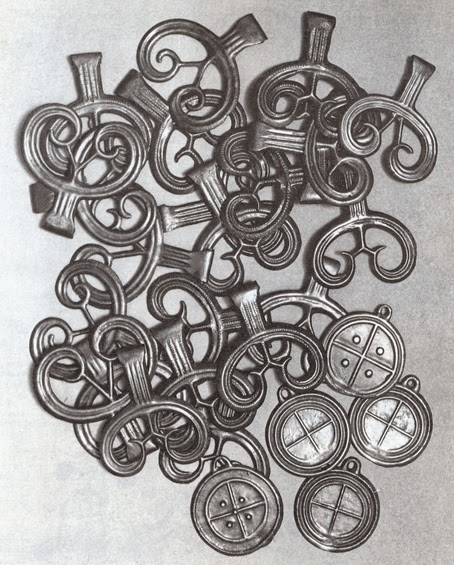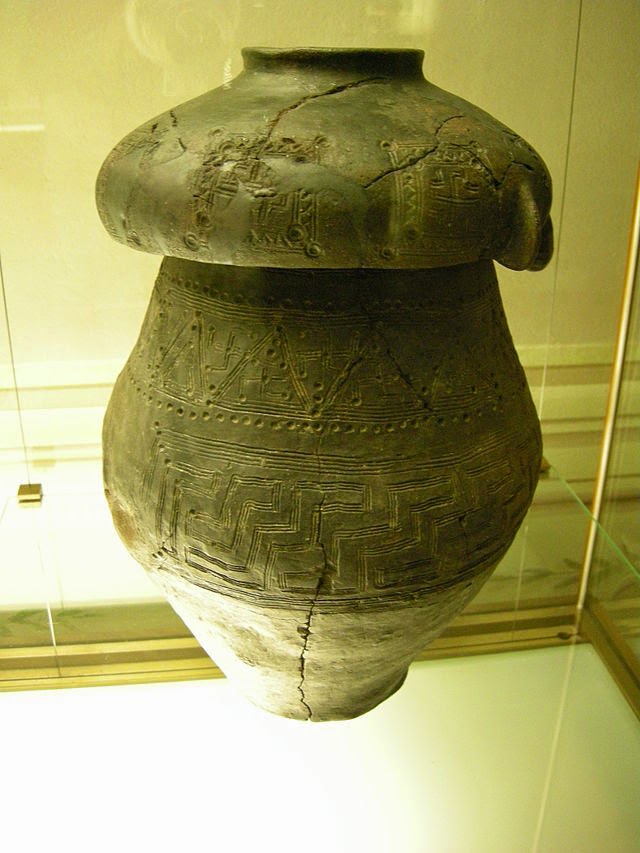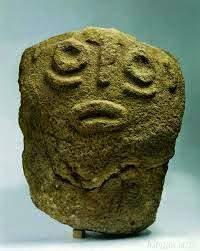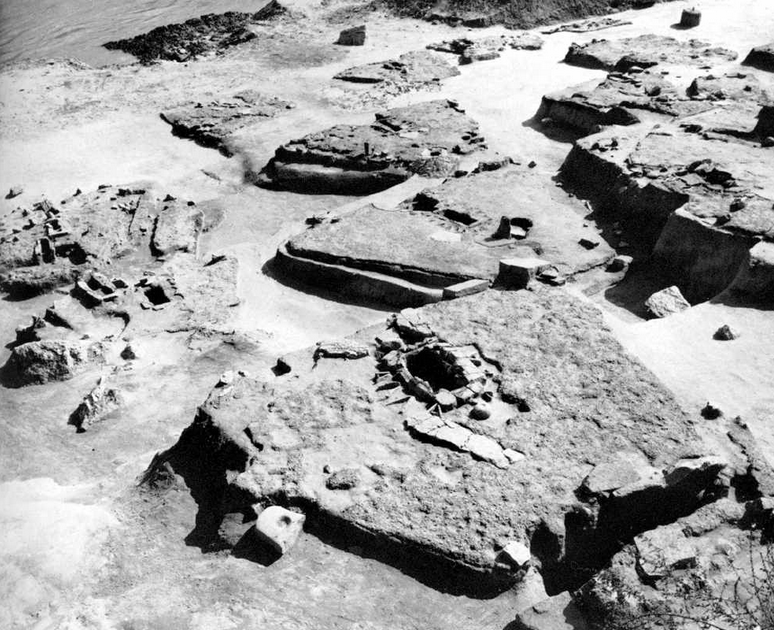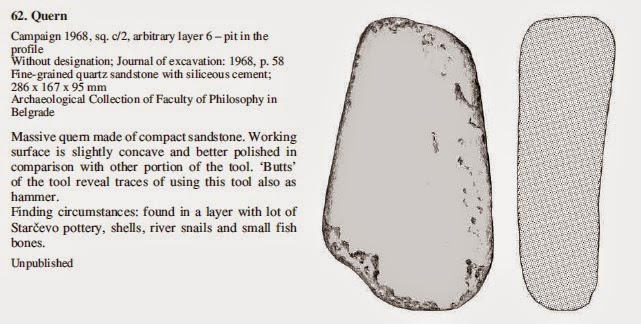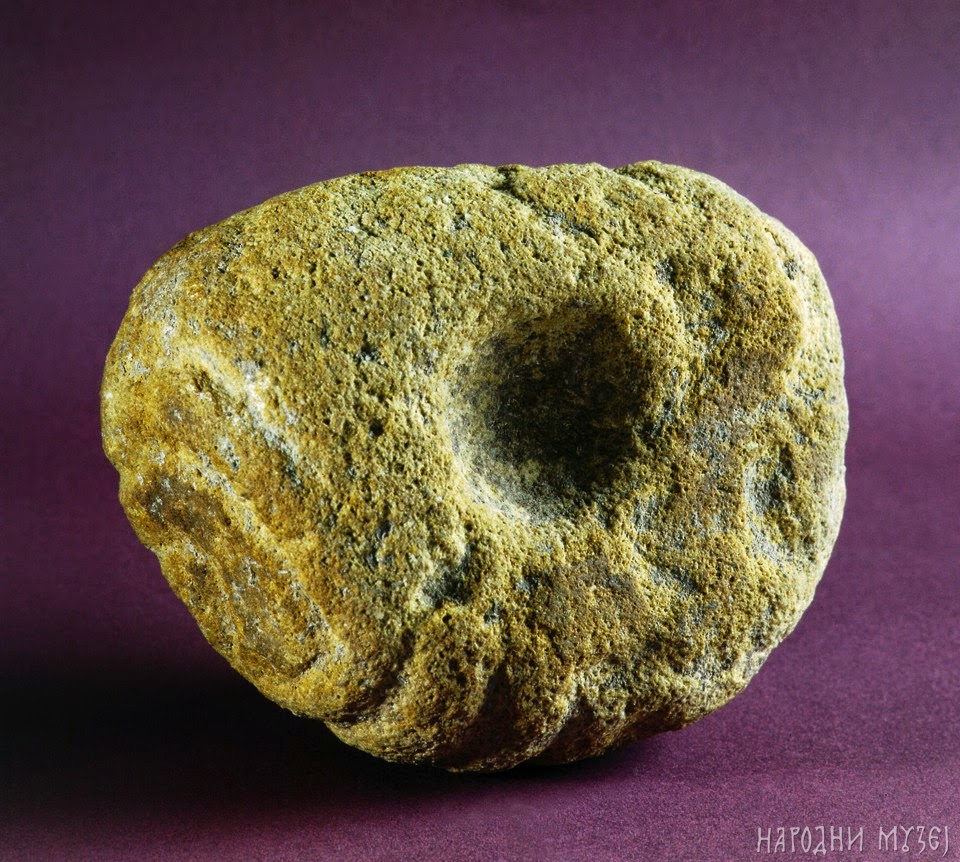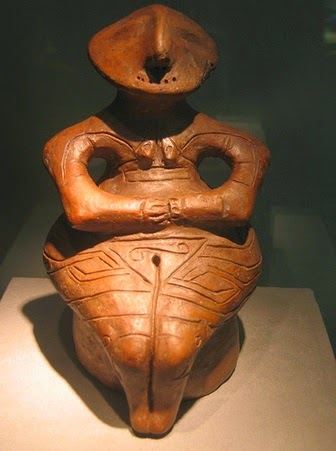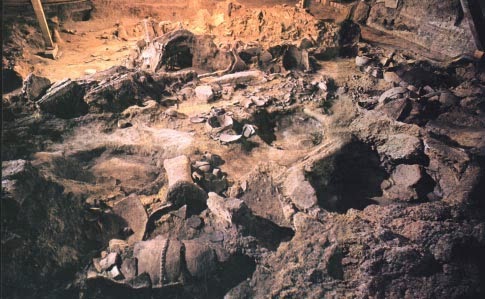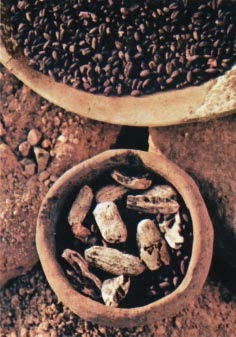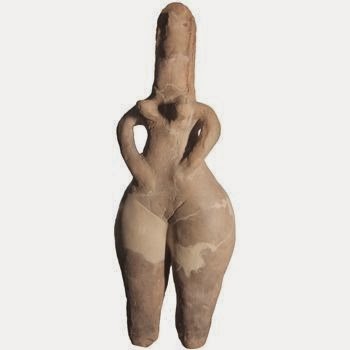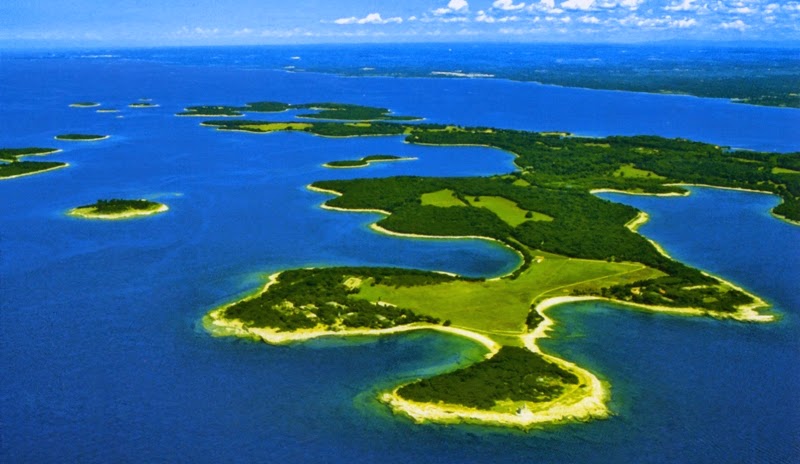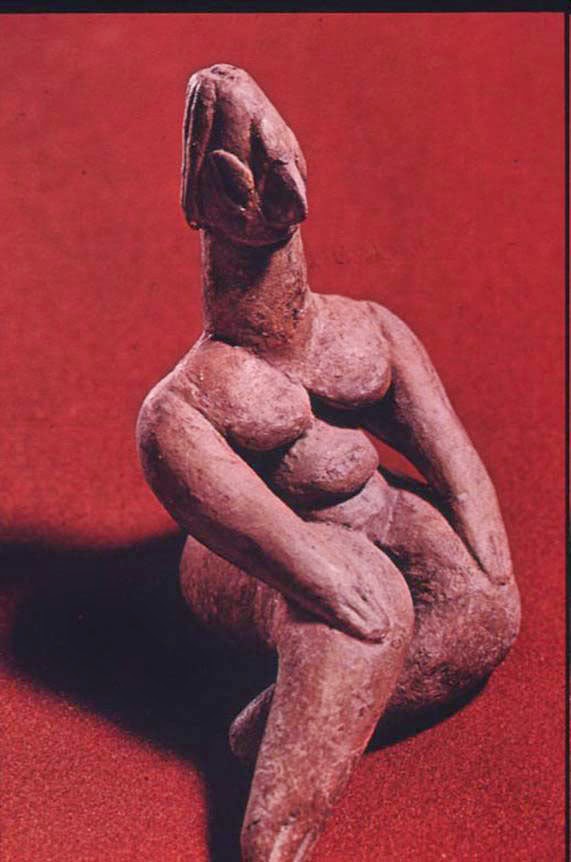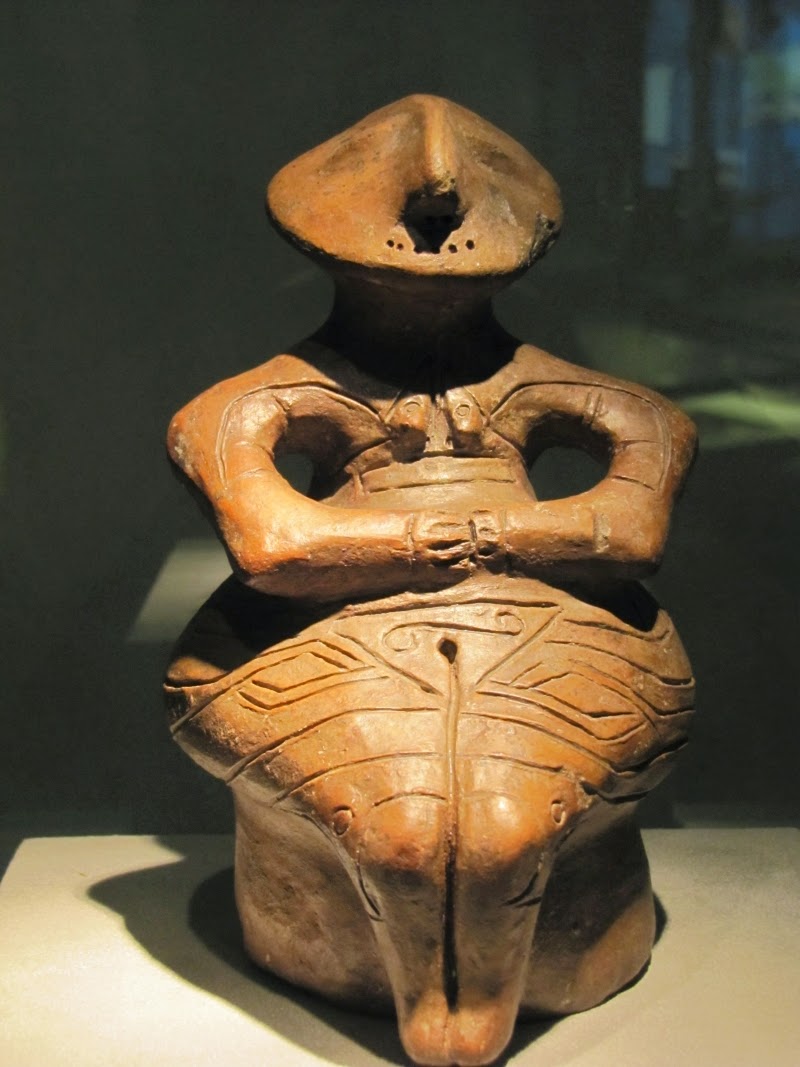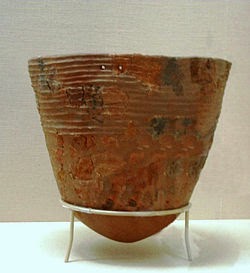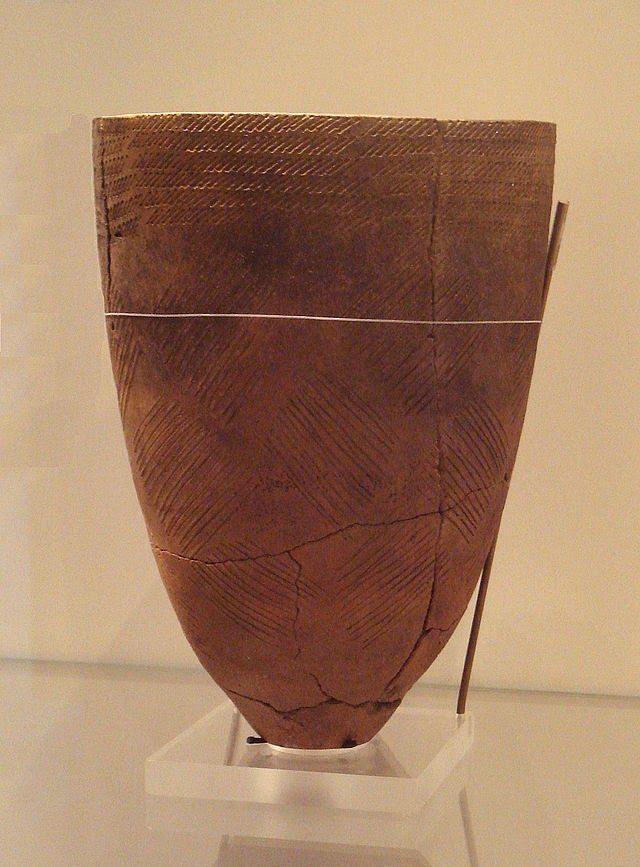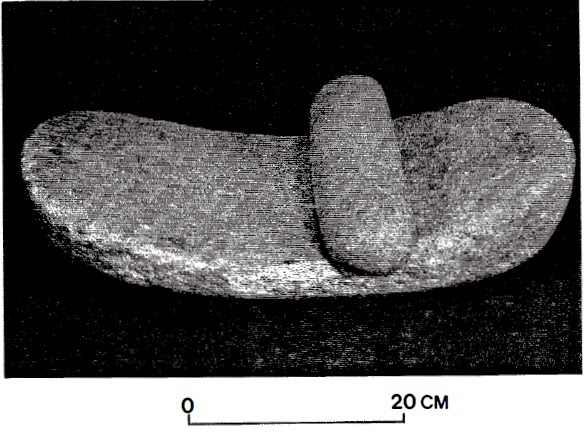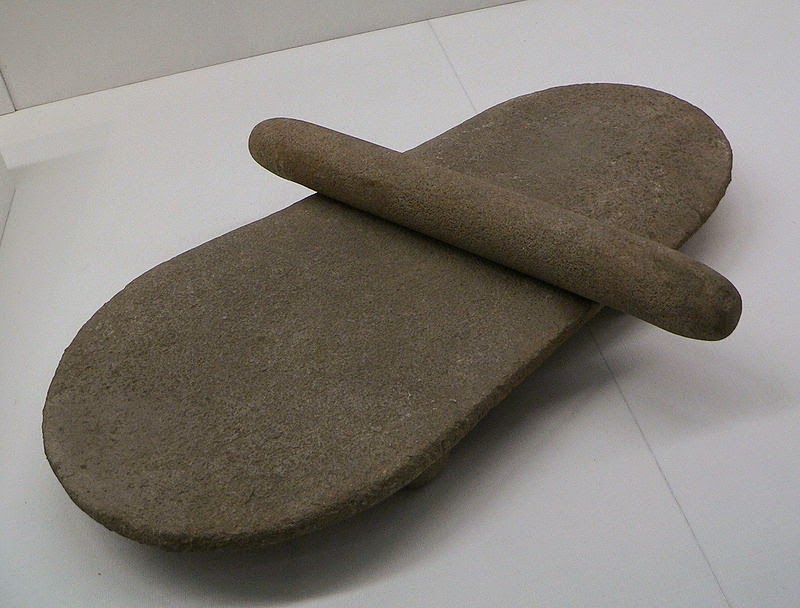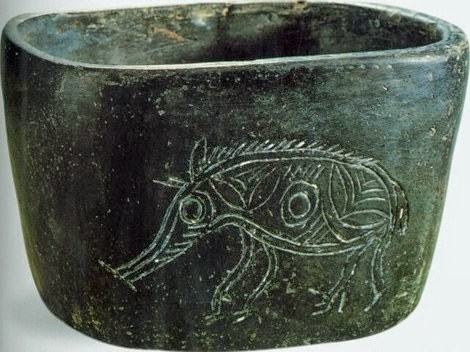Acorns in archaeology
© by Goran Pavlovic © tłumaczenie by Czesław Białczyński
In my last post I talked about Oaks and how useful they were and are to people. The last thing that I said in my last post is that acorns had been eaten by humans since at least late Paleolithic times right up to modern times, and that I would write about acorns and acorn eaters in my next few posts. In this post I will write about archaeological evidence we have for human consumption of acorns during the Paleolithic, Mesolithic, Neolithic, Copper age, Bronze age and Iron age. I hope you find the data presented in this post as eye opening as I did find it, and that you will start seeing acorns in a completely different light from now on.
W moim ostatnim poście mówiłem o Dębach i o tym, jak przydatne były i są dla ludzi. Ostatnią rzeczą, którą powiedziałem w moim ostatnim poście, jest to, że żołędzie były zjadane przez ludzi od co najmniej późnego paleolitu aż do czasów współczesnych, i że napiszę o żołędziach i zjadaczach żołędzi w kilku następnych postach. W tym poście napiszę o dowodach archeologicznych, które mamy na temat spożywania żołędzi przez ludzi w okresie paleolitu, mezolitu, neolitu, epoki miedzi, epoki brązu i epoki żelaza. Mam nadzieję, że dane przedstawione w tym poście uznasz za otwierające oczy, tak jak ja je znalazłem, i że od teraz zaczniesz widzieć żołędzie w zupełnie innym świetle.
Acorns are usually eaten roasted, and during roasting the thin-walled shells are carbonised and destroyed, which makes the macro particle acorn detection in the archaeological remains very difficult. On dry sites wind would then disperse the acorn ash and make it even more difficult to detect. On wet sites we have another problem and that is that like for most other starch rich seeds, the preservation of acorns in waterlogged conditions is not very good. Acorns only preserve well once charred because the elemental carbon of charcoal is not attacked by chemical or biological processes in sediments. But as I said already, when they are fragmented during or after charring, it can be hard to identify them as the bits get scattered. In Eastern North America where archaeobotanical finds of acorns are abundant, the majority of finds consist of fragments of acorn shell of 2mm or less. This might indicate that in Europe most of the evidence of acorn use may have been overlooked or was not preserved. Because of the absence of macro remains we have to rely on micro remains and they are not easy to detect. To detect micro remains of food plants you need to use flotation technique and microscope analysis. At the submerged Mesolithic site of Tybrind Vig in Denmark which is known for its excellent preservation conditions, acorn use has only been attested by the identification of small fragments of acorn using a scanning electron microscope. The same happened at the sites of Cova Fosca and Roc de Migdia in Spain, which had no previous evidence of acorns, and where the presence of acorn parenchyma was attested only by using a scanning electron microscope. However both these techniques are expensive and require well equipped archaeobotanical laboratories. Because of this there are significant national and regional differences in the intensity of archaeobotanical research, resulting in acorn traces being missed among the archaeological material and in an underestimation of the use of acorns as a source of human nutrition in the past.
Żołędzie są zwykle spożywane pieczone, a podczas pieczenia cienkościenne muszle ulegają zwęgleniu i zniszczeniu, co bardzo utrudnia wykrywanie makrocząsteczek żołędzi w pozostałościach archeologicznych. W suchych miejscach wiatr rozproszyłby wtedy popiół z żołędzi i jeszcze bardziej utrudniłby jego wykrycie. Na mokrych stanowiskach mamy inny problem, a mianowicie, podobnie jak w przypadku większości innych nasion bogatych w skrobię, konserwacja żołędzi w warunkach podmokłych nie jest zbyt dobra. Żołędzie zachowują się dobrze tylko po zwęgleniu, ponieważ pierwiastkowy węgiel węgla drzewnego nie jest atakowany przez procesy chemiczne lub biologiczne w osadach. Ale jak już powiedziałem, kiedy są rozdrobnione podczas lub po zwęgleniu, może być trudno je zidentyfikować, ponieważ cząstki są rozproszone. We wschodniej Ameryce Północnej, gdzie znaleziska archeobotaniczne żołędzi są obfite, większość znalezisk składa się z fragmentów skorupy żołędzi o wielkości 2 mm lub mniejszej. Może to wskazywać, że w Europie większość dowodów używania żołędzi mogła zostać przeoczona lub nie została zachowana. Ze względu na brak makropozostałości musimy polegać na mikropozostałościach, które nie są łatwe do wykrycia. Do wykrywania mikropozostałości roślin jadalnych należy zastosować technikę flotacji oraz analizę mikroskopową. W zatopionym mezolitycznym stanowisku Tybrind Vig w Danii, które słynie z doskonałych warunków zachowania, użycie żołędzi zostało potwierdzone jedynie poprzez identyfikację małych fragmentów żołędzi za pomocą skaningowego mikroskopu elektronowego. To samo stało się na stanowiskach Cova Fosca i Roc de Migdia w Hiszpanii, gdzie wcześniej nie było żadnych śladów żołędzi, a obecność miąższu żołędzi potwierdzono jedynie za pomocą skaningowego mikroskopu elektronowego. Jednak obie te techniki są drogie i wymagają dobrze wyposażonych laboratoriów archeobotanicznych. Z tego powodu istnieją znaczne krajowe i regionalne różnice w intensywności badań archeobotanicznych, co skutkuje pomijaniem śladów żołędzi w materiale archeologicznym i niedocenianiem wykorzystania żołędzi jako źródła pożywienia człowieka w przeszłości.
This is the main reason why hazelnuts are usually the most frequently found collected plants on archaeological sites. Hazelnut are eaten raw, where the husk is broken and discarded so we have a chance to find big fragments close together. Also hazelnut husks are far more durable than acorn ones. Another reason why acorns are not detected in larger quantities on archaeological sites is because a lot of the acorn processing is usually undertaken completely or partially off site in the actual oak groves, on river edges, collective grinding stone…. which all adds to the difficulty of detecting acorns among the food remains.
Jest to główny powód, dla którego orzechy laskowe są zwykle najczęściej spotykanymi roślinami zebranymi na stanowiskach archeologicznych. Orzechy laskowe są spożywane na surowo, gdzie łuska jest łamana i odrzucana, dzięki czemu mamy szansę znaleźć duże fragmenty blisko siebie. Również łupiny orzechów laskowych są znacznie trwalsze niż żołędzie. Innym powodem, dla którego żołędzie nie są wykrywane w większych ilościach na stanowiskach archeologicznych, jest to, że większość przetwarzania żołędzi jest zwykle prowadzona całkowicie lub częściowo poza terenem rzeczywistych gajów dębowych, na brzegach rzek, zbiorczym kamieniu szlifierskim…. trudność w wykryciu żołędzi wśród resztek jedzenia.
Even with all these difficulties in detecting acorns, there is enough archaeological evidence that shows that acorns were much more important food source than most people, including most archaeologists think. The number of acorn finds on archaeological sites is still high. At several Mesolithic sites in Europe, acorns are only outnumbered by hazelnuts, the husks of which are far more durable. Acorns are the most frequently found wild fruits at protohistoric archaeological sites in France. In Spain, acorns are third (after wheat and barley) in terms of frequency of occurrence among archaeobotanical remains, thus even more frequent than legumes such as peas and lentils.
Nawet przy tych wszystkich trudnościach w wykrywaniu żołędzi istnieje wystarczająco dużo dowodów archeologicznych, które pokazują, że żołędzie były znacznie ważniejszym źródłem pożywienia, niż myśli większość ludzi, w tym większość archeologów. Liczba znalezisk żołędzi na stanowiskach archeologicznych jest wciąż wysoka. W kilku mezolitycznych miejscach w Europie żołędzie przewyższają liczebnie jedynie orzechy laskowe, których łupiny są znacznie trwalsze. Żołędzie to najczęściej spotykane dzikie owoce na protohistorycznych stanowiskach archeologicznych we Francji. W Hiszpanii żołędzie zajmują trzecie miejsce (po pszenicy i jęczmieniu) pod względem częstości występowania wśród szczątków archeobotanicznych, a więc nawet częściej niż rośliny strączkowe, takie jak groch i soczewica.
The fact that acorns are no longer considered as being edible is also making it likely that archaeologists would not even look for them when they are looking for human food traces. Also when found on archaeological sites acorns are likely to be misunderstood and misinterpreted as accidental blow in or as animal food. But ethnographic and historical evidence is telling us that in some parts of the world acorns were used as human food until very recently.
Fakt, że żołędzie nie są już uważane za jadalne, sprawia również, że archeolodzy nawet nie będą ich szukać, gdy szukają śladów ludzkiego jedzenia. Również znalezione na stanowiskach archeologicznych żołędzie mogą zostać źle zrozumiane i błędnie zinterpretowane jako przypadkowe zdarzenie lub jako pokarm dla zwierząt. Ale dowody etnograficzne i historyczne mówią nam, że w niektórych częściach świata żołędzie były używane jako pokarm dla ludzi aż do niedawna.
During the pre-agricultural period acorns were an important plant food resource for hunter-gatherers in Europe. Archaeological evidence supports the conclusion that acorns have always been an attractive food resource within various resource strategies, including agrarian societies. In prehistoric agricultural communities, acorns may have played a role as food substitute or reserve for bad times, reserved for emergencies, for example when cereal agriculture had failed.
W okresie przedrolniczym żołędzie były ważnym źródłem pożywienia roślinnego dla łowców-zbieraczy w Europie. Dowody archeologiczne potwierdzają wniosek, że żołędzie zawsze były atrakcyjnym źródłem pożywienia w ramach różnych strategii dotyczących zasobów, w tym w społeczeństwach agrarnych. W prehistorycznych społecznościach rolniczych żołędzie mogły odgrywać rolę substytutu żywności lub rezerwy na złe czasy, zarezerwowanej na sytuacje kryzysowe, na przykład gdy uprawa zbóż zawiodła.
Within the context of agricultural sites acorns are usually located close to fireplaces and in furnaces. Frequently they are accompanied by other crops. In addition, acorns are common finds in vessels and storage pits. They are often shelled and mixed with cereals. Acorns also occur in shallow pits and are also found unshelled. Acorns are found in graves, and their appearance there as sacrificial offering cannot be discounted.
W ramach kontekstu agrikulturowego miejsca żołędziowe są zwykle zlokalizowane w pobliżu palenisk i pieców. Często towarzyszą im inne uprawy. Ponadto żołędzie są częstym znaleziskiem w naczyniach i dołach magazynowych. Często są łuskane i mieszane ze zbożami. Żołędzie występują również w płytkich dołach, a także znajdują się w stanie niełuskanym. Żołędzie znajdują się w grobach, a ich pojawienie się tam jako ofiara jest nie do przecenienia.
The high number of prehistoric sites across oak growing regions of the Northern Hemisphere where acorns have been found and the large number of acorns recovered from some of these sites are confirming that acorns have been one of the most important food sources for humans in the oak growing regions of the Northern Hemisphere since Paleolithic times.
Duża liczba prehistorycznych miejsc w regionach uprawy dębu na półkuli północnej, w których znaleziono żołędzie, oraz duża liczba żołędzi odzyskanych z niektórych z tych miejsc potwierdzają, że żołędzie były jednym z najważniejszych źródeł pożywienia dla ludzi w obszarach wystęowania dębu w regionach półkuli północnej od czasów paleolitu.
I will here present the list of all the cultures on whose sites acorns were found among food remains. The list is far from being definitive, and I would appreciate any information about sites that I have missed. But as far as I know this is the most comprehensive list of acorn finds in archaeological material freely available in English on the Internet. And the list reads like „who’s who” of the Northern Hemisphere ancient history, containing all the most advanced and important cultures of the Paleolithic, Mesolithic, Neolithic, Copper age, Bronze age and Iron age. I believe that as the archaeobotanical research intensifies, we will see more and more evidence of the use of acorns as food. But I believe that even this much is enough to prove the point. All the references to the original documents containing data about acorns in archaeological sites are listed at the end of the post with clickable links.
Przedstawię tutaj listę wszystkich kultur, na których stanowiskach znaleziono żołędzie wśród resztek jedzenia. Lista nie jest ostateczna i byłbym wdzięczny za wszelkie informacje o wzmiankach, które przegapiłem. Ale o ile mi wiadomo, jest to najbardziej wyczerpująca lista znalezisk żołędzi w materiale archeologicznym, swobodnie dostępnym w języku angielskim w Internecie. A lista brzmi jak „kto jest kim” w starożytnej historii półkuli północnej, zawierającej wszystkie najbardziej zaawansowane i ważne kultury paleolitu, mezolitu, neolitu, epoki miedzi, epoki brązu i epoki żelaza. Wierzę, że wraz z intensyfikacją badań archeobotanicznych będziemy widzieć coraz więcej dowodów na wykorzystywanie żołędzi jako pokarmu. Ale wierzę, że nawet to wystarczy, aby to udowodnić. Wszystkie odniesienia do oryginalnych dokumentów zawierających dane o żołędziach na stanowiskach archeologicznych są wymienione na końcu wpisu wraz z klikalnymi linkami.
I will present the data according to the region. I decided to do that because a lot of the archaeological sites had been occupied over thousands of years and it would be impossible to put them into any one time period. Also presenting the archaeological data according to the region shows that people from certain areas liked eating acorns more than people from other areas and kept eating them over the period of thousands of years spanning multiple cultures. Which opens a question whether acorn eating is linked to a particular tribal of genetic populations.
Przedstawię dane według regionu. Zdecydowałem się na to, ponieważ wiele stanowisk archeologicznych było zamieszkanych przez tysiące lat i niemożliwe byłoby umieszczenie ich w jednym okresie. Również przedstawienie danych archeologicznych według regionu pokazuje, że ludzie z niektórych obszarów lubili jeść żołędzie bardziej niż ludzie z innych obszarów i jedli je przez tysiące lat obejmujących wiele kultur. Co otwiera pytanie, czy jedzenie żołędzi jest powiązane z konkretnym plemieniem populacji genetycznych.
It is also very interesting that I could not find any data for acorns being found on the sites of the Yamna culture and Cucuteni Trypillian cultre. Why? Did I just miss the available data or were these two cultures different from the rest of the Old European cultures? Is it because these two cultures were the true Steppe cultures as opposed to all the other European cultures which were forest cultures?
I also could not find any data for acorns being found on the sites in Britain and Ireland. Again did I just miss the available data or are Britain and Ireland in some way different from the rest of Europe?
I would greatly appreciate any help in answering these two questions.
Bardzo interesujące jest również to, że nie udało mi się znaleźć żadnych danych dotyczących występowania żołędzi na stanowiskach kultury Yamna i kultury Cucuteni Trypillian. Dlaczego? Czy po prostu przegapiłem dostępne dane, czy też te dwie kultury różniły się od reszty kultur Starej Europy? Czy dlatego, że te dwie kultury były prawdziwymi kulturami stepowymi, w przeciwieństwie do wszystkich innych kultur europejskich, które były kulturami leśnymi? Nie mogłem również znaleźć żadnych danych dotyczących żołędzi znalezionych na stanowiskach w Wielkiej Brytanii i Irlandii. Znowu, czy po prostu przegapiłem dostępne dane, czy też Wielka Brytania i Irlandia różnią się w jakiś sposób od reszty Europy? Byłbym bardzo wdzięczny za pomoc w odpowiedzi na te dwa pytania.
Near East
Bliski Wschód
The earliest proof we have that acorns were used as human food are found in middle east at the Gesher Benot Yaaqov Paleolithic site [1].
Najwcześniejsze dowody na to, że żołędzie były używane jako pokarm dla ludzi, znajdują się na Bliskim Wschodzie w paleolicie Gesher Benot Yaaqov [1].
Gesher Benot Yaaqov is located on the shores of the paleo lake Hula in the northern Jordan Valley in the Dead Sea Rift. The site was used by humans for about 100,000 years until 790,000 BC. Fourteen archaeological horizons indicate that Acheulian humans repeatedly occupied the lake margins, where they skillfully produced stone tools, systematically butchered and exploited animals, gathered plant food, and controlled fire. The nut remains found in Gesher Benot Ya’aqov site and dated to about 750 000 BC, are mostly those of Atlantic pistachio, acorns of Mt. Tabor Oak, and wild almonds. They are thought to have been consumed by humans.
Gesher Benot Yaaqov znajduje się nad brzegiem paleo jeziora Hula w północnej Dolinie Jordanu w szczelinie Morza Martwego. Siedlisko było używane przez ludzi przez około 100 000 lat, aż do 790 000 pne. Czternaście horyzontów archeologicznych wskazuje, że ludzie acheulscy wielokrotnie zamieszkiwali brzegi jeziora, gdzie umiejętnie wytwarzali kamienne narzędzia, systematycznie zabijali i eksploatowali zwierzęta, zbierali pokarm roślinny i kontrolowali ogień. Pozostałości orzechów znalezione na stanowisku Gesher Benot Ya’aqov i datowane na około 750 000 pne to głównie pistacje atlantyckie, żołędzie dębu Tabor i dzikie migdały. Uważa się, że były jedzone przez ludzi.
Kebara cave is a limestone cave situated at 60 – 65 metres ASL on the western escarpment of the Carmel Range, in the Ramat Hanadiv preserve of Zichron Yaakov.
Jaskinia Kebara to wapienna jaskinia położona na wysokości 60 – 65 m n.p.m. na zachodnim zboczu pasma Karmel, w rezerwacie Ramat Hanadiv Zichrona Yaakova.
The cave was inhabited between 60,000 – 48,000 BC. Acorns, pistachios and legumes were found in Middle Paleolithic layers [2] dated to about 60 000 BC – 40 000 BC. Kebara cave was at that time occupied by Neanderthals which shows that they too used acorns as food.
Jaskinia była zamieszkana w latach 60 000 – 48 000 pne. Żołędzie, pistacje i rośliny strączkowe znaleziono w warstwach środkowego paleolitu [2] datowanych na około 60 000 pne – 40 000 pne. Jaskinia Kebara była w tym czasie zamieszkana przez neandertalczyków, co świadczy o tym, że oni również używali żołędzi jako pożywienia.
We see that people were still eating acorns at the time of the Last Glacial Maximum. Acorns, legumes and several other plants were reported [3] at Ohalo II site in Israel. Ohalo is an archaeological site in the vicinity of the Sea of Galilee inhabited by hunter gatherers around the time of the Last Glacial Maximum, dated to about 17,400 BC. Ohalo is one of the best preserved hunter-gatherer archaeological sites of that period, and is extremely significant because of the numerous well preserved fruit, nut, acorn and cereal grain remains as well as grinding stones [4], which are confirming that plant and particularly starch food played a significant part of the Paleolithic people’s diet.
Widzimy, że ludzie nadal jedli żołędzie w czasie ostatniego maksimum zlodowacenia. Żołędzie, rośliny strączkowe i kilka innych roślin odnotowano [3] na stanowisku Ohalo II w Izraelu. Ohalo to stanowisko archeologiczne w pobliżu Jeziora Galilejskiego, zamieszkane przez łowców-zbieraczy w okresie maksimum ostatniego zlodowacenia, datowanego na około 17 400 lat pne. Ohalo jest jednym z najlepiej zachowanych stanowisk archeologicznych łowiecko-zbierackich z tego okresu i jest niezwykle ważne ze względu na liczne dobrze zachowane szczątki owoców, orzechów, żołędzi i ziaren zbóż oraz kamienie szlifierskie [4], które potwierdzają, że rośliny i szczególnie skrobia odgrywała znaczącą rolę w diecie ludu paleolitu.
Acorns were next found at the sites of the Natufian culture [5]. The Natufian culture was an Epipaleolithic culture that existed from 13,000 to 9,800 BC. It was unusual in that it was sedentary, or semi-sedentary, before the introduction of agriculture. The Natufian communities are possibly the ancestors of the builders of the first Neolithic settlements of the region. There is some evidence for the deliberate cultivation of cereals, specifically rye, by the Natufian culture, at the Tell Abu Hureyra site, the site for earliest evidence of agriculture in the world. Generally, though, Natufians made use of wild cereals. Tools for food acquisition, such as sickles, and food processors, such as mortars, bowls, and pestles, are interpreted as evidence for harvesting and processing wild cereals and legumes. But mortars, bowls, and pestles could also have been used for grinding, storing and eating of acorns.
Następnie żołędzie znaleziono na stanowiskach kultury natufijskiej [5]. Kultura natufijska była kulturą epipaleolitu, która istniała od 13 000 do 9800 pne. Rozumiemy to zwykle w tym sensie, że przed wprowadzeniem rolnictwa prowadziło się osiadły lub pół-osiadły tryb życia. Społeczności natufijskie są prawdopodobnie przodkami budowniczych pierwszych osad neolitycznych w regionie. Istnieją pewne dowody na celową uprawę zbóż, w szczególności żyta, przez kulturę natufijską w miejscu Tell Abu Hureyra, miejscu, w którym znajdują się najwcześniejsze dowody rolnictwa na świecie. Na ogół jednak Natufianie korzystali z dzikich zbóż. Narzędzia do pozyskiwania żywności, takie jak sierpy i narządzia kuchenne, takie jak moździerze, miski i tłuczki, są interpretowane jako dowody na zbieranie i przetwarzanie dzikich zbóż i roślin strączkowych. Ale moździerze, miski i tłuczki mogły być również używane do mielenia, przechowywania i jadalnych żołędzi.
The few available seeds support the contention that pulses, cereals, almonds, acorns, and other fruits were gathered.
Nieliczne dostępne nasiona potwierdzają twierdzenie, że zbierano rośliny strączkowe, zboża, migdały, żołędzie i inne owoce.
Trees yielding hard-shell fruits were part of the former landscape of the Southern Levant. Among these, oaks were one of the most prominent features of the Mediterranean woodlands, covering large parts of the landscape. Nevertheless, their possible importance as a food source in past economies of the Southern Levant has been underestimated in comparison to other plant resources. Furthermore, the appearance of stone pounding and grinding tools (frequently mentioned in ethnographic accounts as acorn processing tools) in the Epipalaeolithic and the Early Neolithic has been mostly seen as associated with cereal processing and the transition to agriculture based economies. But there is a strong suggestion that they were indeed used for processing of acorns into flour. [10]
Drzewa dające twarde owoce były częścią dawnego krajobrazu południowego Lewantu. Wśród nich dęby były jedną z najbardziej wyróżniających się cech śródziemnomorskich lasów, pokrywając duże części krajobrazu. Niemniej jednak ich ewentualne znaczenie jako źródła pożywienia w dawnych gospodarkach południowego Lewantu było niedoceniane w porównaniu z innymi zasobami roślinnymi. Ponadto pojawienie się narzędzi do tłuczenia i mielenia kamienia (często wymienianych w relacjach etnograficznych jako narzędzia do obróbki żołędzi) w epipaleolicie i wczesnym neolicie było głównie postrzegane jako związane z przetwarzaniem zbóż i przejściem do gospodarek opartych na rolnictwie. Istnieje jednak silna sugestia, że rzeczywiście były one używane do przetwarzania żołędzi na mąkę. [10]
In Mesolithic villages from the Zagros mountains which form the border between Iran and Iraq, dated to 9000 BC, tools used in the preparation of starch plant food, such as U-shaped mortars and pestles, bone sickle-hafts (but no blades with a gloss along the edge) were found. [11] In the absence of any carbonised grains it is, however, impossible to say whether wild cereals were reaped and processed in grinding stones, or whether other foods such as acorns was processed, considering how abundant acorns were in the area. The find, in the Shanidar cave, of fragments of matting or basketry, the oldest yet known, suggests that collecting baskets may have been used. [12]
W mezolitycznych wioskach z gór Zagros, które tworzą granicę między Iranem a Irakiem, datowanych na 9000 lat p.n.e., narzędzia używane do przygotowywania skrobiowego pokarmu roślinnego, takie jak moździerze i tłuczki w kształcie litery U, sierpowate kościane trzonki (ale bez ostrzy z połyskiem wzdłuż krawędzi). [11] Ze względu na brak jakichkolwiek karbonizowanych ziaren nie można jednak powiedzieć, czy dzikie zboża były zbierane i przetwarzane w kamieniach młyńskich, czy też przetwarzano nimi inne produkty spożywcze, takie jak żołędzie, biorąc pod uwagę obfitość żołędzi na tym obszarze. Znalezisko w jaskini Shanidar fragmentów maty lub wyrobów plecionkarskich, najstarszych znanych, sugeruje, że mogły być używane jako kosze do zbierania. [12]
The Upper Tigris Valley, in the Anatolian part of the Fertile Crescent, has indisputable significance for the early Neolithic in terms of the opportunities it provided for the permanent settlement of human communities. One of these settlements is Körtik Tepe, located in the province of Diyarbakir, near Pinarbasi, at the hamlet of the village called Agil, close to where the Batman Creek joins the Tigris. [78]
Dolina Górnego Tygrysu, położona w anatolijskiej części Żyznego Półksiężyca, ma dla wczesnego neolitu niepodważalne znaczenie ze względu na możliwości stałego osadnictwa społeczności ludzkich. Jedną z takich osad jest Körtik Tepe, położona w prowincji Diyarbakir, niedaleko Pinarbasi, w wiosce Agil, niedaleko miejsca, gdzie Batman Creek łączy się z Tygrysem. [78]
Archaeological excavations in the mound commenced in 2000 and are still ongoing. The archaeological data demonstrate that the Upper Tigris Valley was one of the primary regions of the Near East for the establishment of the earliest permanent settlements. In contrast to the communities leading a nomadic lifestyle, in Körtik Tepe food production technologies were developed and fishing was a common activity. There is also evidence for weaving and architectural units were clearly built for the purpose of storing food. The site is famous for its stone ware made from chlorite stone. [79]
Wykopaliska archeologiczne na kopcu rozpoczęto w 2000 roku i trwają do dziś. Dane archeologiczne wskazują, że Dolina Górnego Tygrysu była jednym z głównych regionów Bliskiego Wschodu, w którym powstały najwcześniejsze stałe osady. W przeciwieństwie do społeczności prowadzących koczowniczy tryb życia, w Körtik Tepe rozwinęły się technologie produkcji żywności, a rybołówstwo było powszechną działalnością. Istnieją również dowody na to, że jednostki tkackie i architektoniczne zostały wyraźnie zbudowane w celu przechowywania żywności. Miejsce to słynie z wyrobów kamiennych wykonanych z chlorytu. [79]
Taking the evidence from the different studies altogether, it has been suggested that the people of Körtik Tepe used a wide spectrum of freshwater animals and hygrophilous plants for their subsistence, personal adornments, and equipment. A mix of hunted large and small animals and wild plants seems to have provided the main calorific input. The results corroborate the findings of other contemporaneous sites where an opportunistic use of plants and animals could be demonstrated. So it is suggested that the intensive, probably year-round permanent use of the site is not due to the intensive use or even cultivation of cereals. Rather, it seems that highly valued and/or calorie-rich resources such as acorns, pistachios, hackberry, and probably almonds, as well as easy to catch small animals like tortoises or fish, contributed to the diet. The rich and diversified environment made the site attractive for a permanent settlement. A specialization on cereals could not be observed so far. The interpretation of plant remains has long been biased by our modern perspective, where the focus on cereals as one of the basic nutritional elements has been projected onto the past. [80]
Łącznie biorąc dowody z różnych badań, zasugerowano, że mieszkańcy Körtik Tepe używali szerokiego spektrum zwierząt słodkowodnych i roślin higrofilnych do utrzymania, ozdób osobistych i wyposażenia. Wydaje się, że główny wkład kaloryczny stanowiła mieszanka upolowanych dużych i małych zwierząt oraz dzikich roślin. Wyniki potwierdzają ustalenia innych współczesnych miejsc, w których można było wykazać pasywne wykorzystanie roślin i zwierząt. Sugeruje się więc, że intensywne, prawdopodobnie całoroczne, stałe użytkowanie stanowiska nie jest spowodowane intensywnym użytkowaniem, a nawet uprawą zbóż. Wydaje się raczej, że wysoko cenione i/lub bogate w kalorie zasoby, takie jak żołędzie, pistacje, jeżyna i prawdopodobnie migdały, a także łatwe do złapania małe zwierzęta, takie jak żółwie czy ryby, przyczyniły się do diety. Bogate i zróżnicowane środowisko czyniło to miejsce atrakcyjnym miejscem stałego osadnictwa. Dotychczas nie można było zaobserwować specjalizacji w zbożach. Interpretacja szczątków roślin od dawna jest obciążona naszą współczesną perspektywą, w której skupienie się na zbożach jako jednym z podstawowych składników odżywczych było rzutowane na przeszłość. [80]
Jarmo is an archaeological site located in northern Iraq on the foothills of Zagros Mountains east of Kirkuk city. Jarmo site represents something new in the prehistory of Iraq: a fully sedentary agricultural village growing (and not merely reaping) emmer wheat, still morphologically close to the wild form, but already accompanied by Einkorn wheat, as well as hulled two row barley (also close to the wild ancestor) at a date c. 6500 BC. Lentils, field peas, blue vetchling were also grown and pistachios and acorns were still collected for their fat contents. Among the animals, goat and dog and perhaps pig were domesticated, but not sheep, or cattle, which were hunted together with gazelle and wild boar. Snails still formed part of the diet. [11]
Jarmo to stanowisko archeologiczne położone w północnym Iraku u podnóża gór Zagros na wschód od miasta Kirkuk. Stanowisko Jarmo reprezentuje coś nowego w prehistorii Iraku: w pełni osiadłą wioskę rolniczą, w której uprawia się (a nie tylko zbiera) pszenicę płaskurka, wciąż morfologicznie zbliżoną do formy dzikiej, ale której towarzyszy już pszenica samopsza, a także jęczmień oplewiony dwurzędowy (również blisko dzikiego przodka) w dacie c. 6500 pne. Soczewica, groszek polny, uprawiano również wykę niebieską starej odmiany, a pistacje i żołędzie nadal zbierano ze względu na zawartość tłuszczu. Wśród zwierząt udomowiono kozę, psa i być może świnię, ale nie owce czy bydło, na które polowano łowiąc je razem z gazelą i dzikiem. Ślimaki nadal stanowiły część diety. [11]
In Anatolia Catal Huyuk was a neolithic city site covering 32 acres and dated to between 6700—5700 BC, which may have housed a population of ten thousand people.
W Anatolii Catal Huyuk było neolitycznym miastem o powierzchni 32 akrów, datowanym na lata 6700-5700 pne, które mogło zamieszkiwać dziesięć tysięcy ludzi.
The economy of this vast site, was based on hunting, advanced agriculture, stock-breeding and probably trade. Sheep, goat and dog were domestic, but the importance of hunting was not thereby diminished. Wild cattle, wild sheep, onager, half-ass, red, roe and fallow deer, ibex, wild boar, bear, hare, leopards,2 and various birds, such as black crane, were hunted, but fishing in the river was less important. Agriculture had made tremendous strides forward during the seventh millennium and the rich deposits of level VI yield three forms of wheat (emmer, einkorn and bread wheat), two forms of barley (naked six-row barley and two-row barley), two sorts of peas, lentils, bitter vetch, crucifers grown for vegetable oil, as well as apple, almonds, hack berry, juniper berries, acorns, pistachio, imported from the hills. [11] This is the most varied diet known from any Near Eastern neolithic site. The archeobotany report published in 1999 says that acorn cup and cotyledon fragments were also identified sparsely, but regularly, in the samples. [13]
Gospodarka tego rozległego obszaru opierała się na łowiectwie, zaawansowanym rolnictwie, hodowli bydła i prawdopodobnie handlu. Owce, kozy i psy były zwierzętami domowymi, ale nie zmniejszyło to znaczenia myślistwa. Polowano na dzikie bydło, dzikie owce, onagery, półosły, jelenie rude, sarny i daniele, koziorożce, dziki, niedźwiedzie, zające, lamparty [2] i różne ptaki, takie jak żuraw czarny, ale połowy w rzece były mniej ważne. W siódmym tysiącleciu rolnictwo poczyniło ogromne postępy, a bogate złoża poziomu VI dają trzy formy pszenicy (płaskurka, samopsza i pszenica zwyczajna), dwie formy jęczmienia (jęczmień nagi sześciorzędowy i dwurzędowy), dwa rodzaje grochu, soczewicy, wyki gorzkiej, roślin krzyżowych uprawianych na olej roślinny, a także jabłek, migdałów, siekaczy, jagód jałowca, żołędzi, pistacji, sprowadzanych z gór. [11] Jest to najbardziej zróżnicowana dieta znana ze wszystkich neolitycznych stanowisk na Bliskim Wschodzie. Raport archeobotaniczny opublikowany w 1999 roku mówi, że fragmenty kielicha żołędzi i liścieni również były identyfikowane rzadko, ale regularnie, w próbkach. [13]
At the late Neolithic settlement at Hacilar IX—VI, some two hundred miles farther west from Catalhuyuk, dated to 5700 BC. we find Late Neolithic arrivals, either people from Catalhuyuk or from the Pisidian lake district, which during the previous period had shown some sort of western variant of the Catalhuyuk culture. The economy of the settlement is mainly agricultural and a continuation of that of Catal Huyuk: emmer, einkorn, bread wheat, naked six-row barley, two sorts of peas, lentils, and also chick-peas, as well as acorns, hack berries, etc. Chert blades are set in curved antler-sickles. Hunting had declined, sheep and goat are probably domesticated, cattle and pig appear, whether or not domesticated; the dog is known. [11]
W późnoneolitycznej osadzie w Hacilar IX-VI, około dwustu mil dalej na zachód od Catalhuyuk, datowanej na 5700 pne. znajdujemy przybyszów z późnego neolitu, albo ludzi z Catalhuyuk, albo z Pojezierza Pizydyjskiego, którzy w poprzednim okresie wykazywali jakiś zachodni wariant kultury Catalhuyuk. Gospodarka osady jest głównie rolnicza i jest kontynuacją gospodarki Catal Huyuk: płaskurka, samopsza, pszenica chlebowa, jęczmień nagi sześciorzędowy, dwa rodzaje grochu, soczewica, a także ciecierzyca, a także żołędzie, siekane jagody itp. Ostrza Chert są osadzone w zakrzywionych sierpach poroża. Zakres łowiectwa spada, owce i kozy są prawdopodobnie udomowione, pojawia się bydło i świnie, udomowione lub nie; pies jest znany. [11]
Viticulture may well have begun either near the Caspian or in a region including Colchis, where at two sites dating to the fourth millennium BC the earliest material evidence has been found, in the form of grape-pips. They were found in accumulations associated with stores of chestnuts, hazelnuts and acorns, these too being for food, at the same sites. These accumulations could indeed have been the outcome of food-gathering rather than of harvesting of cultivated vines [8].
Uprawa winorośli mogła równie dobrze rozpocząć się w pobliżu Morza Kaspijskiego lub w regionie obejmującym Kolchidę, gdzie w dwóch miejscach datowanych na czwarte tysiąclecie pne znaleziono najwcześniejsze dowody materialne w postaci pestek winogron. Znaleziono je w skupiskach związanych z magazynami kasztanów, orzechów laskowych i żołędzi, które również były przeznaczone na żywność, w tych samych miejscach. Te nagromadzenia rzeczywiście mogły być wynikiem zbierania żywności, a nie zbioru uprawianej winorośli [8].
Recent archaeobotanical research from third to second millennium BC Tell Mozan in the Upper Khabur Area, NE Syria, shows a dominating presence of deciduous oak charcoal in most of the samples. Therefore oak park woodland probably had a more southwards distribution during the Early Bronze Age than today. That oak was probably locally present is supported through the find of charcoal from small branches and acorns [9].
Niedawne badania archeobotaniczne od trzeciego do drugiego tysiąclecia pne Tell Mozan w obszarze Górnego Chaburu w północno-wschodniej Syrii wskazują na dominującą obecność węgla drzewnego z dębu liściastego w większości próbek. W związku z tym we wczesnej epoce brązu lasy w parku dębowym były prawdopodobnie rozmieszczone bardziej na południe niż obecnie. O tym, że dąb prawdopodobnie występował lokalnie, świadczy znalezisko węgla drzewnego z małych gałęzi i żołędzi [9].
Africa
Afryka
The earliest evidence of acorn use as food in North Afica is found in the archaeological sites belonging to the upper paleolithic people of Taforalt caves, Morocco, dated to 12,000 BC.
Najwcześniejsze dowody używania żołędzi jako pożywienia w Afryce Północnej znajdują się na stanowiskach archeologicznych należących do ludu górnego paleolitu w jaskiniach Taforalt w Maroku, datowanych na 12 000 pne.
The caves were occupied by people of the Oranian culture which live there during the African Humid Period also known as green Sahara, when the north Africa was a lush green land of forests and grasslands. People of this culture had caries in 51% of adult teeth, a frequency comparable to those of early farmers. [14 ]This is attributed to the very high levels of nut consumption, particularly acorns but also pine nuts, juniper berries, pistachios and wild oats. The number of acorn remains found is so large that the archaeologists had to conclude that they were used as year-long staple. Taforalt people had grinding stones, which they used to process some of these nuts, most likely the acorns, whose consumption as bread has been documented since antiquity.
Jaskinie były zamieszkiwane przez ludność kultury orańskiej, która zamieszkiwała je w okresie wilgotnej Afryki, zwanej też zieloną Saharą, kiedy północna Afryka była bujną, zieloną krainą lasów i łąk. Ludzie z tej kultury mieli próchnicę w 51% zębów dorosłych, z częstotliwością porównywalną do wczesnych rolników. [14 ]Przypisuje się to bardzo wysokiemu poziomowi spożycia orzechów, zwłaszcza żołędzi, ale także orzeszków piniowych, jagód jałowca, pistacji i dzikiego owsa. Liczba znalezionych szczątków żołędzi jest tak duża, że archeolodzy musieli stwierdzić, że były one używane przez cały rok. Mieszkańcy Taforaltów mieli kamienie do mielenia, których używali do obróbki niektórych z tych orzechów, najprawdopodobniej żołędzi, których spożywanie jako chleba zostało udokumentowane od starożytności.
Europe
Iberia
In Europe we find the earliest traces of acorn use in Gravettian culture, a paleolithic people who also left behind spectacular cave paintings, evidence of burial and distinctive stone tools. This is based on the new investigations of an ancient stone recovered in a cave called Grotta Paglicci in Puglia, in southern Italy. [83]
W Europie odnajdujemy najwcześniejsze ślady używania żołędzi w kulturze graweckiej, ludu paleolitu, który również pozostawił po sobie spektakularne malowidła naskalne, dowody pochówku i charakterystyczne kamienne narzędzia. Opiera się to na nowych badaniach starożytnego kamienia znalezionego w jaskini o nazwie Grotta Paglicci w Apulii w południowych Włoszech. [83]
Among many stone tools, the archaeologists have found a stone, which is „pale brown and not much bigger than a hand, ” and which was clearly used as a combination pestle and grinder, says Marta Mariotti Lippi, a botany professor at the University of Florence in Italy, who led the research team. It dates back some 32,000 years, she says, providing the earliest evidence of food processing in Europe.
Wśród wielu kamiennych narzędzi archeolodzy znaleźli kamień, który jest „jasnobrązowy i niewiele większy od dłoni”, i który był wyraźnie używany jako kombinacja tłuczka i młynka, mówi Marta Mariotti Lippi, profesor botaniki na Uniwersytecie im. Florence we Włoszech, który kierował zespołem badawczym. Mówi, że pochodzi sprzed około 32 000 lat, dostarczając najwcześniejszych dowodów przetwarzania żywności w Europie.
„There are many other grinding tools, but this is the oldest,” she says.
„Istnieje wiele innych narzędzi rozcierajacych, ale to jest najstarsze” – mówi.
She says these hunter-gatherers used the rounded end of the stone to bash seeds against another rock to break them up. The flat surface of the stone shows the kind of wear that would be produced by grinding the broken seeds into flour.
Mówi, że ci łowcy-zbieracze używali zaokrąglonego końca kamienia roztrzaskując nasiona o inny kamień, aby je rozbić. Płaska powierzchnia kamienia pokazuje rodzaj zużycia, które powstałoby po zmieleniu połamanych nasion na mąkę.
The stone came to light in June 1989, and although well enough studied at the time, two years ago a new team started a fresh study of material from the cave with the latest modern methods.
Kamień ujrzał światło dzienne w czerwcu 1989 roku i chociaż w tamtym czasie był wystarczająco dobrze zbadany, dwa lata temu nowy zespół rozpoczął nowe badania materiału z jaskini przy użyciu najnowszych nowoczesnych metod.
The researchers sealed the stone in plastic to preserve it for future research. But they left exposed small patches that they washed with a gentle stream of water to loosen debris. In the water were hundreds of starch granules of five main types. The most plentiful, says Mariotti Lippi, were from oat seeds, almost certainly Avena barbata, a wild species still common across much of Europe. The stone also processed other edible plants, including acorns and relatives of millet.
Naukowcy zamknęli kamień w plastiku, aby zachować go do przyszłych badań. Ale zostawili odsłonięte małe plamy, które przemyli delikatnym strumieniem wody, aby rozluźnić zanieczyszczenia. W wodzie znajdowały się setki granulek skrobi pięciu głównych typów. Najwięcej, mówi Mariotti Lippi, pochodziło z nasion owsa, prawie na pewno Avena barbata, dzikiego gatunku, który wciąż jest powszechny w dużej części Europy. Kamień przetwarzał również inne rośliny jadalne, w tym żołędzie i krewniaki prosa.
The second oldest proof of the use of acorns as food in Europe is found in late Paleolithic Magdalenian sites of northern Iberia. The Magdalenian culture is one of the later cultures of the Upper Paleolithic in western Europe, dating from around 15,000 to 10,000 BC whose remains are found in France and Spain.
Drugi najstarszy dowód wykorzystania żołędzi jako pożywienia w Europie znajduje się na stanowiskach magdaleńskich późnego paleolitu w północnej Iberii. Kultura magdaleńska jest jedną z późniejszych kultur górnego paleolitu w Europie Zachodniej, datowaną na okres od około 15 000 do 10 000 pne, której pozostałości znajdują się we Francji i Hiszpanii.
Much of Iberia, especially Mediterranean Spain and Portugal, never experienced dramatically cold extremes except in mountain zones. Because of this a high degree of plant exploitation continued in this part of Europe during the Last glacial maximum. At the Cantabrian Magdalenian site El Juyo, dated to the period 13,988 – 15,179 BC, where climatic and environmental conditions were cooler and the vegetation during the Last Glacial Maximum was less varied, plant macro fossil remains from 21 families and 51 genera were found. These included acorn and hazelnut fragments, berry pits, grass seeds and aquatic plants. Magdalenian and Epipaleolithic levels of Nerja caves, dated to 12 000 BC, also contain acorns and wild olive pits. [15] The food remains from the Nerja cave contain abundant fish remains. This is showing us that by later Magdalenian times there is a dramatic increase in the consumption of aquatic resources. Their number of the remains of the aquatic animals is five times greater than that of rabbits in the Magdalenian, but, in the Preboreal levels, fish outnumber rabbits 10 to 1 and include seals which are actually depicted on the walls of the cave.
Znaczna część Półwyspu Iberyjskiego, zwłaszcza śródziemnomorska Hiszpania i Portugalia, nigdy nie doświadczyła dramatycznie niskich temperatur, z wyjątkiem stref górskich. Z tego powodu wysoki stopień eksploatacji roślin utrzymywał się w tej części Europy podczas maksimum ostatniego zlodowacenia. Na kantabryjskim stanowisku magdaleńskim El Juyo, datowanym na okres 13 988 – 15 179 pne, gdzie warunki klimatyczne i środowiskowe były chłodniejsze, a roślinność podczas maksimum ostatniego zlodowacenia była mniej zróżnicowana, znaleziono makroskamieniałości roślin z 21 rodzin i 51 rodzajów. Obejmowały one fragmenty żołędzi i orzechów laskowych, pestki jagodowe, nasiona traw i rośliny wodne. Poziomy magdaleńskie i epipaleolityczne jaskiń Nerja, datowane na 12 000 pne, zawierają również żołędzie i pestki dzikich oliwek. [15] Pozostałości pożywienia z jaskini Nerja zawierają liczne szczątki ryb. Pokazuje nam to, że w późniejszych czasach magdaleńskich nastąpił dramatyczny wzrost zużycia zasobów wodnych. Liczba szczątków zwierząt wodnych jest pięć razy większa niż królików w okresie magdaleńskim, ale na poziomach preborealnych ryby przewyższają liczebnie króliki 10 do 1 i obejmują foki, które są faktycznie przedstawione na ścianach jaskini.
The collection of sea and land mollusks as well as pine nuts and acorns also is attested to in the Early Mesolithic levels, even if the bulk of food supplies continued to be represented by the meat of red deer and ibex, as in the preceding later Magdalenian.
Zbiór mięczaków morskich i lądowych, a także orzeszków piniowych i żołędzi jest również poświadczony na poziomach wczesnego mezolitu, nawet jeśli większość zapasów żywności nadal stanowiło mięso jelenia i koziorożca, jak w poprzednim i późniejszym okresie magdaleńskim.
The Azilian culture is an Epipaleolithic culture which existed in northern Spain and southern France around 8,000 BC. It succeeded the Magdalenian culture in the same area, and archaeologists even think the Azilian culture could be the tail end of the Magdalenian culture as the warming climate brought about changes in human behaviour in the area. The effects of melting ice sheets would have diminished the food supply and probably impoverished the previously well-fed Magdalenian manufacturers. Acorns, haws, sloes, hazel-nuts, chestnuts, cherries, prunes and walnuts were discovered at the Le Mas d’Azil cave together with a handful of barley-seeds.
Kultura azylijska to kultura epipaleolityczna, która istniała w północnej Hiszpanii i południowej Francji około 8000 pne. Zastąpiła kulturę magdaleńską na tym samym obszarze, a archeolodzy uważają nawet, że kultura azylijska może być końcem kultury magdaleńskiej, ponieważ ocieplający się klimat spowodował zmiany w zachowaniu ludzi na tym obszarze. Skutki topnienia pokryw lodowych zmniejszyłyby zapasy żywności i prawdopodobnie zubożyły wcześniej dobrze odżywionych magdaleńskich wytwórców. Żołędzie, głogi, tarniny, orzechy laskowe, kasztany, wiśnie, suszone śliwki i orzechy włoskie odkryto w jaskini Le Mas d’Azil wraz z garścią nasion jęczmienia.
In Catalunya at Cingle Vermell, dated to 7,760 BC, numerous remains of hazelnuts, acorns, pine nuts, chestnuts and wild fruits have been recovered. [15]
W Catalunya w Cingle Vermell, datowanym na 7760 pne, odzyskano liczne pozostałości orzechów laskowych, żołędzi, orzeszków piniowych, kasztanów i dzikich owoców. [15]
In the Basque country of Spain, Mesolithic and Neolithic wild plant gathering has also been reported. In several sites hazelnuts, acorns and wild tree fruits were common in both periods. One of the most famous sites from Basque country is Epipaleolithic site in València known as La Sarga.
W Kraju Basków w Hiszpanii odnotowano również gromadzenie dzikich roślin w mezolicie i neolicie. Na kilku stanowiskach w obu okresach powszechne były orzechy laskowe, żołędzie i owoce dziko rosnących drzew. Jednym z najbardziej znanych miejsc z Kraju Basków jest epipaleolityczne stanowisko w Walencji, znane jako La Sarga.
At La Sarga , a painted rock art scene shows several figures collecting acorns or hazelnuts as they fall from the tree.
Malowana scena naskalna w La Sarga przedstawia kilka postaci zbierających spadające z drzewa żołędzie lub orzechy laskowe.
Pine nuts, acorns and chestnuts were reported at Cova Fosca dated to 7,460 BC. [18]
Orzeszki piniowe, żołędzie i kasztany odnotowano w Cova Fosca datowane na 7460 pne. [18]
The archaeobotanical material obtained from 24 sites from the Neolithic period (5400–2300 cal BC) in the north-east of the Iberian Peninsula was recently analized. Among dry sites, several types of context were evaluated: dwelling areas, hearths, roasting pits and byres. Material was also analysed from a waterlogged cultural layer of one early Neolithic lakeshore site, La Draga. Acorns, hazelnuts, mastic fruits and wild grapes were among the most frequently encountered fruits and seeds. Larger amounts of charred remains of certain wild fruits like acorns and hazelnuts found in mountain areas are highlighted as potential evidence of the regular practise of roasting, potentially indicating regional traditions. [70]
Niedawno przeanalizowano materiał archeobotaniczny pozyskany z 24 stanowisk z okresu neolitu (5400-2300 p.n.e.) w północno-wschodniej części Półwyspu Iberyjskiego. Wśród stanowisk suchych oceniono kilka rodzajów kontekstów: obszary mieszkalne, paleniska, paleniska i obory. Przeanalizowano również materiał z podmokłej warstwy kulturowej jednego z wczesnych neolitycznych stanowisk położonych nad jeziorem, La Draga. Do najczęściej spotykanych owoców i nasion należały żołędzie, orzechy laskowe, owoce mastyksu i dzikie winogrona. Większe ilości zwęglonych szczątków niektórych dzikich owoców, takich jak żołędzie i orzechy laskowe, znalezione na obszarach górskich, są podkreślane jako potencjalny dowód regularnej praktyki prażenia, potencjalnie wskazujący na regionalne tradycje. [70]
La Draga is the only lake-dwelling site that is known in the Iberian Peninsula.
La Draga jest jedynym znanym miejscem zamieszkania nad jeziorem na Półwyspie Iberyjskim.
The main interest of the site is the extraordinary preservation of plant remains both in charred and waterlogged states. The site was occupied at least twice between 5300 and 5000 BC by people of Carded Ware Culture. The first phase of occupation contains remains of cereals, mainly wheat, poppy, and many collected wild plants such as acorns, blackberries and wild grape. Remains of cultivated legumes were not found. [44]
In Portugal, carbonised acorns were reported at the Neolithic site of Ameal, dated to 3500 BC. A concentrations of acorns is reported at the Copper Age site Vila Nova de São Pedro dated to 2600 to 1300 BC.
W Portugalii karbonizowane żołędzie odnotowano w neolitycznym miejscu Ameal, datowanym na 3500 pne. Nasilenie zbiorowisk żołędzi odnotowano w miejscu z epoki miedzi Vila Nova de São Pedro datowanym na 2600 do 1300 pne.
At the Bronze Age settlement at Moncín in north-east Spain, dated to 2600 – 1300 BC, the plant economy was dominated by wheat and barley, with a small contribution from edible wild plants and fruits. Lentils were present, but only rarely. Flax was also found, but whether cultivated or not is not known. The sweet acorns from the Mediterranean holm-oak, were common and they may also have been mixed with wheat for bread. [55]
W osadzie z epoki brązu w Moncín w północno-wschodniej Hiszpanii, datowanej na 2600-1300 pne, gospodarka roślinna była zdominowana przez pszenicę i jęczmień, z niewielkim udziałem jadalnych dzikich roślin i owoców. Soczewica była obecna, ale rzadko. Znaleziono również len, ale nie wiadomo, czy był uprawiany, czy nie. Słodkie żołędzie z śródziemnomorskiego dębu ostrokrzewowego były powszechne i mogły być również mieszane z pszenicą na chleb. [55]
The Castro culture is the Celtic culture of the northwestern regions of the Iberian Peninsula (present-day northern Portugal and the Spanish regions of Galicia, western Asturias and north western León). It existed from the end of the Bronze Age (c. 9th century BC) until it was subsumed by Roman culture (c. 1st century BC).
Kultura Castro to kultura celtycka północno-zachodnich regionów Półwyspu Iberyjskiego (dzisiejsza północna Portugalia i hiszpańskie regiony Galicji, zachodniej Asturii i północno-zachodniego León). Istniała od końca epoki brązu (ok. IX wpne) do czasu podporządkowania jej kulturze rzymskiej (ok. I wpne).
Using three main type of tools, ploughs, sickles and hoes, together with axes for woodcutting, the Castro inhabitants grew a number of cereals: (wheat, millet, possibly also rye) for baking bread, as well as oats, and barley which they also used for beer production. They also grew beans, peas and cabbage, and flax for fabric and clothes production; other vegetables where collected: nettle, watercress. Large quantities of acorns have been found hoarded in most hill-forts, and they were used for bread production once toasted and crushed in granite stone mills.
Za pomocą trzech głównych typów narzędzi, pługów, sierpów i motyk, wraz z siekierami do obróbki drewna, mieszkańcy Castro uprawiali szereg zbóż: (pszenicę, proso, być może także żyto) do wypieku chleba, a także owies i jęczmień, które używano również do produkcji piwa. Uprawiali także fasolę, groch i kapustę oraz len do produkcji tkanin i odzieży; zbierano inne warzywa: pokrzywę, rukiew wodną. W większości osad na wzgórzach znaleziono duże ilości żołędzi, które były używane do produkcji chleba po tostowaniu i kruszeniu w granitowych kamiennych młynach.
Acorns were a staple food in Iberia during late Bronze age as shown by chared acorn remains found in Santinha and and S. Juliao sites in the Cávado Basin dated to the 10th century BC. [63]
Żołędzie były podstawowym pożywieniem na Półwyspie Iberyjskim w późnej epoce brązu, o czym świadczą zwęglone szczątki żołędzi znalezione na stanowiskach Santinha i S. Juliao w dorzeczu Cávado datowane na X wiek pne. [63]
Italy
Włochy
The Grotta dell’Uzzo cave is one of the most important prehistoric sites in Sicily. The earliest human habitaion layers in the cave were dated to 8000 BC.
Jaskinia Grotta dell’Uzzo jest jednym z najważniejszych prehistorycznych miejsc na Sycylii. Najwcześniejsze warstwy siedlisk ludzkich w jaskini datowane są na 8000 pne.
At the this cave, wild peas, acorns, olives, grapes and arbutus fruits were recovered.[19]
W jaskini tej wydobyto dziki groszek, żołędzie, oliwki, winogrona i owoce arbutusa.[19]
Impressive amounts of nuts, acorns, chestnuts, blackberries, wild apples, cornelian cherries, dogwood, grapes were found at Neolithic villages at old Sammardenchia and Fagnigola in Friuli and at Lugo di Romagna in Northern Italy dated to about 6050 BC. [19]
Imponujące ilości orzechów, żołędzi, kasztanów, jeżyn, dzikich jabłek, derenia, glogu, winogron znaleziono w neolitycznych wioskach w starej Sammardenchia i Fagnigola we Friuli oraz w Lugo di Romagna w północnych Włoszech, datowanych na około 6050 pne. [19]
The open-air site Villandro/Villanders in Alto Adige/South Tyrol, was inhabited through Late Mesolithic (Castelnovian) dated to 5970-5680 BC all the way to Early Medieval period. The first settlers here grew Barley and naked Wheat, maybe using the surrounding environment for the collection of wild fruits like Strawberry and Elderberries. During the following occupation in the Middle Neolithic (Square-Mouthed Pottery Culture) the cereal assemblage does not change, but Emmer makes its first appearance. Meanwhile, many more wild fruits were gathered in the woodland, like Blackberries, Raspberries, Acorns and Wild Cherries. The large amount of charred Corylus wood suggests that also hazelnuts were commonly eaten in this period, but no shells were found in these layers. [36]
Teren pod gołym niebem Villandro/Villanders w Górnej Adydze/Południowym Tyrolu był zamieszkany przez późny mezolit (kasztelnowski) datowany na lata 5970-5680 pne aż do okresu wczesnego średniowiecza. Pierwsi osadnicy uprawiali tu jęczmień i nagą pszenicę, być może wykorzystując otaczające środowisko do zbierania dzikich owoców, takich jak poziomki i bzu czarnego. Podczas następnej fazy osiedlenia w środkowym neolicie (kultura ceramiki z kwadratowymi ustami) zespół zbóż nie zmienia się, ale po raz pierwszy pojawia się emmer [CB stary rodzaj pszenicy]. W międzyczasie w lasach zebrano znacznie więcej dzikich owoców, takich jak jeżyny, maliny, żołędzie i dzikie czereśnie. Duża ilość zwęglonego drewna Corylus sugeruje, że w tym okresie powszechnie spożywano także orzechy laskowe, jednak w tych warstwach nie znaleziono łupin. [36]
In the Veneto area in the 5th millennium BC we find Square Mouthed Pottery culture.
W regionie Veneto w V tysiącleciu pne znajdujemy kulturę ceramiki z kwadratowymi ustami.
Their diet was varied. They grew cereals such as barley, emmer wheat, einkorn, naked wheat (common and/or durum/rivet wheat), and the so-called “new glume wheat”. The cultivation of spelt wheat is uncertain, as is the cultivation of millet and they only appear in the later layers from 3rd millennium BC. Flax and poppy, both species deriving from the “initial Neolithic package” coming from the Fertile Crescent, were also found. They eat a lot of oxen and sheep meat with small amount of fish and shelfish. The list of fruit species used as food is relatively extensive: wild grapes, berries of the cornelian cherry and the common dogwood, apples and pears, bladder cherries, blackberries, raspberries, haw-thorn berries, elderberries, wild plums, figs, strawberries. Starchy foods include hazelnuts which are most frequent, acorns, water chestnut and walnuts. There is limited evidence of pulses being eaten, mostly peas and lentils.[39]
Ich dieta była zróżnicowana. Uprawiali zboża, takie jak jęczmień, pszenica płaskurka, samopsza, pszenica naga (zwykła i/lub pszenica durum/nitowana) oraz tzw. „nowa pszenica plewowa”. Uprawa orkiszu jest niepewna, podobnie jak uprawa prosa i pojawiają się one dopiero w późniejszych warstwach z III tysiąclecia pne. Znaleziono także len i mak, oba gatunki pochodzące z „początkowego pakietu neolitycznego” pochodzącego z Żyznego Półksiężyca. Spożywają dużo mięsa wołowego i baraniego z niewielką ilością ryb i skorupiaków szelfowych. Lista gatunków owoców wykorzystywanych jako żywność jest stosunkowo obszerna: dzikie winogrona, jagody derenia i derenia wiśniowego, jabłka i gruszki, wiśnie pęcherzowe, jeżyny, maliny, owoce głogu, czarny bez, dzikie śliwki, figi, truskawki. Do pokarmów bogatych w skrobię należą najczęściej orzechy laskowe, żołędzie, kasztany wodne i orzechy włoskie. Istnieją ograniczone dowody na spożywanie roślin strączkowych, głównie grochu i soczewicy.
In Italy the food remains found in the Bronze age sites are: pears, apples, cornelian cherries and various berries, along with hazelnuts and acorns, accompanied the usual range of grain crops and pulses. Millet appears in the Late Bronze Age, and false flax is also present. Grapes are attested regularly through the Bronze Age. At the Bronze Age site Fiavé-Carera ceramics with charred acorns inside have been found. The acorns were all peeled. [55]
We Włoszech pozostałości pożywienia znalezione na stanowiskach z epoki brązu to: gruszki, jabłka, derenie i różne jagody, a także orzechy laskowe i żołędzie, towarzyszące zwykłemu zakresowi upraw zbożowych i roślin strączkowych. Proso pojawia się w późnej epoce brązu, obecny jest również len fałszywy. Winogrona są regularnie potwierdzane przez epokę brązu. Na stanowisku z epoki brązu znaleziono ceramikę Fiavé-Carera ze zwęglonymi żołędziami w środku. Wszystkie żołędzie były obrane. [55]
In the Bronze Age settlement of Nola in Campania, southern Italy, dated to the 2000 BC many remains of three types of grains (small emmer, spelt and barley) as well as acorns and almonds were found. [19]
W osadzie Nola z epoki brązu w Kampanii w południowych Włoszech, datowanej na 2000 pne, znaleziono wiele pozostałości trzech rodzajów zbóż (płaskurki, orkiszu i jęczmienia), a także żołędzi i migdałów. [19]
The analysis of archaeobotanical assemblages recovered in recent and older archaeological excavations conducted at several sites in southeastern Italy (Apani, Torre Guaceto, Rocavecchia, Melendugno, Piazza Palmieri, Monopoli, Scalo di Furno, Porto Cesareo), have revealed the importance of acorn gathering and use in Bronze Age societies. The charred acorns from Bronze Age sites examined in this study were associated with domestic fireplaces, being found next to griddles and mixed with other edible plants such as cereals, legumes and other edible tree fruits. These observations suggest they played an important part in protohistoric economies. [57]
Analiza zespołów archeobotanicznych odzyskanych podczas niedawnych i starszych wykopalisk archeologicznych prowadzonych na kilku stanowiskach w południowo-wschodnich Włoszech (Apani, Torre Guaceto, Rocavecchia, Melendugno, Piazza Palmieri, Monopoli, Scalo di Furno, Porto Cesareo) ujawniły znaczenie zbierania i wykorzystywania żołędzi w społeczeństwach epoki brązu. Zwęglone żołędzie z miejsc z epoki brązu zanalizowane w tym badaniu były związane z domowymi paleniskami, znajdowano je obok paleniska, jako mieszane z innymi jadalnymi roślinami, takimi jak zboża, rośliny strączkowe i inne jadalne owoce z drzew. Obserwacje te sugerują, że odegrały ważną rolę w gospodarkach protohistorycznych. [57]
Sardinia
The Ozieri culture (or San Michele culture) was a prehistoric pre-Nuragic culture that lived in Sardinia from c. 3200 to 2800 BC. The influence of the culture extended also to the nearby Corsica.
Kultura Ozieri (lub kultura San Michele) była prehistoryczną kulturą przednuragijską, która żyła na Sardynii od ok. 3200 do 2800 pne. Wpływ kultury rozciągał się także na pobliską Korsykę.
During Ozieri period, 3200-2500 BC, we see increase in amount of acorns being found in archaeological sites. This coincides with the period of main diffusion of evergreen oak in the Western Mediterranean, which dates precisely to the 4th and especially 3rd millennium. This is also the time period when a lot of acorns have been recovered in Corsica, and in southern France at Copper Age walled settlements, to which the northern Sardinia Monte Claro sites have commonly been compared. While the use of acorns to feed pigs is widespread in the Mediterranean, their utilisation for bread-making, though rare, was common over wide areas of Sardinia still in the 1700s, and is still known today [7].
W okresie Ozieri, 3200-2500 pne, obserwujemy wzrost ilości znajdowanych żołędzi na stanowiskach archeologicznych. Zbiega się to z okresem głównego rozpowszechnienia wiecznie zielonego dębu w zachodniej części Morza Śródziemnego, który datuje się dokładnie na 4., a zwłaszcza na 3. tysiąclecie. Jest to również okres, w którym wiele żołędzi zostało odzyskanych na Korsyce iw południowej Francji w osadach otoczonych murami z epoki miedzi, do których często porównuje się stanowiska Monte Claro na północnej Sardynii. Podczas gdy wykorzystanie żołędzi do karmienia świń jest szeroko rozpowszechnione w basenie Morza Śródziemnego, ich wykorzystanie do wypieku chleba, choć rzadkie, było powszechne na rozległych obszarach Sardynii jeszcze w XVIII wieku i jest znane do dziś [7].
The Nuragic civilisation was a civilization of Sardinia, lasting from the Bronze Age (18th century BC) to the 2nd century AD. The name derives from its most characteristic monuments, the nuraghe. They consist of tower-fortresses, built starting from about 1800 BC. Today some 7,000 nuraghi dot the Sardinian landscape.
Cywilizacja nuragijska była cywilizacją Sardynii, trwającą od epoki brązu (XVIII wiek pne) do II wieku naszej ery. Nazwa wywodzi się od najbardziej charakterystycznych pomników, nuraghe. Składają się z wież-twierdz, budowanych od około 1800 roku pne. Obecnie krajobraz Sardynii pokrywa około 7000 nuraghi.
At the Nuraghe Albucciu the cultural layer that corresponds to the first period in the life of the building is the richest in shards and lithics. There are many pots, some with clay disk lids with a hole in the centre, jars with a thick cord lip, carinated and flat-bottomed bowls, pans, loom weights. Among the lithics, we find numerous pestles and grinders. The hearth under the cupboard was no longer used while the large one at the centre of the room continued to be. Many burnt acorns were found around it [6].
W Nuraghe Albucciu warstwa kulturowa odpowiadająca pierwszemu okresowi życia budynku jest najbogatsza w odłamki i lity. Jest wiele garnków, niektóre z glinianymi pokrywkami z krążkami z otworem pośrodku, słoje z grubą kordową warżką, miski karnowane i płaskodenne, patelnie, ciężarki do krosen. Wśród litów znajdziemy liczne tłuczki i rozdrabniacze. Palenisko pod okapem nie było już używane, podczas gdy duże na środku pomieszczenia nadal było używane. Wokół niego znaleziono wiele spalonych żołędzi [6].
Lake dwellings
Osady palowe nad jeziorami
Prehistoric pile dwellings around the Alps is a series of prehistoric pile-dwelling (or stilt house) settlements in and around the Alps built from around 5000 to 500 B.C. on the edges of lakes, rivers or wetlands. 111 sites, located in Austria (5 sites), France (11 sites), Germany (18 sites), Italy (19 sites), Slovenia (2 sites), and Switzerland (56 sites).
Prehistoryczne domy na palach wokół Alp to seria prehistorycznych osad na palach (lub domów na palach) w Alpach i wokół nich, zbudowanych od około 5000 do 500 pne. na brzegach jezior, rzek lub mokradeł. 111 placówek zlokalizowanych w Austrii (5 placówek), Francji (11 placówek), Niemczech (18 placówek), Włoszech (19 placówek), Słowenii (2 placówki) i Szwajcarii (56 placówek).
It seems that people who lived in these pile dwellings used acorn as one of their main sources of starch. In some of the oldest lake dwellings,notably those of Germany, the only starch food consisted of hazel nuts, acorns, and the water chestnut. [40]
Wydaje się, że ludzie mieszkający w tych domach stosowali żołądź jako jedno z głównych źródeł skrobi. W niektórych najstarszych osadach położonych nad jeziorami, zwłaszcza w Niemczech, jedynym pożywieniem skrobiowym były orzechy laskowe, żołędzie i kasztany wodne. [40]
At the Neolithic (Cortaillod culture) and Bronze Age (La Tene culture) (4400-1570 BC.) pile dwellings of Concise-sous-Colachoz on the shore of Lake Neuchâtel (Canton of Vaud, western Switzerland), the preliminary study of cereal macro fossil remains from all the mentioned Neolithic phases show that the most important cereals were durum,naked wheat, einkorn and barley. Other cultivated plants were pea, flax and opium poppy. Additionally to the seeds, capsule fragments of opium poppy were found in the Cortaillod moyen deposits. Wild fruits which were collected as plant resources included sloe, dogwood, apple, raspberry,dewberry,blackberry, wild strawberry, rose hip, acorn, hazelnut and beechnut, among others. [37]
W neolicie (kultura Cortaillod) i epoce brązu (kultura La Tene) (4400-1570 pne) osadach palowych Concise-sous-Colachoz na brzegu jeziora Neuchâtel (kanton Vaud, zachodnia Szwajcaria), wstępne badania zbóż makroskamieniałości ze wszystkich wspomnianych faz neolitu wskazują, że najważniejszymi zbożami były durum, pszenica naga, samopsza i jęczmień. Inne uprawiane rośliny to groch, len i mak lekarski. Oprócz nasion w osadach Cortaillod moyen znaleziono fragmenty torebek maku lekarskiego. Dzikie owoce zbierane jako zasoby roślinne to m.in. tarnina, dereń, jabłko, malina, popielica, jeżyna, poziomka, dzika róża, żołądź, orzech laskowy i buk. [37]
The oldest Umbrian settlements, such as the pile dwellings in the Lake Fimon, dating from the first half of the 5th millennium BC and belonging to the first phase of Square Mouthed Pottery Culture [41], prove that the Umbrians, when they arrived in Italy, lived chiefly by the chase, but also that they had domesticated the ox and the sheep. Agriculture, even of the rudest description,seems to have been unknown, since no cereals were found. But there were considerable stores of hazel nuts, of water chestnuts, and of acorns, some of which had been already roasted for food. The remains of the settlement in the Lake of Fimon are specially instructive, as it must have been founded very soon after the Umbrians arrived in Italy, and was destroyed before they had passed from the pastoral to the agricultural stage. There are two successive relic beds, the oldest belonging entirely to the neolithic age. The inhabitants did not yet cultivate the soil, but subsisted chiefly by the chase. The bones of the stag and of the wild boar are extremely plentiful, while those of the ox and the sheep are rare. There are no remains of cereals of any kind, but great stores of hazel nuts were found, together with acorns some of them adhering to the inside of the pipkins in which they had been roasted for food. Cereals are still absent, although acorns, hazel nuts, and cornel cherries are found. But the pastoral stage had plainly been reached, since the bones of the stag and the wild boar become rare, while those of the ox and the sheep are common.
Najstarsze osady umbryjskie, takie jak osady na palach w jeziorze Fimon, datowane na pierwszą połowę V tysiąclecia p.n.e. i należące do pierwszej fazy kultury ceramiki z kwadratowymi ustami [41], dowodzą, że Umbryjczycy, kiedy przybyli do Italii , żyli głównie z łowiectwa, ale także z tego, że udomowili wołu i owcę. Rolnictwo, nawet najbardziej prymitywne, wydaje się być nieznane, ponieważ nie znaleziono zbóż. Ale były tam pokaźne zapasy orzechów leszczyny, kasztanów wodnych i żołędzi, z których część była już uprażona na jedzenie. Pozostałości osady w jeziorze Fimon są szczególnie pouczające, ponieważ musiała ona zostać założona bardzo szybko po przybyciu Umbrów do Italii i została zniszczona, zanim przeszli z etapu pasterskiego do rolniczego. Istnieją dwa kolejne pokłady reliktów, z których najstarszy w całości pochodzi z epoki neolitu. Mieszkańcy nie uprawiali jeszcze roli, żyli głównie z polowania. Kości jelenia i dzika są niezwykle obfite, podczas gdy kości wołu i owcy są rzadkie. Nie ma żadnych pozostałości zbóż, ale znaleziono wielkie zapasy orzechów leszczyny, wraz z żołędziami, niektóre z nich przylegały do wnętrza dyni, w których były prażone. Nadal nie ma zbóż, chociaż można znaleźć żołędzie, orzechy laskowe i owoce derenia wiśniowego. Ale etap pasterski najwyraźniej został osiągnięty, ponieważ kości jelenia i dzika stają się rzadkie, podczas gdy kości wołu i owcy są powszechne.
In the pile dwellings at Ljubljana in Slovenia both flax and grain are absent,but hazel nuts in enormous quantities were found, together with the kernels of the water chestnut. At Hočevarica an eneolithic pile dwelling site in the Ljubljana marshes, dated to 3640-3520 BC together with the cereal remains (rye and wheat), many wild plant food remains were found too: acorns, grapes, cornel-cherry, raspberries, water chestnuts, poppy seeds, hazelnuts, etc. [74]
W domach na palach w Lublanie w Słowenii nie ma ani lnu, ani zboża, ale znaleziono orzechy laskowe w ogromnych ilościach wraz z jądrami kasztanowca wodnego. W Hočevarica, eneolitycznym miejscu zamieszkania na palach na bagnach Lublany, datowanym na 3640-3520 pne wraz z resztkami zbóż (żyta i pszenicy), znaleziono również wiele szczątków pokarmu dzikich roślin: żołędzie, winogrona, dereń, maliny, kasztany wodne , mak, orzechy laskowe itp. [74]
In Switcerland, the food remains found in Bronze age sites show that grain crops consisted of several sorts of wheat (emmer, einkorn, bread wheat and spelt), barley and three sorts of millet including broomcorn millet. Then there were oil plants (poppy and flax), and legumes, peas, beans and lentils. Wild fruits found are apples, raspberries, blackberries, strawberries, pears, sloes, rose-hips, elderberries and nuts (acorn, hazel and beech), as well as various other species which could have been eaten, though they are not primary food plants. At the Bronze Age sites Hauterive-Champréveyres and Zug-Sumpf ceramics with charred acorns inside have been found. The acorns were all peeled. [55]
W Szwajcarii pozostałości pożywienia znalezione na stanowiskach z epoki brązu wskazują, że zboża składały się z kilku rodzajów pszenicy (płaskurka, samopsza, pszenica chlebowa i orkisz), jęczmienia i trzech rodzajów prosa, w tym prosa janowca. Potem były rośliny oleiste (mak i len) oraz rośliny strączkowe, groch, fasola i soczewica. Dzikie owoce to jabłka, maliny, jeżyny, truskawki, gruszki, tarniny, owoce dzikiej róży, czarny bez i orzechy (żołądź, leszczyna i buk), a także różne inne gatunki, które można było jeść, choć nie są podstawowymi roślinami pokarmowymi . Na stanowiskach z epoki brązu znaleziono ceramikę Hauterive-Champréveyres i Zug-Sumpf ze zwęglonymi żołędziami w środku. Wszystkie żołędzie były obrane. [55]
At La Marmotta, a few hundred meters outside the village of Anguillara Sabazia, remains of an Early Neolithic lakeshore village, datable 5700 BCE have been found.
W La Marmotta, kilkaset metrów od wioski Anguillara Sabazia, znaleziono pozostałości wioski nad jeziorem z wczesnego neolitu, datowanej na 5700 pne.
The strongest evidence that the Marmottans came from far away, is simply that their culture was advanced from the start. In the region around Lake Bracciano, according to Fugazzola Delpino, there is no sign of any but hunter-gatherers before the settlement was built at La Marmotta. The builders of the village had at their disposal, from the start, the entire „Neolithic package”: domesticated animals and plants, ceramic pots, polished stone tools, just as though they had unloaded all those things from their boats. They kept sheep and goats; they brought pigs and cows with them too, and two breeds of dog, and they planted a wide variety of crops, wheat and barley and legumes. They also collected fruit, apples, plums, raspberries, strawberries. Especially in winter they supplemented their diet with acorns, which they stored in large ceramic jars.
Najmocniejszym dowodem na to, że Marmottanowie przybyli z daleka, jest po prostu to, że ich kultura była zaawansowana od samego początku. W regionie wokół jeziora Bracciano, według Fugazzola Delpino, nie ma żadnych śladów poza łowcami-zbieraczami, zanim osada została zbudowana w La Marmotta. Budowniczowie wioski mieli od początku do dyspozycji cały „neolityczny pakiet”: udomowione zwierzęta i rośliny, ceramiczne garnki, narzędzia z polerowanego kamienia, tak jakby wyładowali to wszystko ze swoich łodzi. Hodowali owce i kozy; przywieźli też ze sobą świnie i krowy oraz dwie rasy psów i zasadzili różnorodne uprawy, pszenicę, jęczmień i rośliny strączkowe. Zbierano także owoce, jabłka, śliwki, maliny, truskawki. Szczególnie zimą uzupełniali swoją dietę żołędziami, które przechowywali w dużych ceramicznych słojach.
They cultivated flax to make linen and planted opium poppies.
Uprawiali len na płótno i sadzili mak opiumowy.
Atlantic
Wybrzeże Atlantyku
Charred acorns have been found at several Late Mesolithic sites at Doel (Belgium) dated to between 7500 BC and 3000 BC , together with a variety of other collected wild plants. [64]
Zwęglone żołędzie znaleziono na kilku stanowiskach późnego mezolitu w Doel (Belgia) datowanych na okres między 7500 pne a 3000 pne, wraz z wieloma innymi zebranymi dzikimi roślinami. [64]
Swifterbant culture was a Mesolithic archaeological culture in the Netherlands, dated between 5300 BC and 3400 BC. Like the Ertebølle culture, the settlements were concentrated near water, in this case creeks, river dunes and bogs along post-glacial banks of rivers like the Overijsselse Vecht. Hazelnuts and acorns were discovered in hearths at the Swifterbant site. At another Swifterbant culture site at Polderweg dated to the latter part of the sixth millennium BC. Throughout this period the main activity appears to have been pike fishing, probably undertaken during the second half of the winter. Roach, bream, tench, eels, catfish, and salmon also were caught, probably through the use of sophisticated traps. Beaver and otter were the most important mammals, probably trapped for their pelts, as were pine marten, wild cat, and polecat. The remains of wild boar and red and roe deer also were present in the assemblage. Fowling concentrated on ducks, and plant resources comprised acorns, hazelnut, water nut, wild apple, and various berries. [53]
Kultura Swifterbant była mezolityczną kulturą archeologiczną w Holandii, datowaną na okres między 5300 pne a 3400 pne. Podobnie jak kultura Ertebølle, osady były skoncentrowane w pobliżu wody, w tym przypadku potoków, wydm rzecznych i torfowisk wzdłuż polodowcowych brzegów rzek, takich jak Overijsselse Vecht. Orzechy laskowe i żołędzie odkryto w paleniskach na stanowisku Swifterbant. W innym miejscu kultury Swifterbant w Polderweg datowanym na drugą część szóstego tysiąclecia pne. Wydaje się, że przez cały ten okres głównym zajęciem było łowienie szczupaków, podejmowane prawdopodobnie w drugiej połowie zimy. Łowiono również płocie, leszcze, liny, węgorze, sumy i łososie, prawdopodobnie przy użyciu wyrafinowanych pułapek. Najważniejszymi ssakami były bóbr i wydra, prawdopodobnie schwytane dla skór, podobnie jak kuna leśna, żbik i tchórz. W zbiorowisku obecne były także szczątki dzika oraz jelenia i sarny. Ptactwo koncentrowało się na kaczkach, a zasoby roślinne obejmowały żołędzie, orzechy laskowe, orzechy wodne, dzikie jabłka i różne jagody. [53]
At the late Neolithic settlements of North-Holland, the analysis of the preserved food remains in the beakers provided clear evidence of acorns being pulverised and then cooked for consumption with the addition of fish fats and grain. The charred remains of acorn (Quercus), preserved at Zeewijk as fragmented cotyledons and isolated remains of cotyledon parenchyma, suggest that they were also processed at the site. No pericarp remains were found, suggesting that the acorns’ shells were peeled off prior to contact with fire. Charred acorn remains were also found at other Single Grave Culture sites in the region. [77]
W późnoneolitycznych osadach w Holandii Północnej analiza pozostałości żywności konserwowanej w naczyniach dostarczyła wyraźnych dowodów na to, że żołędzie były sproszkowane, a następnie gotowane do spożycia z dodatkiem tłuszczów rybnych i zboża. Zwęglone szczątki żołędzi (Quercus), zachowane w Zeewijk jako rozdrobnione liścienie i izolowane szczątki miąższu liścieni, sugerują, że były one również przetwarzane na tym stanowisku. Nie znaleziono szczątków owocni, co sugeruje, że skorupy żołędzi zostały zdarte przed kontaktem z ogniem. Zwęglone szczątki żołędzi znaleziono również w innych miejscach kultury i pojedynczego grobu w regionie. [77]
The archaeobotanical analysis of the settlement sites from the Maas, Scheldt and Demer region showed that during the Bronze Age people grew cereals (six-row barley, emmer wheat, bread wheat, millet) and also collected acorns. During the Iron Age the same crops were grown as in the Bronze Age. Besides these, spelt wheat was regularly found. It was interesting to discover three burnt granaries from the early Iron Age, in which large quantities of acorns had been stored. Acorns are highly nutritious and quite suitable for human consumption, provided the toxic substances they contain are first leached out. At 10 or so Bronze and Iron Age sites elsewhere in the Netherlands, large amounts of charred acorns have been found, which were probably intended for human consumption. [73]
Analiza archeobotaniczna stanowisk osadniczych z rejonu Maas, Scheldt i Demer wykazała, że w epoce brązu uprawiano zboża (jęczmień sześciorzędowy, pszenicę płaskurka, pszenicę chlebową, proso), a także zbierano żołędzie. W epoce żelaza uprawiano te same rośliny co w epoce brązu. Poza tym regularnie znajdowano pszenicę orkiszową. Ciekawostką było odkrycie trzech spalonych spichlerzy z wczesnej epoki żelaza, w których przechowywano duże ilości żołędzi. Żołędzie są bardzo pożywne i nadają się do spożycia przez ludzi, pod warunkiem, że zawarte w nich toksyczne substancje zostaną najpierw wypłukane. Na mniej więcej 10 stanowiskach z epoki brązu i żelaza w innych częściach Holandii znaleziono duże ilości zwęglonych żołędzi, które były prawdopodobnie przeznaczone do spożycia przez ludzi. [73]
In France, large numbers of charred acorns have been found at the Bronze Age sites of Questembert, Lyon and Fort-Harrouard. At Questembert, the charred acorns were associated with fragments of quern stones. Silos with acorns have been found at several archaeological sites such as the Late Bronze Age site of Planches-près-Arbois.[64]
We Francji w miejscach z epoki brązu w Questembert, Lyonie i Fort-Harrouard znaleziono dużą liczbę zwęglonych żołędzi. W Questembert zwęglone żołędzie były kojarzone z fragmentami kamieni żarnowych. Silosy z żołędziami znaleziono na kilku stanowiskach archeologicznych, takich jak stanowisko Planches-près-Arbois z późnej epoki brązu.
An exceptionally large amount of charred acorns was excavated in Boezinge Iron age site in Belgium. The site was dated to the middle or late La Tène period (400 – 200 BC). [64]
Wyjątkowo dużą ilość zwęglonych żołędzi wydobyto na stanowisku z epoki żelaza w Boezinge w Belgii. Stanowisko datowano na środkowy lub późny okres La Tène (400-200 pne). [64]
The discovery raises questions about the role of acorns in prehistoric subsistence strategies. Although acorns are nowadays no longer considered as fit for human consumption, the growing number of archaeobotanical finds of acorns and especially this recent find from Belgium point to their former importance as a staple food.
Odkrycie rodzi pytania o rolę żołędzi w prehistorycznych strategiach przetrwania. Chociaż obecnie żołędzie nie są już uważane za nadające się do spożycia przez ludzi, rosnąca liczba znalezisk archeobotanicznych żołędzi, a zwłaszcza to niedawne znalezisko z Belgii, wskazuje na ich dawne znaczenie jako podstawowego pożywienia.
Large numbers of charred acorns have been found in the Netherlands as well, most of them in Iron Age pits. Examples include the ±20,000 charred acorns found at Amersfoort-Zocherpad and ±1800 charred acorns excavated at Dalen-Huidbergsveld. An Iron Age pot and a silo, both filled with charred acorns, have been found in Colmschate. For Belgium, there are only a small number of archaeobotanical records of acorns. But this is most probably the result of the scarcity of archaeobotanical research on prehistoric sites than a reflection of a supposedly limited role of acorns in the local prehistoric food economy. About 2100 charred acorns have been found at the Iron Age site of Evergem-Ralingen, together with cultivated plants like common millet, six-rowed barley, emmer, spelt and horse bean. Another large quantity of charred acorns has been found at a Roman Age site at Zele. [64]
W Holandii znaleziono również dużą liczbę zwęglonych żołędzi, większość z nich w dołach z epoki żelaza. Przykłady obejmują ± 20 000 zwęglonych żołędzi znalezionych w Amersfoort-Zocherpad i ± 1800 zwęglonych żołędzi wykopanych w Dalen-Huidbergsveld. W Colmschate znaleziono garnek z epoki żelaza i silos, oba wypełnione zwęglonymi żołędziami. W Belgii istnieje tylko niewielka liczba archeobotanicznych zapisów dotyczących żołędzi. Jest to jednak najprawdopodobniej wynikiem niedostatku badań archeobotanicznych na stanowiskach prehistorycznych, a nie odzwierciedleniem rzekomo ograniczonej roli żołędzi w lokalnej prehistorycznej gospodarce żywnościowej. W miejscu z epoki żelaza w Evergem-Ralingen znaleziono około 2100 zwęglonych żołędzi, wraz z roślinami uprawnymi, takimi jak proso zwyczajne, jęczmień sześciorzędowy, płaskurka, orkisz i bobik. Inną dużą ilość zwęglonych żołędzi znaleziono na stanowisku z epoki rzymskiej w Zele. [64]
South Baltic
Południowe wybrzeże Bałtyku
The Ertebølle culture (ca 5300 BC – 3950 BC) is the name of a hunter-gatherer and fisher culture dating to the end of the Mesolithic period. The culture was concentrated in Southern Scandinavia, but genetically linked to strongly related cultures in Northern Germany and the Northern Netherlands. This culture is a descendant of the Kongemose culture (Kongemosekulturen) which was a Mesolithic hunter-gatherer culture in southern Scandinavia ca. 6000 BC–5200 BC. The people of the Ertebolle culture made a distinctive type of pointed pottery:
Kultura Ertebølle (ok. 5300 pne – 3950 pne) to nazwa kultury łowców-zbieraczy i rybaków datowana na koniec okresu mezolitu. Kultura była skoncentrowana w południowej Skandynawii, ale genetycznie powiązana z silnie spokrewnionymi kulturami w północnych Niemczech i północnych Niderlandach. Kultura ta jest potomkiem kultury Kongemose (Kongemosekulturen), która była mezolityczną kulturą łowców-zbieraczy w południowej Skandynawii ok. 6000 pne – 5200 pne. Mieszkańcy kultury Ertebolle wykonali charakterystyczny rodzaj spiczastej ceramiki:
Based on the abundance of hazelnut shells found at the studied site and in other studies of Mesolithic sites in southern Scandinavia it is proposed that these remains may testify to an important food supply rather than just use as a supplement to animal protein. It is also hypothesised that a regional decrease in hazel populations and thus hazelnut availability at the end of the Mesolithic may have motivated the adoption of Neolithic subsistence. Numerous macro remains were retrieved from samples taken at the Tågerup site of the archaeological excavations of Kongemose and Ertebølle settlement phases, 6700–6000 b.c. and 5500–4900 b.c. respectively. [20] Plants and other organic remains were well preserved in the refuse layers from the settlements. The pollen record includes no clear indications of human impact on the vegetation during the Mesolithic which means that no agriculture was practised. Numerous finds of crushed dogwood stones from the Kongemose phase, often partly carbonised, suggest that these stones were used for the extraction of oil. Other plants found in the Kongemose refuse layers that may have been used are apples, cherries, raspberries, acorns and rowan-berries.
Na podstawie obfitości łupin orzechów laskowych znalezionych na badanym stanowisku oraz w innych badaniach stanowisk mezolitycznych w południowej Skandynawii sugeruje się, że szczątki te mogą świadczyć o ważnym zaopatrzeniu w żywność, a nie tylko o wykorzystywaniu ich jako dodatku do białka zwierzęcego. Postawiono również hipotezę, że regionalny spadek populacji leszczyny, a tym samym dostępność orzechów laskowych pod koniec mezolitu, mógł motywować przyjęcie neolitu. Liczne makroszczątki zostały odzyskane z próbek pobranych na stanowisku Tågerup z wykopalisk archeologicznych z faz osadnictwa Kongemose i Ertebølle, 6700–6000 pne. i 5500-4900 pne odpowiednio. [20] W warstwach śmieci z osad dobrze zachowały się rośliny i inne szczątki organiczne. Zapis pyłkowy nie zawiera wyraźnych oznak wpływu człowieka na roślinność w okresie mezolitu, co oznacza, że nie uprawiano rolnictwa. Liczne znaleziska pokruszonych kamieni dereniowych z fazy Kongemose, często częściowo zwęglonych, sugerują, że kamienie te służyły do wydobywania oleju. Inne rośliny znalezione w warstwach śmieci Kongemose, które mogły zostać użyte, to jabłka, wiśnie, maliny, żołędzie i jagody jarzębiny.
The Late Mesolithic Stone Age settlement of Tybrind Vig, dated to 8000–4000 BC, is located on the west coast of the Danish island Fyn (central Denmark). Originally, it was a coastal settlement, but because of a geological tilting of the southwestern part of Denmark that has taken place since the Mesolithic, the prehistoric coastlines of this part of the country today are submerged. The site therefore now lies on the seafloor, c. 250 meters from the present-day coast and 2–3 meters below modern sea level. People living in this settlement were fishermen.The area in front of the settlement functioned as a “fishing ground,” evidenced by the presence of hundreds of stakes from destroyed fish fences, fishhooks (of bone), nets, net floats, fish weirs, and leister prongs. This area probably was the access to richly stocked waters that were the main reason for selecting this particular spot for habitation. The hundreds of animal bones—mainly from fish (small cod, flatfish, and dogfish); sea mammals, such as gray seals and porpoises (but also one killer whale); and red and roe deer and wild boar—give evidence of the economy of the site. In the forest fur-bearing animals, such as pine marten, otter, fox, and badger, were trapped. The only domesticated animal was the dog. Hazelnuts and acorns were collected and roasted at the site. [24]
Późnomezolityczna osada Tybrind Vig z epoki kamienia, datowana na 8000–4000 pne, znajduje się na zachodnim wybrzeżu duńskiej wyspy Fyn (środkowa Dania). Pierwotnie była to osada przybrzeżna, ale z powodu geologicznego nachylenia południowo-zachodniej części Danii, które miało miejsce od mezolitu, prehistoryczne wybrzeża tej części kraju są dziś zanurzone. Siedlisko leży zatem teraz na dnie morskim, c. 250 metrów od dzisiejszego wybrzeża i 2–3 metry poniżej współczesnego poziomu morza. Mieszkańcy tej osady byli rybakami. Teren przed osadą funkcjonował jako „łowisko”, o czym świadczy obecność setek palików ze zniszczonych płotów rybnych, haczyków wędkarskich (z kości), sieci, spławików sieciowych, jazów na ryby, i zęby Leistera. Prawdopodobnie właśnie ten obszar był głównym powodem wyboru tego miejsca na siedlisko ze względu na dostęp do bogato zarybionych wód. Setki kości zwierzęcych — głównie z ryb (małego dorsza, płastugi i kolenia); ssaki morskie, takie jak foki szare i morświny (ale także jedna orka); oraz jelenie i sarny oraz dziki — świadczą o gospodarce tego miejsca. W lesie łapano zwierzęta futerkowe, takie jak kuna leśna, wydra, lis i borsuk. Jedynym udomowionym zwierzęciem był pies. Orzechy laskowe i żołędzie były zbierane i prażone na miejscu. [24]
The Funnelbeaker culture, short TRB or TBK from (German) Trichterbecherkultur (ca 4300 BC–ca 2800 BC) was an archaeological culture in north-central Europe. The TRB ranges from the Elbe catchment in Germany and Bohemia with a western extension into the Netherlands, to southern Scandinavia (Denmark up to Uppland in Sweden and the Oslofjord in Norway) in the north and to the Vistula catchment in Poland in the east.
Kultura pucharów lejkowatych, w skrócie TRB lub TBK z (niemieckiego) Trichterbecherkultur (ok. 4300 pne – ok. 2800 pne) była archeologiczna kultura w północno-środkowej Europie. TRB rozciąga się od zlewni Łaby w Niemczech i Czechach z zachodnim przedłużeniem do Holandii, po południową Skandynawię (Dania aż po Uppland w Szwecji i Oslofjord w Norwegii) na północy i do zlewni Wisły w Polsce na wschodzie.
With the exception of some inland settlements such as Alvastra pile-dwelling, the settlements are located near those of the previous Ertebølle culture on the coast. It was characterised by single-family daubed houses ca 12 m x 6 m. It was dominated by animal husbandry of sheep, cattle, pigs and goats, but there was also hunting and fishing. Primitive wheat and barley was grown on small patches that were fast depleted, due to which the population frequently moved small distances. There was also mining and collection of flint stone, which was traded into regions lacking the stone, such as the Scandinavian hinterland. The culture imported copper from Central Europe, especially daggers and axes. The houses were centered on a monumental grave, a symbol of social cohesion. Burial practices were varied, depending on region and changed over time. Inhumation seems to have been the rule. The oldest graves consisted of wooden chambered cairns inside long barrows, but were later made in the form of passage graves and dolmens.
Z wyjątkiem niektórych osad śródlądowych, takich jak osady na palach Alvastra, osady te znajdują się w pobliżu osad z poprzedniej kultury Ertebølle na wybrzeżu. Charakteryzowała się zabudową jednorodzinną murowaną o wymiarach ok. 12 m x 6 m. Dominowała w nim hodowla owiec, bydła, trzody chlewnej i kóz, ale także łowiectwo i rybołówstwo. Prymitywna pszenica i jęczmień były uprawiane na niewielkich poletkach, które szybko się wyczerpywały, przez co ludność często przemieszczała się na niewielkie odległości. Prowadzono również wydobycie i zbieranie krzemienia, którym handlowano w regionach pozbawionych kamienia, takich jak zaplecze Skandynawii. Kultura importowała miedź z Europy Środkowej, zwłaszcza sztylety i topory. Domy były skupione na monumentalnym grobie, symbolu spójności społecznej. Praktyki pochówku były zróżnicowane, w zależności od regionu i zmieniały się w czasie. Wydaje się, że pochówek był regułą. Najstarsze groby składały się z drewnianych kopców komorowych umieszczonych w długich kurhanach, ale później wykonano je w formie grobów przejściowych i dolmenów.
In the study which tried to answer the question whether traces of foods (including phytoliths and starches) can survive in association with the vessels, Ertebole and Funnelbeaker cultures vesels from the Neustadt site were examined under microscope. Acorn consistent granules are found in 90% of samples used to process plants, from both Ertebole and Funnelbeake vessel styles. Vesels from thirteen samples have considerable proportions of food traces classified as acorns, and 11 of those have been classified as primarily acorn type grains. These findings correspond strongly with manual observations of the distinctive acorn type granules, suggesting that a primary role for these vessels was the processing of acorns.
W badaniu, które próbowało odpowiedzieć na pytanie, czy śladowe ilości pokarmów (w tym fitolitów i skrobi) mogą przetrwać w połączeniu z naczyniami, zbadano pod mikroskopem naczynia kultur pucharów Ertebole i pucharów lejkowatych ze stanowiska w Neustadt. Granulki zgodne z żołędziami znajdują się w 90% próbek używanych do przetwarzania roślin, zarówno z naczyń Ertebole, jak i Funnelbeake. Naczynia z trzynastu próbek zawierają znaczne ilości śladów żywności sklasyfikowanych jako żołędzie, a 11 z nich zostało sklasyfikowanych jako głównie ziarna typu żołędzie. Odkrycia te silnie korespondują z ręcznymi obserwacjami charakterystycznych granulek typu żołędzi, co sugeruje, że podstawową rolą tych naczyń było przetwarzanie żołędzi.
Acorns are found in 18 of the 20 samples, suggesting that intensive and temporally extensive processing of acorn took place at Neustadt. The exceptional preservation of this class of starch may be due to the low temperature heating of the acorn to leach toxic tannins. This act would soften the nut – meat and begin to release the amylose content resulting in a slow swelling of many of the starches. This evidence suggests that the role of hazelnut in the diet of hunter – gatherers may have been over – exaggerated to the detriment of other possible staples, like acorn. In a pottery context hazelnuts are only in two vessels in proportions > 20%.
Żołędzie znaleziono w 18 z 20 próbek, co sugeruje, że w Neustadt miała miejsce intensywna i czasowo ekstensywna obróbka żołędzi. Wyjątkowa konserwacja tej klasy skrobi może wynikać z ogrzewania żołędzi w niskiej temperaturze w celu wypłukania toksycznych garbników. Ten akt zmiękczyłby jądro orzecha i zaczął uwalniać zawartość amylozy, powodując powolne pęcznienie wielu skrobi. Dowody te sugerują, że rola orzechów laskowych w diecie myśliwych – zbieraczy mogła być przesadzona – przesadzona ze szkodą dla innych możliwych podstawowych produktów, takich jak żołądź. W kontekście ceramiki orzechy laskowe występują tylko w dwóch naczyniach w proporcjach > 20%.
The extensive findings of acorn in both the Ertebølle and Funnel Beaker period evidence a much more gradual increase in the importance of domesticated plants than we have seen for domesticated animals products, like milk, which are present in the Ertebølle period. Wild plants massively outweigh the representation of domesticated plants in both periods, and acorn exemplifies this. The most frequently found staple plant is acorn . What is also very interesting is that samples that contain aquatic food traces generally also contain high proportions of acorn type starch . The evidence points to a possible association of aquatic foods like fish with acorns. Sixty percent of samples with fish traces also contain acorn granule forms.
Obszerne znaleziska żołędzi zarówno w okresie Ertebølle, jak i pucharów lejkowatych wskazują na znacznie bardziej stopniowy wzrost znaczenia roślin udomowionych niż obserwowaliśmy w przypadku produktów pochodzących od zwierząt domowych, takich jak mleko, które są obecne w okresie Ertebølle. Dzikie rośliny znacznie przewyższają reprezentację roślin udomowionych w obu okresach, czego przykładem jest żołądź. Najczęściej spotykaną rośliną podstawową jest żołądź. Bardzo interesujące jest również to, że próbki, które zawierają śladowe ilości pokarmu wodnego, generalnie zawierają również duże ilości skrobi typu żołędziowego. Dowody wskazują na możliwy związek pokarmów wodnych, takich jak ryby, z żołędziami. Sześćdziesiąt procent próbek ze śladami ryb zawiera również formy granulek żołędzi.
Dividing the Ertebølle plant remains from the Funnel Beaker we find that although acorn is present in both periods it is represented in 39% of the respective Ertebølle residues in proportions > 20%, compared to only 18% of the Funnel Beaker samples suggesting its staple importance was beginning to decline in the Early Neolithic. [65]
Oddzielając szczątki rośliny Ertebølle od kultury lejkowatej, stwierdzamy, że chociaż żołądź jest obecny w obu okresach, jest on reprezentowany w 39% odpowiednich pozostałości Ertebølle w proporcjach > 20%, w porównaniu z zaledwie 18% próbek lejkowatych, co sugeruje że ich podstawowe znaczenie zaczęło podupadać we wczesnym neolicie. [65]
A well known archaeobotanical record of acorns from Denmark consists of ca. 671 charred acorns found in the floor level of a burnt down Neolithic house. Here, the charred acorns were found together with hazelnuts, apples and barley. More recently, 40-50 litres of charred acorns have been found in Gilmosevej, a Late Neolithic site in central Jutland. The acorns were mixed with spelt and naked six-rowed barley. [64]
Dobrze znany zapis archeobotaniczny żołędzi z Danii obejmuje ok. 671 zwęglonych żołędzi znalezionych na poziomie podłogi spalonego neolitycznego domu. Tutaj znaleziono zwęglone żołędzie razem z orzechami laskowymi, jabłkami i jęczmieniem. Niedawno w Gilmosevej, stanowisku z późnego neolitu w środkowej Jutlandii, znaleziono 40-50 litrów zwęglonych żołędzi. Żołędzie mieszano z orkiszem i jęczmieniem nagim sześciorzędowym. [64]
Another important archaeobotanical find of acorns derives from the Bronze Age site of Moers-Hülsdonk in Germany. At this site, a large rectangular pit containing charred acorns and hazelnuts, emmer, barley, oat, apples has been excavated. The pit was used to roast acorns. [64]
Inne ważne znalezisko archeobotaniczne żołędzi pochodzi z epoki brązu w Moers-Hülsdonk w Niemczech. W tym miejscu wykopano duży prostokątny dół zawierający zwęglone żołędzie i orzechy laskowe, płaskurka, jęczmień, owies, jabłka. Dół służył do pieczenia żołędzi. [64]
At Schussenried,in Wurtemberg, in addition to hazel nuts and acorns, wheat is abundant, but neither woven flax nor spindle whorls have been discovered, the only fabric being a bit of rope made from the bark of the lime tree. [64]
W Schussenried w Wirtembergii, oprócz orzechów leszczyny i żołędzi, występuje pod dostatkiem pszenicy, ale nie odkryto ani tkanego lnu, ani przędziorków, a jedynym materiałem jest kawałek liny wykonanej z kory lipy. [64]
Acorns were also found at the Iron Age site Saint-Marcel du Pègue, and several Iron Age sites in northern France. Ceramics filled with charred acorns have been found at Boussangues (Chalcolithic) and Le Cayla (Iron Age). A large number of possibly roasted acorns have been found at the Iron Age site of l’abri Sous-les-Rideaux. [64]
Żołędzie znaleziono również w miejscu z epoki żelaza Saint-Marcel du Pègue i kilku miejscach z epoki żelaza w północnej Francji. Ceramika wypełniona zwęglonymi żołędziami została znaleziona w Boussangues (Chalcolith) i Le Cayla (Epoka żelaza). Duża liczba prawdopodobnie pieczonych żołędzi została znaleziona w l’abri Sous-les-Rideaux. [64]
Central Europe
Europa Środkowa
The Bell-Beaker culture, sometimes shortened to Beaker culture which existed during the period 2800 – 1800 BC is the term for a widely scattered 'archaeological culture’ of prehistoric western Europe starting in the late Neolithic or Chalcolithic and running into the early Bronze Age.
Kultura pucharów dzwonkowatych, czasami skracana do kultury pucharów, która istniała w okresie 2800 – 1800 pne, to termin określający szeroko rozproszoną „kulturę archeologiczną” prehistorycznej Europy Zachodniej, począwszy od późnego neolitu lub chalkolitu, a kończąc na wczesnej epoce brązu.
Remains from the Bell Beaker Culture are found in an area from Portugal to Poland, and from Morocco to the British Isles.The village of Cortaillod/Sur les Rochettes-est in Switzerland is one of the Bell Beaker culture settlements where systematic archaeobotanical research could be undertaken. The collection of wild food plants played an important role in the economy of the village of Cortaillod/Sur les Rochettes-est. [76] Nine species of nuts and fruits were identified. The most frequent among them were hazelnut and crab apple. Acorns were also collected too: 41 acorns were found in house where an acorn store was probably destroyed in a fire or in an accident during roasting. Acorns were apparently a widely used food in the Bell Beaker period. Charred stocks have been unearthed at two French sites of this date: at Poses – Le Vivier Le Clos-Saint-Quentin and Derri re-le-Chateau. Further contemporary remains of acorns were found in Zambujal, Portugal and in Monte Cvolo, Italy. In another Bell-Beaker settlement, Malhada, dated to the second half of the 3rd millennium BC, archaeological remains confirm that one of the domestic activities which regularly took place inside of the Bell-Beaker houses was roasting and grinding of acorns. [72]
Pozostałości kultury pucharów dzwonowatych znajdują się na obszarze od Portugalii po Polskę i od Maroka po Wyspy Brytyjskie. Wioska Cortaillod/Sur les Rochettes-est w Szwajcarii jest jedną z osad kultury pucharów dzwonowatych, gdzie można by przeprowadzić systematyczne badania archeobotaniczne podejmowane. Kolekcja dzikich roślin jadalnych odgrywała ważną rolę w gospodarce wioski Cortaillod/Sur les Rochettes-est. [76] Zidentyfikowano dziewięć gatunków orzechów i owoców. Wśród nich najczęstsze były orzech laskowy i krab jabłkowy. Zbierano również żołędzie: 41 żołędzi znaleziono w domu, w którym magazyn żołędzi prawdopodobnie został zniszczony w pożarze lub w wypadku podczas pieczenia. Żołędzie były najwyraźniej szeroko stosowanym pożywieniem w okresie pucharów dzwonkowatych. Zwęglone kłody zostały odkryte w dwóch francuskich miejscach tego połozenia: w Poses – Le Vivier Le Clos-Saint-Quentin i Derri re-le-Chateau. Dalsze współczesne szczątki żołędzi znaleziono w Zambujal w Portugalii iw Monte Cvolo we Włoszech. W innej osadzie pucharów dzwonkowatych, Malhada, datowanej na drugą połowę III tysiąclecia pne, pozostałości archeologiczne potwierdzają, że jedną z domowych czynności, które regularnie odbywały się w domach pucharów dzwonkowatych, było pieczenie i mielenie żołędzi. [72]
The oldest Mesolithic culture in Czechoslovakia, dated to 10 000 BC, often compared to the West European Azilian culture, still shows many traditions of the Late Palaeolithic, but the later phases, the Sauveterrian and Tardenoisian, are already fully Mesolithic. Mesolithic sites in Czech republic and Slovakia were usually situated on dunes in the neighborhood of water or on the banks of rivers and lakes which reveals that fishing must have been of great importance. Besides nets and baskets, so far not known in Czechoslovakia, fish-hooks of flint were used. Collected food included tortoises, snails, mussels, hazel-nuts, and acorns. [28]
Najstarsza kultura mezolityczna w Czechosłowacji, datowana na 10 tys. Stanowiska mezolityczne w Czechach i na Słowacji znajdowały się zwykle na wydmach w sąsiedztwie wody lub nad brzegami rzek i jezior, co wskazuje na duże znaczenie rybołówstwa. Oprócz sieci i koszy, dotychczas nieznanych w Czechosłowacji, używano krzemiennych haczyków na ryby. Zebrane pożywienie obejmowało żółwie, ślimaki, małże, orzechy laskowe i żołędzie. [28]
The Linear Pottery culture is a major archaeological horizon of the European Neolithic, flourishing circa 5500–4500 BC. It is abbreviated as LBK (from German: Linearbandkeramik).
Kultura ceramiki liniowej jest głównym horyzontem archeologicznym europejskiego neolitu, kwitnącym około 5500–4500 pne. Jest to skrót LBK (z niemieckiego: Linearbandkeramik).
The densest evidence for the culture is on the middle Danube, the upper and middle Elbe, and the upper and middle Rhine. It represents a major event in the initial spread of agriculture in Europe. The pottery after which it was named consists of simple cups, bowls, vases, and jugs, without handles, but in a later phase with lugs or pierced lugs, bases, and necks. They were obviously designed as kitchen dishes, or for the immediate or local transport of food and liquids. However even these cereal farmers continued to collect and eat wild fruit and nuts including acorns.
Najgęstsze dowody kultury znajdują się na środkowym Dunaju, górnej i środkowej Łabie oraz górnym i środkowym Renie. Stanowi ważne wydarzenie w początkowym rozprzestrzenianiu się rolnictwa w Europie. Ceramika, od której została nazwana, składa się z prostych kubków, misek, wazonów i dzbanków, bez uchwytów, ale w późniejszej fazie z uszami lub przekłutymi uszami, podstawami i szyjkami. Zaprojektowano je oczywiście jako naczynia kuchenne lub do bezpośredniego lub lokalnego transportu żywności i płynów. Jednak nawet ci hodowcy zbóż nadal zbierali i jedli dzikie owoce i orzechy, w tym żołędzie.
The data set for the 27 Linear Pottery culture sites includes 1068 records by presence of the 96 edible wild plant species. Of this 75 wild plant foods are found to be common on Linear Pottery culture sites, including species with edible parts other than seeds/fruits). Crab apple, hazel nut, strawberry, blackberry, raspberry, beech nut, common nettle and oak acorn are the most frequently found wild plant species. [35]
Zestaw danych dla 27 miejsc kultury ceramiki liniowej obejmuje 1068 zapisów obecności 96 jadalnych gatunków dzikich roślin. Spośród tych 75 dzikich pokarmów roślinnych jest powszechnych na stanowiskach kultury ceramiki liniowej, w tym gatunki z jadalnymi częściami innymi niż nasiona/owoce). Jabłoń Craba, orzech laskowy, truskawka, jeżyna, malina, orzeszek buka, pokrzywa zwyczajna i żołądź dębu to najczęściej spotykane gatunki roślin dziko rosnących. [35]
The analysis of the food remains in the late neolithic, post LBK, early Bronze Age sites in Central Europe has shown that in the Bronze Age, the spectrum of crop plants, which mostly consisted of grains like emmer and barley, was significantly broadened by legumes like pea, lentil and chickpea. At many settlement features, acorns and other wild fruits, for instance, wild apples, dewberries and blackthorns were found too. Their presence testifies not only to the supplementary role of gathering in the inhabitants’ economy but also helps reconstruct in general terms some elements of the vegetation around the settlement. [56]
Analiza pozostałości pożywienia na stanowiskach z późnego neolitu, po LBK i wczesnej epoki brązu w Europie Środkowej wykazała, że w epoce brązu spektrum roślin uprawnych, które składało się głównie ze zbóż, takich jak płaskurka i jęczmień, zostało znacznie poszerzone o rośliny strączkowe jak groch, soczewica i ciecierzyca. Na wielu obiektach osadniczych znaleziono także żołędzie i inne dzikie owoce, np. dzikie jabłka, jeżyny popielicowe i tarniny. Ich obecność świadczy nie tylko o uzupełniającej roli zgromadzeń w gospodarce mieszkańców, ale także pozwala w ogólnym zarysie zrekonstruować niektóre elementy szaty roślinnej wokół osady. [56]
In general the situation regarding food plant remains is the same across the whole of Central Europe and the Mediterranean. We find acorns, beechnuts, hazelnuts and other wild fruits present in all the Bronze Age sites in significant amounts to indicate that they were a significant part of people’s diet. [55]
Generalnie sytuacja dotycząca szczątków roślin jadalnych jest taka sama w całej Europie Środkowej i basenie Morza Śródziemnego. Znajdujemy żołędzie, orzechy bukowe, orzechy laskowe i inne dzikie owoce obecne na wszystkich stanowiskach z epoki brązu w znacznych ilościach, co wskazuje, że były one znaczącą częścią diety ludzi. [55]
The Lengyel culture, is an archaeological culture of the European Neolithic, centered on the Middle Danube in Central Europe. It flourished during 5000-3400 BC. It is a wide interaction sphere or cultural horizon rather than an archaeological culture in the narrow sense. Its distribution overlaps with the Tisza culture and with Stroke-Ornamented Pottery (STK) as far north as Osłonki, central Poland.
Kultura Lengyel to kultura archeologiczna europejskiego neolitu, skupiona na środkowym Dunaju w Europie Środkowej. Rozkwitł w latach 5000-3400 pne. Jest to raczej szeroka sfera interakcji lub horyzont kulturowy niż kultura archeologiczna w wąskim tego słowa znaczeniu. Jego rozmieszczenie pokrywa się z kulturą Cisy i ceramiką zdobioną kreskami (STK) aż po Osłonki w centralnej Polsce.
Lengyel pottery was found in western Hungary, the Czech and Slovak Republics, Austria, Poland, and in the Sopot culture of the northern parts of Former Yugoslavia. Influence in pottery styles is found even further afield, in parts of Germany and Switzerland.
Ceramika Lengyel została znaleziona w zachodnich Węgrzech, Czechach i Słowacji, Austrii, Polsce oraz w kulturze sopockiej północnych części byłej Jugosławii. Wpływ stylów ceramiki znajduje się jeszcze dalej na terenie w niektórych częściach Niemiec i Szwajcarii.
Settlements consisted of small houses as well as trapezoid longhouses. These settlements were sometimes open, sometimes surrounded by a defensive ditch.
Osady składały się z małych domów oraz trapezoidalnych długich domów. Osady te były czasem otwarte, czasem otoczone rowem obronnym.
The economy of the Lengyel culture was based on domesic animals, hunting of game and growing crops. Food was largely complemented by gathered wild growing crops and plants. The environment of the setlements consisted mostly of deciduous or mixed forests. Throughout the Lengyel culture, oak is the most frequent. Part of the setlements’ economy was focused on gathering fruit and nuts from the surroundings, such as acorns, dogwood, glossy buckthorn, maloideae, hazelnuts and blackthorn. As for grown plants, carbonized remains of grains of einkorn and emmer wheat, which was the main grown plant in the Lengyel culture in Slovakia, were found. Occassionally, spelt and barley occured. Leguminous plants are represented by lenils, peas and a texile plants by flax. [38] Although the growing was intense, the sown fields were small. Acorns and ceral were grinded using this type of grinding stones:
Gospodarka kultury Lengyel opierała się na hodowli zwierząt domowych, polowaniu na zwierzynę łowną i uprawie roślin. Uzupełnieniem żywności były w dużej mierze zebrane dziko rosnące zboża i rośliny. Środowisko osad składało się głównie z lasów liściastych lub mieszanych. W całej kulturze Lengyel najczęściej występuje dąb. Część gospodarki osady koncentrowała się na zbieraniu owoców i orzechów z okolic, takich jak żołędzie, dereń, rokitnik błyszczący, maloideae, orzechy laskowe i tarnina. Spośród uprawianych roślin znaleziono zwęglone pozostałości ziaren samopszy i pszenicy płaskurki, która była główną rośliną uprawianą w kulturze lendzielskiej na Słowacji. Sporadycznie występował orkisz i jęczmień. Rośliny strączkowe reprezentowane są przez soczewicę, groch, a rośliny włókiennicze przez len. [38] Chociaż uprawy były intensywne, zasiane pola były małe. Żołędzie i zboża mielono przy użyciu tego typu kamieni szlifierskich:
The Tisza culture is a Neolithic culture of the late 5th to early 4th millennium BC that existed along the Tysa River basin in Transcarpathia and in the adjacent Hungarian and Slovak borderlands. The people of this culture engaged in agriculture, animal husbandry, fishing, and hunting. They lived in permanent surface houses (sometimes in temporary semi-pit dwellings) and buried their dead on their sides in a flexed position in shallow graves. Excavations at culture sites revealed pottery, earthenware figurines of humans, and large flint and stone inventories, including scrapers, axes, and arrowheads.
Kultura Cisy to kultura neolityczna z końca V do początku IV tysiąclecia pne, która istniała wzdłuż dorzecza Cisy na Zakarpaciu oraz na przyległych pograniczach węgierskich i słowackich. Ludność tej kultury zajmowała się rolnictwem, hodowlą zwierząt, rybołówstwem i myślistwem. Mieszkali w stałych domach na powierzchni (czasami w tymczasowych domach półziemiankowych) i chowali swoich zmarłych na boku w pozycji zgiętej w płytkich grobach. Wykopaliska w miejscach kultury ujawniły ceramikę, gliniane figurki ludzi oraz duże zapasy krzemienia i kamienia, w tym skrobaki, topory i groty strzał.
The sites which belong to Tisza culture are relatively rich in plant remains. The botanical evidence suggests settled population which cultuvated cereals (barley, einkorn, emmer, millet) and legumes (lentil, grass pea and pea). Flax was also cultivated. Cornelian cherry, mirabolan plum, crab Apples and acorns were also collected and eaten. [34]
Stanowiska należące do kultury cisskiej są stosunkowo bogate w szczątki roślinne. Dowody botaniczne sugerują osiadłą populację, która uprawiała zboża (jęczmień, samopsza, płaskurka, proso) i rośliny strączkowe (soczewica, groch trawiasty i groch). Uprawiano także len. Zbierano i jedzono także dereń, śliwkę mirabolańską, jabłka krabowe, jabłka i żołędzie. [34]
The Baden culture, ca 3600 BC-ca 2800 BC, is an eneolithic culture found in central Europe. It is known from Moravia, Hungary, Serbia, Slovakia, Western Romania and Eastern Austria. Imports of Baden pottery have also been found in Germany and Switzerland.
Kultura badeńska, ok. 3600 pne-ok. 2800 pne, jest kulturą eneolityczną występującą w Europie Środkowej. Znany jest z Moraw, Węgier, Serbii, Słowacji, zachodniej Rumunii i wschodniej Austrii. Import ceramiki badeńskiej stwierdzono również w Niemczech i Szwajcarii.
At the end of the Copper Age, people of the Baden culture settled in the Carpathian basin, also around Budapest. There were several main factors that played a role in the formation of this culture: besides the remains of cultural elements from the Middle Copper Age, there were also the effects of the Pit grave culture from the Pontus region (kurgan people of the Pitgrave culture), and of the early Bronze cultures from the Aegean and Northwestern-Anatolian regions. Their settlements established along the Danube and next to some creeks in Budapest, both in hilly and flat areas, reflect a peaceful way of life. The most significant sites were excavated on Csepel-sziget, in Káposztásmegyer, in Andor, Zugló and Paskál streets in the XI. district, and on Corvin tér. The people of Baden culture were cereal farmers and they grew barley and wheat products (einkorn, emmer). They made cereal fertility ritual cups like this one:
Pod koniec epoki miedzi ludność kultury badeńskiej osiedliła się w kotlinie karpackiej, także w okolicach Budapesztu. Na kształtowanie się tej kultury złożyło się kilka głównych czynników: oprócz pozostałości elementów kulturowych ze środkowej epoki miedzi istniały także efekty kultury grobów dołowych z okolic Pontu (ludność kurganów kultury Pitgrave) oraz wczesnych kultur brązu z regionów Morza Egejskiego i północno-zachodniej Anatolii. Ich osady założone nad Dunajem i przy niektórych potokach w Budapeszcie, zarówno na terenach górzystych, jak i płaskich, odzwierciedlają pokojowy tryb życia. Najbardziej znaczące stanowiska zostały rozkopane na Csepel-sziget, w Káposztásmegyer, na ulicach Andor, Zugló i Paskál w XI. dystrykt i na Corvin tér. Ludność kultury badeńskiej zajmowała się uprawą zbóż i uprawiała produkty z jęczmienia i pszenicy (samopsza, płaskurka). Zrobili kubki rytualne płodności zboża, takie jak ten:
But they also ate roasted acorns from oak trees native to the region. Besides growing vegetables, they also kept large lifestock, but we have data that show traces of smaller farm animals (sheep, goat) and pig husbandry as well. [71]
Ale jedli też pieczone żołędzie z dębów rodzimych w tym regionie. Oprócz uprawy warzyw hodowali również duży inwentarz żywy, ale mamy dane, które pokazują ślady mniejszych zwierząt hodowlanych (owiec, kóz) i hodowli trzody chlewnej. [71]
The Corded Ware culture which existed in the Central Europe between 2900–2450/2350 BC, alternatively characterized as the Battle Axe culture or Single Grave culture, was an enormous European archaeological horizon that begins in the late Neolithic (Stone Age), flourishes through the Copper Age and culminates in the early Bronze Age. It receives its name Corded Ware from the ornamentation of its characteristic pottery, Single Grave from its burial custom, and Battle Axe from its characteristic grave offering to males, a stone battle axe.
Kultura ceramiki sznurowej, która istniała w Europie Środkowej w latach 2900-2450/2350 pne, określana alternatywnie jako kultura toporów bojowych lub kultura pojedynczego grobu, była ogromnym europejskim horyzontem archeologicznym, który rozpoczyna się w późnym neolicie (epoce kamienia łupanego), kwitnie przez epoki miedzi i kończy się we wczesnej epoce brązu. Otrzymuje swoją nazwę Corded Ware od zdobienia charakterystycznej ceramiki, Single Grave od zwyczaju pogrzebowego, a Battle Axe od charakterystycznego grobu ofiarowanego mężczyznom, kamiennego topora bojowego.
There are very few discovered settlements, which led to the traditional view of this culture as exclusively nomadic pastoralists. However, this view was modified, as some evidence of sedentary farming emerged. Traces of Emmer wheat, bread wheat and barley were found at a Corded Ware site at Bronocice in south-east Poland. Wheeled vehicles (presumably drawn by oxen) are in evidence, a continuation from the Funnel beaker culture era. One other thing that was found in the Corded Ware sites were acorns.
Odkryto bardzo niewiele osad, co doprowadziło do tradycyjnego postrzegania tej kultury jako wyłącznie koczowniczych pasterzy. Jednak pogląd ten został zmodyfikowany, gdy pojawiły się pewne dowody na osiadły tryb życia. Ślady pszenicy płaskurki, pszenicy chlebowej i jęczmienia znaleziono na stanowisku ceramiki sznurowej w Bronocicach w południowo-wschodniej Polsce. Widoczne są pojazdy kołowe (prawdopodobnie ciągnięte przez woły), będące kontynuacją ery kultury pucharów lejkowatych. Kolejną rzeczą znalezioną na stanowiskach z ceramiką sznurową były żołędzie.
Masses of charred acorns were reported in West Prussian sites of the Corded Ware culture [42]. The sites of the Globular Amphora (Corded Ware) people contained agricultural tools, generally quern (grinder) stones, stone hoes, and wooden plowshares, indicate farming. The evidence of domesticated plants comes from impressions of barley, wheat, and pulses found in clay daub. Finds of carbonized acorns indicate their use either for human consumption or as fodder for swine. Agriculture, however, seems to have been only supplementary to an essentially stock breeding economy in which cattle were of paramount importance. They also bred pigs, horses, dogs, sheep, and goats and hunted, fished, and gathered wild plants. [43]
Masy zwęglonych żołędzi odnotowano na stanowiskach kultury ceramiki sznurowej w Prusach Zachodnich [42]. Miejsca, w których mieszkali ludzie z amfor kulistych (ceramika sznurowa), zawierały narzędzia rolnicze, na ogół kamienie żarna (młynarki), kamienne motyki i drewniane lemiesze, co wskazuje na rolnictwo. Dowody na istnienie roślin udomowionych pochodzą z odcisków jęczmienia, pszenicy i roślin strączkowych znalezionych w glinianym kiczu. Znaleziska zwęglonych żołędzi wskazują na ich wykorzystanie do spożycia przez ludzi lub jako pasza dla wieprza. Wydaje się jednak, że rolnictwo było jedynie uzupełnieniem gospodarki opartej głównie na hodowli bydła, w której bydło miało ogromne znaczenie. Hodowali także świnie, konie, psy, owce i kozy oraz polowali, łowili ryby i zbierali dzikie rośliny. [43]
Evidence for the collection of acorns at the late Copper Age – early Bronze Age site Csepel-Vízmű (Hungary) provides information not only about consumption behaviours but also aids in the reconstruction of the local environment. [58]
Dowody zbierania żołędzi w późnej epoce miedzi – wczesnej epoce brązu Stanowisko Csepel-Vízmű (Węgry) dostarcza informacji nie tylko o zachowaniach konsumpcyjnych, ale także pomaga w odbudowie lokalnego środowiska. [58]
On Bronze age Knovíz sites in northern Bohemia, pits of various shapes are found, sometimes with the remains of stored grain or acorns. [55]
Na stanowiskach Knovíz z epoki brązu w północnych Czechach znajdują się doły o różnych kształtach, czasem z resztkami zmagazynowanego zboża lub żołędzi. [55]
A pit uncovered in the Vatina tell from Feudvár which was discovered inside a house and which contained several complete vessels, had acorns and seeds of other plants, different types of cereals, fish and animal bones, and snails were found inside and near the vessels. [59]
Dół odkryty w Vatinie z Feudvár, który został odkryty w domu i który zawierał kilka kompletnych naczyń, zawierał żołędzie i nasiona innych roślin, różne rodzaje zbóż, kości ryb i zwierząt, a wewnątrz i w pobliżu naczyń znaleziono ślimaki. [59]
Bronze and iron age Grzybiani site in Poland has also yielded acorns together with grains. [60]
Stanowisko Grzybiany z epoki brązu i żelaza w Polsce również dostarczało żołędzi wraz z ziarnami. [60]
In Romania, cereals are mainly barley and spelt, with some einkorn, emmer, rye and millet. Especially rich remains come from the Eneolithic–Bronze Age tell site of Sucidava-Celei (Olt), where in addition to the standard cereals: rye, spelt, wild cherry there are also legumes, vines, acorns and flax. [55]
W Rumunii zboża to głównie jęczmień i orkisz, a także samopsza, płaskurka, żyto i proso. Szczególnie bogate pozostałości pochodzą ze stanowiska z epoki eneolitu i brązu ze stanowiska Sucidava-Celei (Olt), gdzie oprócz standardowych zbóż: żyta, orkiszu, dzikiej wiśni występują również rośliny strączkowe, winorośl, żołędzie i len. [55]
Within the Carpathian Basin both fruits and nuts are recovered from all three periods (Neolithic, Copper, Bronze), although in varying numbers. The highest diversity of fruit and nut remains in the Carpathian Basin were recovered from records dating to Late Bronze Age in Serbia. Nut remains recovered from the Carpathian Basin consist of hazelnuts, acorns and almonds. These three species are found during all three periods (Neolithic, Copper, Bronze), although almond has only been identified within the Bronze Age levels at Grapčeva Špilja (coastal Croatia). Remains of hazelnuts are found predominantly in the Late Neolithic and Late Copper Age, but generally in small quantities. [58]
W obrębie Kotliny Karpackiej pozyskiwane są zarówno owoce, jak i orzechy ze wszystkich trzech okresów (neolitu, miedzi, brązu), choć w różnej liczbie. Największe zróżnicowanie szczątków owoców i orzechów w Kotlinie Karpackiej wydobyto z zapisów datowanych na późną epokę brązu w Serbii. Pozostałości orzechów wydobyte z Kotliny Karpackiej składają się z orzechów laskowych, żołędzi i migdałów. Te trzy gatunki występują we wszystkich trzech okresach (neolitu, miedzi, brązu), chociaż migdały zostały zidentyfikowane dopiero na poziomie epoki brązu w Grapčeva Špilja (przybrzeżna Chorwacja). Pozostałości orzechów laskowych znajdują się głównie w późnym neolicie i późnej epoce miedzi, ale generalnie w niewielkich ilościach. [58]
The highest frequency and quantity of acorn remains are from the Bronze Age, including a large deposit of 300 acorns recovered from a ceramic pot at Carei-Bobald (Romania). [75] This site belonged to the Koszider culture, an early Tumulus culture of the (Early) Bronze Age. The culture covered vast area in Rumania, Czech republic Slovakia, Poland, Germany during the second millennium BC 1800 BC – 1400 BC.
Największa częstotliwość i ilość pozostałości żołędzi pochodzi z epoki brązu, w tym duży depozyt 300 żołędzi wydobytych z ceramicznego garnka w Carei-Bobald (Rumunia). [75] Stanowisko to należało do kultury koszyderskiej, wczesnej kultury tumulusowej (wczesnej) epoki brązu. Kultura obejmowała rozległy obszar Rumunii, Czech, Słowacji, Polski, Niemiec w drugim tysiącleciu pne 1800 pne – 1400 pne.
This large deposit from Carei-Bobald would therefore support the continued utilisation of acorns into the Bronze Age.
Ten duży depozyt z Carei-Bobald wspierałby zatem dalsze wykorzystanie żołędzi w epoce brązu.
The Urnfield culture (c. 1300 BC – 750 BC) was a late Bronze Age culture of central Europe. The name comes from the custom of cremating the dead and placing their ashes in urns which were then buried in fields. The Urnfield culture followed the Tumulus culture and was succeeded by the Hallstatt culture. This is one of the urns used by urnfield culture. Does anyone else think it looks like an acorn?
Kultura Urnfield (Pól popielnicowych ok. 1300 pne – 750 pne) była kulturą późnej epoki brązu w Europie Środkowej. Nazwa pochodzi od zwyczaju kremacji zmarłych i umieszczania ich prochów w urnach, które następnie chowano na polach. Kultura Urnfield była następczynią kultury Tumulus, a jej następcą została kultura Hallstatt. To jedna z urn używanych przez kulturę urnfield. Czy ktoś jeszcze myśli, że wygląda jak żołądź?
Several waste pits were discovered during the archaeological excavations of the Late Bronze Age and Late La Tène settlements in Nova Bukovica and Kalnik-Igrisce in Croatia. Among the stone items, grindstones were found which were probably used for grinding grain and acorns. Paleobotanical analyses confirm that cereals were prepared in this part of the settlement. A preliminary analysis of samples from Kalnik-Igrisce confirms the presence of various types of wheat, barleyand most likely millet. At both sites large pots in which grains were stored, were found. Various pulses (broad bean and lentil seeds), wild apples and oak acorn,. Most acorns were carbonized. Broad bean finds suggest agricultural activities, both at Nova Bukovica and Kalnik, which was additionally confirmed for Kalnik by finds of various types of wheat. On the other hand, the presence of oak acorn suggests that at both settlements gathering was practiced. This is further supported with finds of wild apples at Kalnik. [62]
Podczas wykopalisk archeologicznych w osadach z późnej epoki brązu i późnej La Tène w Nova Bukovica i Kalnik-Igrisce w Chorwacji odkryto kilka dołów odpadowych. Wśród przedmiotów kamiennych znaleziono kamienie szlifierskie, które prawdopodobnie służyły do mielenia zboża i żołędzi. Analizy paleobotaniczne potwierdzają, że w tej części osady przygotowywano zboża. Wstępna analiza próbek z Kalnik-Igrysce potwierdza obecność różnych odmian pszenicy, jęczmienia i najprawdopodobniej prosa. Na obu stanowiskach znaleziono duże garnki, w których przechowywano zboże. Różne rośliny strączkowe (bób i nasiona soczewicy), dzikie jabłka i żołądź dębu. Większość żołędzi była karbonizowana. Znaleziska bobu wskazują na działalność rolniczą, zarówno w Novej Bukovicy, jak i w Kalniku, co w przypadku Kalnika dodatkowo potwierdziły znaleziska różnych rodzajów pszenicy. Z drugiej strony obecność żołędzi dębu sugeruje, że w obu osadach praktykowano zbieractwo. Potwierdzają to dodatkowo znaleziska dzikich jabłek w Kalniku. [62]
Balkans
Bałkany
Lepenski Vir is an important Mesolithic archaeological site located in Serbia in central Balkan peninsula The latest radiocarbon and AMS data suggests that the chronology of Lepenski Vir is compressed between 9500/7200-6000 BC. Lepenski Vir is located on the banks of the Danube in eastern Serbia, within the Iron Gates gorge, near Donji Milanovac. It is famous for its stone idols:
Lepenski Vir to ważne mezolityczne stanowisko archeologiczne zlokalizowane w Serbii na środkowym Półwyspie Bałkańskim. Najnowsze dane radiowęglowe i AMS sugerują, że chronologia Lepenski Vir jest skompresowana między 9500/7200-6000 pne. Lepenski Vir znajduje się nad brzegiem Dunaju we wschodniej Serbii, w wąwozie Żelaznych Wrót, w pobliżu Donji Milanovac. Słynie z kamiennych bożków:
and its identical trapezoid houses with floors made of concrete:
i jego identyczne domy w kształcie trapezu z podłogami wykonanymi z betonu:
A number of satellite villages belonging to the same culture and time period were discovered in the surrounding area. These additional sites include Hajducka Vodenica, Padina, Vlasac, Ikaona, Kladovska Skela and others. Found artifacts include tools made from stone and bones, the remains of houses, and numerous sacral objects including unique stone sculptures.
W okolicy odkryto szereg wiosek satelitarnych należących do tej samej kultury i okresu. Te dodatkowe miejsca to Hajducka Vodenica, Padina, Vlasac, Ikaona, Kladovska Skela i inne. Wśród znalezionych artefaktów znajdują się narzędzia wykonane z kamienia i kości, pozostałości domów oraz liczne obiekty sakralne, w tym unikatowe rzeźby kamienne.
Charred food remains pits are relatively common on Neolithic sites across the Balkans and elsewhere in Europe, and they are considered food residues. Remains of nuts were present in various contexts and they could be taken as evidence, albeit very scarce, of wild plants used as food. Hazelnut and elderberry were identified in few samples, while other fruit/nut remains probably belong to wild plum and acorns. [25]
Doły zwęglonych resztek jedzenia są stosunkowo powszechne na stanowiskach neolitycznych na Bałkanach iw innych częściach Europy i są uważane za pozostałości jedzenia. Pozostałości po orzechach występowały w różnych kontekstach i można je było uznać za oczywiste, choć bardzo rzadko, dzikich roślin wykorzystywanych jako żywność. Orzech laskowy i czarny bez zostały zidentyfikowane w kilku próbkach, podczas gdy inne pozostałości owoców/orzechów prawdopodobnie należą do dzikiej śliwki i żołędzi. [25]
During the research which was focused on the period from 7000 to 5000 BC during which farming was introduced to the region, dietary tracing of human remains from Lepenski Vir and Vlasac (sites that are now submerged and no longer available for excavation) has provided a new perspective on subsistence practices and their changes through time.
Podczas badań, które koncentrowały się na okresie od 7000 do 5000 pne, podczas którego rolnictwo zostało wprowadzone do regionu, śledzenie diety szczątków ludzkich z Lepenski Vir i Vlasac (miejsca, które są obecnie zanurzone i niedostępne do wykopalisk) dostarczyło nowych informacji spojrzenie na praktyki związane z utrzymaniem i ich zmiany w czasie.
In the Romanian-British excavations at Lepenski Vir site Schela Cladovei, where wet sieving was employed,fish bones far outnumbered those of other animals in Late Mesolithic contexts. Many of the fish caught were of very large size; The role of plant foods in Late Mesolithic subsistence in the Iron Gates is debatable. Late Mesolithic people would have had access to a broad array of plant foods in the early Holocene woodlands of the Iron Gates region. It is likely that wild plants were collected for dietary and other (medicinal and manufacturing) purposes. There are no artefacts from Mesolithic contexts that can be specifically used for plant collecting or processing, and even when fine sieving and flotation have been used, as in the Romanian-British excavations at Schela Cladovei, plant remains have been recovered only in very small quantities. In the end the report suggests that „the prevalence of oak in pollen assemblages from several sites suggest that acorns could have been a dietary staple in the lron Gates Mesolithic, but the apparent absence from the Iron Gates sites of the technology necessary for intensive processing of acorns argues against this idea”. [26]
W rumuńsko-brytyjskich wykopaliskach na stanowisku Lepenski Vir Schela Cladovei, gdzie zastosowano przesiewanie na mokro, ości ryb znacznie przewyższały liczebnie kości innych zwierząt w kontekstach późnego mezolitu. Wiele złowionych ryb było bardzo dużych rozmiarów; Rola pokarmów roślinnych w późnym mezolicie w Żelaznych Wrotach jest dyskusyjna. Ludzie późnego mezolitu mieliby dostęp do szerokiej gamy pokarmów roślinnych we wczesnych holoceńskich lasach regionu Żelaznych Wrót. Jest prawdopodobne, że dzikie rośliny były zbierane w celach dietetycznych i innych (leczniczych i produkcyjnych). Nie ma żadnych artefaktów z kontekstów mezolitycznych, które można by konkretnie wykorzystać do zbierania lub przetwarzania roślin, a nawet jeśli zastosowano dokładne przesiewanie i flotację, jak w rumuńsko-brytyjskich wykopaliskach w Schela Cladovei, szczątki roślin zostały odzyskane tylko w bardzo małych ilościach . W końcu raport sugeruje, że „występowanie dębu w skupiskach pyłku z kilku miejsc sugeruje, że żołędzie mogły być podstawowym pożywieniem w mezolicie Iron Gates, ale oczywisty brak technologii niezbędnej do intensywnego przetwarzania pyłku w miejscach Iron Gates żołędzie sprzeciwia się temu pomysłowi”. [26]
However grinding stones have been found in Lepenski Vir sites but this has not been published. Two querns from reliable archaeological context have been preserved in the material from Lepenski Vir. They were both found in the cultural layer without more precise stratigraphic determination. These massive stone objects with flat or slightly concave working surface were used for grinding grains (or acorns) and they differ from similar in shape and size stationary grinding stones only according to the stone they were made of and which was not friable. Simple querns were found in the Iron Gates also at Padina, Sector IV – Babice and at Velesnica. What is amazing is that a lot more stone tools were found but were discarded and only the best looking ones were kept….[27]
Jednak na stanowiskach Lepenski Vir znaleziono kamienie szlifierskie, ale nie zostało to opublikowane. W materiale z Lepenski Vir zachowały się dwa żarna z wiarygodnego kontekstu archeologicznego. Oba zostały znalezione w warstwie kulturowej bez dokładniejszego określenia stratygraficznego. Te masywne kamienne przedmioty o płaskiej lub lekko wklęsłej powierzchni roboczej służyły do mielenia ziarna (lub żołędzi) i różnią się od podobnych kształtem i wielkością stacjonarnych kamieni szlifierskich jedynie tym, z jakiego kamienia zostały wykonane i który nie był kruchy. Proste żarna znaleziono w Żelaznych Bramach także w Padinie, Sektorze IV – Babice iw Velesnicy. Zdumiewające jest to, że znaleziono znacznie więcej narzędzi kamiennych, ale zostały one wyrzucone i zachowano tylko te najlepiej wyglądające…. [27]
Every house in Lepenski Vir had a hollowed stone which is usually classified as an altar. There are certain opinions that these altars from Lepenski Vir should be rather identified as querns and mortars and not as cult objects
Każdy dom w Lepenski Vir miał wydrążony kamień, który zwykle klasyfikowany jest jako ołtarz. Istnieją opinie, że te ołtarze z Lepenski Vir należy raczej utożsamiać z żarnami i moździerzami, a nie obiektami kultu
In Croatia at the Grapčeva cave, charred acorns were the most abundant of all plant remains throughout the Neolithic, Copper Age and Bronze Age occupation layers. [61] Archaeological findings, especially engraved and colored ceramics, represent evidence about neolithic culture on the island in the period between 5th and 3rd millennium BC. as well as their connections with people from today’s Sicily and Greece.
W Chorwacji w jaskini Grapčeva zwęglone żołędzie były najliczniejszym ze wszystkich pozostałości roślinnych w warstwach okupacyjnych neolitu, epoki miedzi i epoki brązu. [61] Znaleziska archeologiczne, zwłaszcza grawerowana i barwiona ceramika, stanowią dowód na istnienie kultury neolitycznej na wyspie w okresie od 5 do 3 tysiąclecia pne. a także ich związki z mieszkańcami dzisiejszej Sycylii i Grecji.
The Karanovo culture is a neolithic farming culture named for the Bulgarian village of Karanovo.
Kultura Karanovo to neolityczna kultura rolnicza, której nazwa pochodzi od bułgarskiej wioski Karanovo.
The site at Karanovo itself was a hilltop settlement of 18 buildings, housing some 100 inhabitants. This site was inhabited more or less continuously from the early 7th to the early 2nd millennia BC. Nearby there is another settlement discovered at Stara Zagora. Here homes were quickly abandoned about 5500 B.C. when fire swept a Stone Age settlement. [49]
Miejsce w samym Karanowie było osadą na wzgórzu składającą się z 18 budynków, w których mieszkało około 100 mieszkańców. To miejsce było zamieszkane mniej więcej nieprzerwanie od początku VII do początku II tysiąclecia pne. W pobliżu odkryto kolejną osadę w Starej Zagorze. Tutaj domy zostały szybko opuszczone około 5500 p.n.e. kiedy ogień ogarnął osadę z epoki kamienia. [49]
Depressions in the floor were fire rings used to dry foods such as wheat and acorns, found in bowls at the site.
Zagłębienia w podłodze były ognistymi pierścieniami używanymi do suszenia żywności, takiej jak pszenica i żołędzie, znalezione w misach na miejscu.
The Starčevo culture, sometimes included within a larger grouping known as the Starčevo–Kőrös–Criş culture, is an archaeological culture of Southeastern Europe, dating to the Neolithic period between c. 5500 and 4500 BC, or according to other source, between 6200 and 5200 BC.
Kultura Starčevo, czasami zaliczana do większej grupy znanej jako kultura Starčevo – Kőrös – Criş, jest kulturą archeologiczną Europy Południowo-Wschodniej, datowaną na okres neolitu między ok. 5500 a 4500 pne lub według innego źródła między 6200 a 5200 pne.
The Starčevo culture covered sizable area that included most of present-day Serbia, Montenegro, Bosnia and Herzegovina, Croatia, Hungary, Poland and Czech republic, the Republic of Macedonia and Bulgaria.
Kultura Starčevo obejmowała spory obszar obejmujący większość dzisiejszej Serbii, Czarnogóry, Bośni i Hercegowiny, Chorwacji, Węgier, Polski i Czech, Republiki Macedonii i Bułgarii.
The construction of houses in the Starčevo culture can be described best using the settlement of Divostin in Serbia. [45] Here, two different types of houses could be excavated. One type consisted of a roundish-elliptic object dug into the soil (termed “hut”) whose edge was surrounded by thin posts. Inside these dug-in features, hearths were found. The size of these “huts” amounts to 3-5 meters in length and 2-4 meters in width. The other type consists of real post houses with a rectangular ground plan. Sometimes, trenches along the walls can be found. The walls were made from wattle-and-daub. Sometimes, floors were conserved; they consisted of stamped clay. This is the reconstruction of the Early Neolithic Kőrös culture house with its finds excavated on the site of Szajol-Felsôföld [46]:
Budowę domów w kulturze Starčevo można najlepiej opisać na podstawie osady Divostin w Serbii. [45] Tutaj można było wykopać dwa różne typy domów. Jeden typ składał się z okrągłego eliptycznego obiektu wkopanego w ziemię (nazywanego „chatką”), którego krawędź była otoczona cienkimi słupkami. Wewnątrz tych wykopanych elementów znaleziono paleniska. Wielkość tych „szałasów” wynosi 3-5 metrów długości i 2-4 metrów szerokości. Drugi typ składa się z prawdziwych domów pocztowych na planie prostokąta. Czasami można znaleźć rowy wzdłuż murów. Ściany były zrobione z chrustu i kiczu. Czasami konserwowano podłogi; składały się z tłoczonej gliny. Oto rekonstrukcja wczesnoneolitycznego domu kultury Kőrös wraz ze znaleziskami wykopanymi na stanowisku Szajol-Felsôföld [46]:
Food was stored in pits specially made for that purpose. The food remains discovered in such pits throughout of the Starčevo culture territory in the Balkans were of various grains, legumes, oak acorns and beech mast. [47]
Żywność przechowywano w specjalnie do tego celu wykonanych dołach. Pozostałości pożywienia odkryte w takich dołach na całym terytorium kultury Starčevo na Bałkanach obejmowały różne zboża, rośliny strączkowe, żołędzie dębu i maszt bukowy. [47]
More confirmation that the people of the Starčevo culture used both grain and acorn as the source of starch was found in northern most Starčevo culture sites in Hungary, Poland and Czech republic.
Więcej potwierdzenia, że ludność kultury Starčevo używała zarówno zboża, jak i żołędzi jako źródła skrobi, znaleziono w najbardziej wysuniętych na północ stanowiskach kultury Starčevo na Węgrzech, w Polsce i Czechach.
The Körös Culture site of Berettyóújfalu–Nagy Bőcs-dűlő dates from the 5th millenium BC. The 12 samples processed to date contained a rich plant assemblage, characterized by a wide variety of plant remains. Over 700 seeds representing 30 species were found. The majority were well preserved macro remains of cereal grains. Mostly hulled wheats were grown: emmer, einkorn, spelt. common bread wheat, two and many rowed barley, millet. In addition to cereal grain pulses were represented by small seed lentil and field pea. Wild fruits, such as crab apple, European woodland grape, as well as acorns were also found. [48]
Miejsce kultury Körös w Berettyóújfalu – Nagy Bőcs-dűlő pochodzi z V tysiąclecia pne. 12 przetworzonych do tej pory próbek zawierało bogaty zespół roślinny, charakteryzujący się dużą różnorodnością szczątków roślinnych. Znaleziono ponad 700 nasion reprezentujących 30 gatunków. Większość stanowiły dobrze zachowane makropozostałości ziaren zbóż. Uprawiano głównie pszenicę oblewioną: płaskurka, samopsza, orkisz. pszenica zwyczajna chlebowa, jęczmień dwurzędowy i wielorzędowy, proso. Poza ziarnem zbóż strączkowych reprezentowana była soczewica drobnoziarnista i pelusz. Znaleziono również dzikie owoce, takie jak jabłoń kraba, europejskie winogrona leśne, a także żołędzie. [48]
The Körös Culture site of Ibrány dates from the 6th millenium BC. On this site, the seed of the European woodland grape are found in large quantities. The acorn of common oak (Quercus robur) found here is typical of prehistoric human consumption. These wild fruits appear in forests, especially on forest edges, proving that there were mixed gallery forests in the settlement’s close proximity. There is evidence that cereal was regularly processed. Earspindles of barley and of common or durum wheat were found as well as spikelet forks of hulled wheat (einkorn, emmer and spelt). In addition to chaff residues, as well as the seeds of related weeds, these remains are indicative of cereal cultivation. [48]
Miejsce kultury Körös w Ibrány pochodzi z VI tysiąclecia pne. Na tej stronie nasiona europejskich winogron leśnych występują w dużych ilościach. Znaleziony tu żołądź dębu szypułkowego (Quercus robur) jest typowy dla prehistorycznej konsumpcji przez ludzi. Te dzikie owoce pojawiają się w lasach, zwłaszcza na obrzeżach lasów, co świadczy o tym, że w pobliżu osady istniały mieszane lasy galeryjne. Istnieją dowody na to, że zboże było regularnie przetwarzane. Znaleziono kłoski jęczmienia i pszenicy zwyczajnej lub durum, a także widełki kłosków pszenicy obłuszczonej (samopsza, płaskurka i orkisz). Oprócz pozostałości plew, a także nasion pokrewnych chwastów, pozostałości te wskazują na uprawę zbóż. [48]
This type of grinding stone was used by the people from the Starčevo culture for grinding both wheat and acorn into flour:
Ten rodzaj kamienia mielącego był używany przez ludność kultury Starčevo do mielenia zarówno pszenicy, jak i żołędzi na mąkę:
The Brijuni Islands are a group of fourteen small islands in the Croatian part of the northern Adriatic Sea, separated from the west coast of the Istrian peninsula by the narrow Fažana Strait.
Wyspy Brijuni to grupa czternastu małych wysp w chorwackiej części północnego Adriatyku, oddzielonych od zachodniego wybrzeża półwyspu Istria wąską cieśniną Fažana.
On the Gromace peninsula in Javorika Bay in an aeneolithic mud house a house a fireplace with remains of cereal seeds and acorns was found dated to about 6000 BC. [50]
Na półwyspie Gromace w zatoce Javorika w eneolitycznym domu z błota znaleziono dom z kominkiem z resztkami nasion zbóż i żołędzi datowany na około 6000 lat pne. [50]
The densest group of Neolithic settlements in all of Europe is found in the rich plain of Thessaly in central Greece. Most of these sites are related to Sesklo, a Thessalian site where first the “Neolithic triad” (pottery, domesticated plants, and animals) was identified.
Najgęstsza grupa neolitycznych osad w całej Europie znajduje się na bogatej równinie Tesalii w środkowej Grecji. Większość z tych miejsc jest związana z Sesklo, stanowiskiem w Tesalii, gdzie po raz pierwszy zidentyfikowano „neolityczną triadę” (ceramika, udomowione rośliny i zwierzęta).
The Neolithic settlement of Sesklo was covering an area of about 200.000 m2 in its peak period around 5.000 BC and comprised about 500 – 800 houses with a population of perhaps up to 5,000 people. Achilleion, another Sesklo site, produced a long sequence of radiocarbon dates (c. 6400–5600 BC.) and is among the earliest of Neolithic sites in Greece. The settlers planted and reaped domesticated cereal crops (emmer and einkorn wheat, barley, and perhaps oats), either in mixed fields or separately. They added lentils in Achilleion I and II and peas in Achilleion III and IV. Wild pistachio nuts, acorns, and wild grapes were collected. The same mixed seed and nuts material remains have been identified from other early Neolithic Thessalian sites. [54]
Neolityczna osada Sesklo zajmowała obszar około 200 000 m2 w szczytowym okresie około 5000 pne i składała się z około 500 – 800 domów z populacją do 5000 osób. Achilleion, inne stanowisko Sesklo, dało długą sekwencję dat radiowęglowych (ok. 6400–5600 pne) i jest jednym z najwcześniejszych stanowisk neolitycznych w Grecji. Osadnicy sadzili i zbierali plony udomowionych zbóż (pszenica płaskurka i samopsza, jęczmień i być może owies) na mieszanych polach lub osobno. Dodali soczewicę w Achilleion I i II oraz groszek w Achilleion III i IV. Zebrano dzikie pistacje, żołędzie i dzikie winogrona. Te same mieszane szczątki nasion i orzechów zostały zidentyfikowane na innych stanowiskach z wczesnego neolitu w Tesalii. [54]
We also find that acorns were collected and used as food in the Vinča culture. The Vinča culture, also known as Turdaș culture or Turdaș-Vinča culture, is a Neolithic archaeological culture in Southeastern Europe, dated to the period 5700–4500 BCE. It was the first metallurgical culture where both copper and bronze were first invented.
Stwierdzamy również, że żołędzie były zbierane i używane jako żywność w kulturze Vinča. Kultura Vinča, znana również jako kultura Turdaș lub kultura Turdaș-Vinča, to neolityczna kultura archeologiczna w Europie Południowo-Wschodniej, datowana na okres 5700–4500 pne. Była to pierwsza kultura metalurgiczna, w której po raz pierwszy wynaleziono miedź i brąz.
Vinca was also undoubtedly an agricultural society. Their principle crops were emmer wheat, acorn wheat, peas, barley, and lentils. People of the Vinca culture domesticated animals, the same types used in Greece of that time: sheep, goats, cattle and pigs.Archeological research shows the spread of agriculture from Tisza (Hungary today), across central Yugoslavia and Bulgaria, to Macedonia and Thessaly. Because Vinca was in a fertile area, the soil was conducive to agriculture, ans so it was “easy” to start agriculture in that environment. However when agriculture arrived to the Balkans, the area was mostly covered with oak forests. It was abundant with wild animals, but also wild grapes, berries, and cherries. So it is not surprising that the analysis of macro-botanical remains from the Neolithic Vinča culture sites has revealed that people of the Vinča culture continued to collect and eat the wild edible plants including acorns. Edible fruits and seeds of several wild plants were discovered in Vinča archaeological material: elderberry, dwarf elder, blackberry, sloe, Cornelian cherry, bladder cherry and an unusual find of relatively large number of charred whole fruits of wild pear as well as acorn, chestnut and water chestnut. Majority of the fruit/nut species were previously identified at other Neolithic sites in Serbia and most likely represent gathered source of food, eaten fresh or dried and stored for use in winter. [51][52]
Far East
Daleki Wschód
The Jōmon period is the time in Prehistoric Japan from about 12,000 BC and in some cases cited as early as 14,500 BC to about 300 BC, when Japan was inhabited by a hunter-gatherer culture which reached a considerable degree of sedentism and cultural complexity.
Okres Jōmon to czas w prehistorycznej Japonii od około 12 000 pne, aw niektórych przypadkach cytowany już od 14 500 pne do około 300 pne, kiedy Japonia była zamieszkana przez kulturę łowców-zbieraczy, która osiągnęła znaczny stopień osiadłości i złożoności kulturowej.
It currently appears that the earliest pottery in the world may have been made in Japan, at or before the start of the Incipient Jōmon period.
Obecnie wydaje się, że najwcześniejsza ceramika na świecie mogła powstać w Japonii, na początku okresu Jōmon lub wcześniej.
Jomon peaple had a very varied diet. [21] Today, in the Japanese archipelago, there are approximately 435 native plant species that humans can eat. To this number can be added the 120 species of mushroom that are edible for humans. In total, this would have provided the Jomon people a wide range of possible plant resources to eat. o date, over 58 species of plant remains have been recovered from Jomon sites. While this may seem small, it must be kept in mind that the acidic soil conditions of Japan do not often promote the preservation of organic materials. These remains include such plants as buckwheat, ferns, gourds, dogtooth violet, and mushrooms. By far, the most common remains though are nuts such as acorns, chestnuts, horse chestnuts and walnuts. Since teeth with cavities have been found, it is thought that Jomon people ate much starchy food. [22] These are just some of the grinding stones found on Jomon sites [23]:
Jomon miał bardzo zróżnicowaną dietę. [21] Obecnie na archipelagu japońskim występuje około 435 rodzimych gatunków roślin, które ludzie mogą jeść. Do tej liczby można dodać 120 gatunków grzybów jadalnych dla ludzi. W sumie zapewniłoby to ludowi Jomon szeroką gamę możliwych zasobów roślinnych do jedzenia. Do tej pory ze stanowisk Jomon wydobyto ponad 58 gatunków szczątków roślin. Chociaż może się to wydawać niewielkie, należy pamiętać, że kwaśne warunki glebowe w Japonii często nie sprzyjają zachowaniu materiałów organicznych. Pozostałości te obejmują takie rośliny, jak gryka, paprocie, tykwy, fiołek pospolity i grzyby. Zdecydowanie najczęstszymi pozostałościami są jednak orzechy, takie jak żołędzie, kasztany, kasztany i orzechy włoskie. Ponieważ znaleziono zęby z ubytkami, uważa się, że lud Jomon jadł dużo skrobi. [22] To tylko niektóre z kamieni szlifierskich znalezionych na stanowiskach Jomon [23]:
The most commonly hunted animals were the shika deer and the wild boar. Both of these animals would have supplied a large quantity of meat. Analysis of the faunal remains indicate that deer were hunted primarily during the winter, while boar were hunted year round. Smaller animals, such as flying squirrels, foxes, monkeys, and rabbits were also hunted. Shell middens are a common type of site found primarily in the Kanto region and in Hokkaido. These sites are large accumulations of shells from shellfish collecting activities. Clams, cockles, limpets and oysters were just a few of the species eaten by the Jomon people. Analysis of the shells from numerous middens indicates that the Jomon exploited over 350 species of shellfish. Fishing was also an important activity. Fish bones, such as tuna, salmon and bonita, have been recovered from numerous shell middens and other contexts.
Najczęściej polowanymi zwierzętami były jelenie shika i dziki. Oba te zwierzęta dostarczyłyby dużą ilość mięsa. Analiza szczątków fauny wskazuje, że na jelenie polowano głównie zimą, a na dziki przez cały rok. Polowano również na mniejsze zwierzęta, takie jak latające wiewiórki, lisy, małpy i króliki. Muszle muszlowe są powszechnym typem stanowisk, które można znaleźć głównie w regionie Kanto i na Hokkaido. Miejsca te są dużymi skupiskami muszli pochodzących ze zbierania skorupiaków. Małże, małże, ślimaki i ostrygi to tylko niektóre z gatunków zjadanych przez ludność Jomon. Analiza muszli z licznych mięczaków wskazuje, że Jomon eksploatował ponad 350 gatunków skorupiaków. Ważnym zajęciem było również wędkarstwo. Kości ryb, takich jak tuńczyk, łosoś i bonita, zostały odzyskane z wielu muszli i innych kontekstów.
The Jeulmun (Chulmun) Pottery Period is an archaeological era in Korean prehistory broadly spanning the period of 8000–1500 BC.
Okres ceramiki Jeulmun (Chulmun) to epoka archeologiczna w koreańskiej prehistorii, obejmująca zasadniczo okres 8000–1500 pne.
The Jeulmun was a period of hunting, gathering, and small-scale cultivation of plants. Archaeologists sometimes refer to this life-style pattern as „broad-spectrum hunting-and-gathering”. Acorns were found on several Jeulmun sites, including Amsa-dong and Misa-ri, and they are indicative of the importance of acorns in their diet. [29]
Jeulmun był okresem polowań, zbieractwa i uprawy roślin na małą skalę. Archeolodzy czasami określają ten styl życia jako „łowiectwo i zbieractwo o szerokim spektrum”. Żołędzie znaleziono na kilku stanowiskach Jeulmun, w tym w Amsa-dong i Misa-ri, i wskazują one na znaczenie żołędzi w ich diecie. [29]
All over the mountain ranges in Korea, various species of oak comprise most of the forest. Even today, and historically, acorn jelly is enjoyed as one of most popular traditional foods among Korean people, whether they live in rural or urban areas. Thus, acorns must have been a good food resource for Chiilmun gatherers in the Western and the Eastern Region. Although direct archaeological evidence for acorn gathering or processing has not been discovered in the Osan-ni and other Chiilmun sites in the Eastern Region, several Jeulmun sites in the Western Region contained grinding stones, which must have been used for acorn processing.[33]
We wszystkich pasmach górskich w Korei większość lasów stanowią różne gatunki dębów. Nawet dzisiaj i historycznie galaretka żołędziowa jest jedną z najpopularniejszych tradycyjnych potraw wśród Koreańczyków, niezależnie od tego, czy mieszkają na obszarach wiejskich, czy miejskich. Tak więc żołędzie musiały być dobrym źródłem pożywienia dla zbieraczy Chiilmun w Regionie Zachodnim i Wschodnim. Chociaż nie znaleziono bezpośrednich dowodów archeologicznych na zbieranie lub przetwarzanie żołędzi w Osan-ni i innych miejscach Chiilmun w Regionie Wschodnim, kilka stanowisk Jeulmun w Regionie Zachodnim zawierało kamienie szlifierskie, które musiały być używane do przetwarzania żołędzi. [33]
In China, the earliest grinding stones have been uncovered from several Paleolithic site clusters distributed on the Loess Plateau region along the middle Yellow River valley. These include Longwangchan in Shaanxi and Shizitan and Xiachuan in Shanxi, dating to ca. 23,000–7000 BC. A study of usewear traces and starch residues on grinding stones from Locality 9 (S9 hereafter) in the Shizitan site cluster (ca. 10,700–9,600 BC.) has demonstrated that people used these tools to process various plant foods, including grasses, tubers, acorns, and legumes. Among the grass starch granules uncovered at this site, some from Panicoideae may have been the wild ancestors of domesticated millets (Panicum miliaceum and Setaria italica ssp. italica). Therefore, it is important to investigate the use of plants in an earlier period in this region, to trace possible continuity in a putative plant procurement strategy that may have eventually led to domestication.[82]
W Chinach najwcześniejsze kamienie szlifierskie zostały odkryte z kilku paleolitycznych skupisk stanowisk rozmieszczonych na płaskowyżu lessowym wzdłuż środkowej doliny Żółtej Rzeki. Należą do nich Longwangchan w Shaanxi i Shizitan oraz Xiachuan w Shanxi, datowane na ok. 23 000–7 000 pne. Badanie śladów użytkowania i pozostałości skrobi na kamieniach szlifierskich z Miejscowości 9 (dalej S9) w skupisku stanowisk Shizitan (ok. 10 700–9 600 pne) wykazało, że ludzie używali tych narzędzi do przetwarzania różnych pokarmów roślinnych, w tym traw, bulw, żołędzie i rośliny strączkowe. Wśród ziaren skrobi z traw odkrytych na tym stanowisku, niektóre z Panicoideae mogły być dzikimi przodkami udomowionego prosa (Panicum miliaceum i Setaria italica ssp. italica). Dlatego ważne jest zbadanie wykorzystania roślin we wcześniejszym okresie w tym regionie, aby prześledzić możliwą ciągłość w domniemanej strategii pozyskiwania roślin, która mogła ostatecznie doprowadzić do udomowienia.
Jiahu was the site of a Neolithic settlement based in the central plain of ancient China, near the Yellow River. Most archaeologists consider the site to be one of the earliest examples of the Peiligang culture. Settled around 7000 BC, the site was later flooded and abandoned around 5700 BC. The settlement was surrounded by a moat and covered a relatively large area of 55,000 square meters (5.5 hectare). At one time, it was a complex, highly organized Chinese Neolithic society, home to at least 250 people and perhaps as many as 800. The important discoveries of the Jiahu archaeological site include the Jiahu symbols, one of the world’s earliest examples in the history of writing.
Jiahu było miejscem neolitycznej osady z siedzibą na centralnej równinie starożytnych Chin, w pobliżu Żółtej Rzeki. Większość archeologów uważa to miejsce za jeden z najwcześniejszych przykładów kultury Peiligang. Osiedlone około 7000 pne, miejsce to zostało później zalane i opuszczone około 5700 pne. Osada była otoczona fosą i zajmowała stosunkowo duży obszar 55 000 metrów kwadratowych (5,5 hektara). Kiedyś było to złożone, wysoce zorganizowane chińskie społeczeństwo neolityczne, zamieszkałe przez co najmniej 250, a być może nawet 800 osób. Ważne odkrycia Jiahu archeologiczne obejmują symbole Jiahu, jeden z najwcześniejszych na świecie przykładów w historii pisma.
Food was plentiful, from farming as well as hunting and foraging, and contributed to considerable population growth for such an early settlement.
Żywności było pod dostatkiem, pochodzącej z rolnictwa, łowiectwa i zbieractwa, i przyczyniło się do znacznego wzrostu populacji jak na tak wczesne osadnictwo.
The main farmed crop in Jiahu was rice. The Jiahu people used manure from their pigs and cattle as fertilizer, substantially increasing the yield of their rice crops. Although cereals have been the focus of discussions of subsistence systems, other plant foods probably played a larger role in Early Neolithic subsistence and need more consideration. People of the Jiahu culture gathered wild pears and apricots, and foraged for acorns, chestnuts, broad beans, edible roots and tubers in the surrounding countryside. There is evidence of domesticated pigs, dogs, poultry, and small numbers of cattle. The livestock produced meat, milk and eggs. There was also evidence of deer, wild boar and rabbit hunting, and fishing for carp and herring in the nearby rivers to the north and south, with nets made of hemp fibers. The red-crowned crane, a large bird indigenous to the region, was hunted for meat; its bones and feathers were also used for other purposes.
Główną uprawą w Jiahu był ryż. Lud Jiahu używał obornika ze swoich świń i bydła jako nawozu, znacznie zwiększając plony swoich upraw ryżu. Chociaż zboża były przedmiotem dyskusji na temat systemów utrzymania, inne pokarmy roślinne prawdopodobnie odegrały większą rolę we wczesnym neolicie i wymagają więcej uwagi. Ludzie kultury Jiahu zbierali dzikie gruszki i morele oraz zbierali żołędzie, kasztany, bób, jadalne korzenie i bulwy w okolicznych wsiach. Istnieją dowody na udomowione świnie, psy, drób i niewielką liczbę bydła. Bydło produkowało mięso, mleko i jaja. Znaleziono również dowody na polowanie na jelenie, dziki i króliki oraz połowy karpia i śledzia w pobliskich rzekach na północy i południu za pomocą sieci wykonanych z włókien konopnych. Na żurawia czerwonogłowego, dużego ptaka występującego w tym regionie, polowano dla mięsa; jego kości i pióra były również wykorzystywane do innych celów.
Grinding stones have provided a convenient proxy for the arrival of agriculture in China.
Kamienie szlifierskie dostarczyły wygodnego przybliżenia daty przybycia rolnictwa do Chin.
Not any more. Thanks to high-precision analyses of use-wear and starch residue from Jiahu site, it is shown that early Neolithic people were mainly using these stones to process acorns. This defines a new stage in the long transition of food production from hunter-gatherer to farmer. [30]
Nigdy więcej. Dzięki bardzo precyzyjnym analizom zużycia użytkowego i pozostałości skrobi ze stanowiska w Jiahu wykazano, że ludzie wczesnego neolitu używali tych kamieni głównie do obróbki żołędzi. To definiuje nowy etap w długiej transformacji produkcji żywności od łowców-zbieraczy do rolników. [30]
The Hemudu culture (5000 BC to 4500 BC) was a Neolithic culture that flourished just south of the Hangzhou Bay in Jiangnan in modern Yuyao, Zhejiang, China. Scholars view the Hemudu Culture as a source of the proto-Austronesian cultures. The Hemudu culture was one of the earliest cultures to cultivate rice. Recent excavations at the Hemudu period site of Tianluoshan has demonstrated rice was undergoing evolutionary changes recognized as domestication.
Kultura Hemudu (5000 pne do 4500 pne) była kulturą neolityczną, która kwitła na południe od zatoki Hangzhou w Jiangnan we współczesnym Yuyao, Zhejiang, Chiny. Uczeni postrzegają kulturę Hemudu jako źródło kultur protoaustronezyjskich. Kultura Hemudu była jedną z najwcześniejszych kultur uprawiających ryż. Niedawne wykopaliska na stanowisku Tianluoshan z okresu Hemudu wykazały, że ryż przechodził zmiany ewolucyjne uznawane za udomowienie.
At Hemudu the presence of rice has been emphasized whereas the quantities of nuts, especially acorns, has been mainly ignored. While preliminary reports and secondary literature has tended to focus exclusively on the rice remains, in fact this can be seen as a small component of a broader subsistence base with a focus on nuts (acorns, foxnuts, horsechestnuts), waterchestnut, fruit (mountain peaches, apricots. In addition to bottlegourd, Sophora, job’s tears and Polygonaceae nutlets. In particular, acorns and waterchestnuts (both high in carbohydrates) were found in large quantities in six of the 15 excavated storage pits at Hemudu. [78]
W Hemudu podkreślano obecność ryżu, podczas gdy ilości orzechów, zwłaszcza żołędzi, były głównie ignorowane. Podczas gdy wstępne doniesienia i literatura wtórna zwykle skupiały się wyłącznie na resztkach ryżu, w rzeczywistości można je postrzegać jako niewielki składnik szerszej bazy środków utrzymania, z naciskiem na orzechy (żołędzie, lisy, kasztany), kasztany wodne, owoce (brzoskwinie górskie , morele. Oprócz tykwy butelkowej, Sophora, łzy pracy i orzechy Polygonaceae. W szczególności żołędzie i kasztany wodne (oba bogate w węglowodany) znaleziono w dużych ilościach w sześciu z 15 wykopanych dołów magazynowych w Hemudu.[78]
In Middle Neolithic Devil Gate site belonging to Rudnaya culture and dated to 6000-3000 BC which was destroyed in a fire and partial destruction of the cave in ancient times, created conditions for preservation of organic materials including decorative items (beads, pendants and bracelets from bone and shell), fragments of nets, parts of cords and mats. Several human skeletons were buried with the sediments and anthropological analysis identifies them as representatives of Mogoloid population. Faunal remains from the cave confirm the complex structure of the economy based on hunting (bear, wolf, wild boar, red deer), fishing (fish and sea mammals bones), gathering (nuts, acorns).[67]
W średnioneolitycznym stanowisku Diabelskiej Bramy należącym do kultury Rudnaya i datowanym na 6000-3000 pne, które zostało zniszczone w pożarze i częściowym zniszczeniu jaskini w starożytności, stworzyło warunki do zachowania materiałów organicznych, w tym przedmiotów dekoracyjnych (koraliki, wisiorki i bransolety z kości i muszle), fragmenty sieci, części sznurów i mat. Wraz z osadami zakopano kilka szkieletów ludzkich, a analiza antropologiczna identyfikuje je jako przedstawicieli populacji Mogoloidalnej. Pozostałości fauny z jaskini potwierdzają złożoną strukturę gospodarki opartej na łowiectwie (niedźwiedź, wilk, dzik, jeleń), rybołówstwie (ości ryb i ssaków morskich), zbieractwie (orzechy, żołędzie).[67]
Boisman [Zhenxing] culture existed between 4000-3000 BC on the coast of the Olga Bay in the east of Primorie down to the north of Korean peninsula as a local version of the chronological tradition of Jeulmun ceramics. [67] People from this culture formed a subsistence system based on fishing, hunting and gathering acorns, hazel nuts, and Manchurian walnuts, grapes, bird cherry and other fruit. They also did some farming which can be concluded by numerous indirect evidence of farming – hand plows, hoes, reaping knives, mortars similar to those known in the farming settlements from that time in Manchuria and Korea.[68][69]
Kultura Boisman [Zhenxing] istniała między 4000 a 3000 pne na wybrzeżu Zatoki Olga na wschód od Primorie na północ od Półwyspu Koreańskiego jako lokalna wersja chronologicznej tradycji ceramiki Jeulmun. [67] Ludność tej kultury tworzyła system utrzymania oparty na rybołówstwie, polowaniu i zbieraniu żołędzi, orzechów leszczyny i mandżurskich orzechów włoskich, winogron, czeremchy i innych owoców. Zajmowali się też rolnictwem, o czym świadczą liczne pośrednie świadectwa uprawiania roli – pługi ręczne, motyki, noże żniwne, moździerze podobne do tych znanych z ówczesnych osad rolniczych w Mandżurii i Korei.[68][69]
North America
Ameryka Północna
Acorns were eaten by native eastern North American people in most if not all regions where oak trees grew. [31] Archaeobotanists usually find small fragments of carbonized acorn shell: these can be identified to the genus level. Carbonized acorn nutmeats are occasionally recovered by flotation but may be difficult to recognize unless a good portion of the outer surface is present. Dry rockshelter sites have yielded desiccated acorn shell in midden debris, along with a few caches of whole acorns stored in large bags or prepared pits. There is no sub-region in the temperate Eastern Woodlands where flotation recovery has failed to yield acorn shell starting from Early Archaic period 7500-6500 BC. The overall impression is that acorn was the most important plant food in the Southeast until Mississippian culture when it was replaced in this position by corn. [32]
Żołędzie były zjadane przez rdzennych mieszkańców wschodniej Ameryki Północnej w większości, jeśli nie we wszystkich regionach, w których rosły dęby. [31] Archeobotanicy zwykle znajdują małe fragmenty zwęglonej skorupy żołędzi: można je zidentyfikować na poziomie rodzaju. Karbonizowane mięso orzechów żołędziowych jest czasami odzyskiwane przez flotację, ale może być trudne do rozpoznania, chyba że obecna jest duża część zewnętrznej powierzchni. W suchych schronieniach skalnych znaleziono wyschnięte skorupy żołędzi w gruzach, a także kilka składów całych żołędzi przechowywanych w dużych workach lub przygotowanych dołach. W umiarkowanych wschodnich lasach nie ma podregionu, w którym przywrócenie flotacji nie przyniosło skorupy żołędzia, począwszy od wczesnego okresu archaicznego 7500-6500 pne. Ogólne wrażenie jest takie, że żołądź był najważniejszym pokarmem roślinnym na południowym wschodzie aż do kultury Missisipii, kiedy to został zastąpiony w tej pozycji przez kukurydzę. [32]
The earlier direct evidence of acorn use in California is charred acorn nutshell found in archaeological sites dating to 7900 BC. east of Mt. Diablo and 8,200 BC in the central Sierra foothills. Acorn nutshell is found in archaeological sites dating to all subsequent periods and is the most abundant charred plant food residue in all regions of central California, supporting the ethnographic information that acorns were the principal staple of California Indians”. Estimates of the beginning of intensive harvesting of acorns date to at least 2500 b.p. in central California and the Sierra Nevada. Mortar cups—small pockets in granite outcrops for pounding acorns and other foods—are ubiquitous in the Sierra Nevada, attesting to the widespread popularity of acorns. [16]
Wcześniejszym bezpośrednim dowodem używania żołędzi w Kalifornii są zwęglone łupiny żołędzi znalezione na stanowiskach archeologicznych datowanych na 7900 pne. na wschód od góry Diablo i 8200 pne u podnóża centralnej Sierra. Łupiny żołędzi znajdują się na stanowiskach archeologicznych datowanych na wszystkie późniejsze okresy i są najliczniejszymi zwęglonymi pozostałościami pożywienia roślinnego we wszystkich regionach środkowej Kalifornii, potwierdzając informacje etnograficzne, że żołędzie były głównym pożywieniem Indian kalifornijskich”. Szacunki początku intensywnego zbioru żołędzi datowane są na co najmniej 2500 p.n.e. w środkowej Kalifornii i Sierra Nevada. Kubki do moździerza – małe kieszonki w granitowych wychodniach do ubijania żołędzi i innych pokarmów – są wszechobecne w Sierra Nevada, co świadczy o powszechnej popularności żołędzi. [16]
In the central valley of California during the period 3000 – 150 BC we find sedentary or semi-sedentary village dwelling hunter-gatherers. Their economy is focused on riverine resources (especially fish) and acorns. [66]
W centralnej dolinie Kalifornii w okresie 3000-150 pne spotykamy osiadłych lub pół-osiadłych wiosek łowców-zbieraczy. Ich gospodarka koncentruje się na zasobach rzecznych (zwłaszcza rybach) i żołędziach. [66]
I hope you actually managed to read to the end of this article. In my next article I will talk about historical and ethnographic data about acorn eating.
Mam nadzieję, że udało Ci się doczytać do końca tego artykułu. W następnym artykule omówię dane historyczne i etnograficzne dotyczące jedzenia żołędzi.
[1]. Spatial Organization of Hominin Activities at Gesher Benot Ya‘aqov, Israel
[2]. Mousterian vegetal food in Kebara Cave, Mt. Carmel
[3]. The oldest ever brush hut plant remains from Ohalo II, Jordan Valley, Israel (19,000 BP)
[4]. New find in Israel shows that cereal production predates agricultural societies by millennia
[5]. The Natufian Culture in the Levant, Threshold to the Origins of Agriculture
[6]. The Albucciu Nuraghe and Arzachena’s Monuments
[7]. The Interplay of Economic, Climatic and Cultural Change Investigated Through Isotopic Analyses of Bone Tissue: The Case of Sardinia 4000-1900 BC
[8]. The peoples of the Hills, ancient Ararat and Caucasus
[9] Vegetation development in the Middle Euphrates and Upper Jazirah (Syria/Turkey)during the Bronze Age
[10]. The Possible Use of Acorns in Past Economies of the Southern Levant: A Staple Food or a Negligible Food Source?
[11]. The Cambridge Ancient History Vol 1
[12]. Prehistory in Shanidar Valley
[13]. Cakathoyuk archaeobotany and related plant studies report 1999
[14]. Earliest evidence for caries and exploitation of starchy plant foods in Pleistocene hunter-gatherers from Morocco
[15]. An Iberian perspective on Upper Paleolithic plant consumption
[16]. Tending the Wild
[17]. Neolithic Cultural Hybridity: Social Entanglements and the Development of Hybrid Culture in the Western Mediterranean
[18]. Forest resources exploitation in the Late Mesolithic and Early Neolithic site of Cova Fosca (Ares del Maestre, Castelló, Spain)
[19]. Foraging and Farming: The Evolution of Plant Exploitation
[20]. Plant subsistence and environment at the Mesolithic site Tagerup, southern Sweden: new insights on the „Nut Age”
[21]. Jomon subsistence
[22]. Jomon culture
[23]. Japanese Archaeobotany
[24]. TYBRIND VIG (POSTGLACIAL FORAGERS, 8000–4000 B.C.) (Ancient Europe)
[25]. Integrated carpological and anthracological analysis of plant record from the Mesolithic site of Vlasac, Serbia
[26]. Mesolithic of the Iron Gates
[27]. Stone tools from Lepenski Vir
[28]. Czechoslovakia before the Slavs
[29]. The Oxford Handbook of the Archaeology and Anthropology of Hunter-Gatherers
[30]. What did grinding stones grind? New light on Early Neolithic subsistence economy in the Middle Yellow River Valley, China
[31]. Paleoethnobotany Laboratory Guide Department of Anthropology, Washington University in St. Louis
[32]. Archaic period in North American history
[33]. Prehistoric and Protohistoric Sociocultural Development in the North Han River Region of Korea
[34]. The Origins and Spread of Domestic Plants in Southwest Asia and Europe
[35]. Wild plant use in European Neolithic subsistence economies: a formal assessment of preservation bias in archaeobotanical assemblages and the implications for understanding changes in plant diet breadth
[36]. Wood use and agriculture at Villandro/Villanders (Bolzano/Bozen, Alto Adige/South Tyrol): the charred remains from Mesolithic to Middle Ages.
[37]. Continuity and changes in plant resources during the Neolithic period in western Switzerland
[38]. LIFE IN EARLY TIMES or The world of prehistoric communities in Kiarov
[39]. Evolution of the square mouthed pottery culture in Trentino-Altoadige, Veneto and Friuli: cultural, chronological, palaeoeconomic and environmental aspects
[40]. The origin of the Arians
[41]. Palafittes – Volume I chapter 2
[42]. Prehistoric Europe: The Economic Basis
[43]. The Civilization of the Goddess
[44]. New data on crop husbandry and wild fruit collection in the early Neolithic lakeshore site of La Draga
[45]. Donau-Archäologie, The Starčevo culture
[46]. A Körös-kultúra figurális ábrázolásainak értelmezéséhez
[47]. Gospodari gline i žita (Exhibition catalog now removed)
[48]. Neolithization of the Carpathian Basin: northernmost distribution of the Starčevo/Körös Culture
[49]. Slice of culture 3,000 years thick
[50]. Pregled povijesti Istre sa osvrtom na grad Rijeku
[51]. Vinča-Belo Brdo, a Late Neolithic Site in Serbia Consideration of the Macro-Botanical Remains as Indicators of Dietary Habits
[52]. LEPENSKI VIR AND VINCA The Ancient Time in Europe
[53]. Wood charcoal and seeds as indicators for animal husbandry in a wetland site during the late mesolithic-early neolithic transition period (Swifterbant culture, ca. 4600-4000 B.C.) in NW Belgium
[54]. Ancient Europe, 8000 B.C. to A.D. 1000: An Encyclopedia of the Barbarian World
[55]. European Societies in the Bronze Age
[56]. Anthropogenic pressure in the Neolithic and the Bronze Age on the central European Lowlands
[57]. Acorn gatherers: fruit storage and processing in south-east Italy during the Bronze Age
[59]. Banquets of Gods, Banquets of Men. Conviviality in the Ancient World
[60]. A survey of the investigations of the Bronze and Iron Age sites in Poland in 1978
[61]. Plant Use at Grapčeva Cave and in the Eastern Adriatic Neolithic
[62]. The Urn field Culture in Continental Croatia
[63]. Middle/Late Bronze Age plant communities and their exploitation in the Cávado Basin
[64]. Iron Age acorns from Boezinge (Belgium): the role of acorn consumption in prehistory
[65]. Do indicators of foods (including phytoliths and starches) survive in association with the vessels?
[66]. Outline of Archaeological Traditions
[67]. Neolithic cultures of the Russian far east: technologicalevolution and cultural sequence
[68]. Application of California Methods of Midden Analysis to a Neolithic Shell Midden in the Russian Far East
[69]. Study of natural changes in the population, cultural adaptation in the Primorje region at the beginning of the Late Holocene
[70]. Wild fruit use among early farmers in the Neolithic (5400–2300 cal bc) in the north-east of the Iberian Peninsula: an intensive practice?
[71]. Copper age in Hungary
[72]. Technological insights into bell-beakers: a case study from the Mondego plateau, Portugal
[73]. Vegetation history and agriculture in the cover-sand area west of Breda (province of Noord-Brabant, The Netherlands)
[74].The diet of Eneolithic (Copper Age, Fourth millennium cal B.C.) pile dwellers and the early formation of the cultural landscape south of the Alps: a case study from Slovenia
[75]. Cultivators or shepherds? New archaeobotanical dataregarding plants cultivation within aeneolithic-bronze age communities, locatedin the Romanian intracarpathian area
[76]. Plant remains from a Bell Beaker site in Switzerland, and the beginnings of Triticum spelta (spelt) cultivation in Europe
[77]. A Mosaic of Habitation at Zeewijk (the Netherlands)
[78]. A Critical Assessment of Early Agriculture in East Asia, with emphasis on Lower Yangzte Rice Domestication
[79]. Körtik Tepe, a new Pre-Pottery Neolithic A site in south-eastern Anatolia
[80]. NEO-LITHICS 2/09 The Newsletter of Southwest Asian Neolithic Research
[81]. NEO-LITHICS 2/10 The Newsletter of Southwest Asian Neolithic Research
[82]. Paleolithic human exploitation of plant foods during the last glacial maximum in North China
[83]. Multistep food plant processing at Grotta Paglicci (Southern Italy) around 32,600 cal B.P.
Posted by oldeuropeanculture at 15:02
Email ThisBlogThis!Share to TwitterShare to FacebookShare to Pinterest
źródło: https://oldeuropeanculture.blogspot.com/2014/11/acorns-in-archaeology.html

